
Category of Astronomical Heritage: tangible immovable
Observatoire de Genève, Geneva, Switzerland

Format: IAU - Outstanding Astronomical Heritage
Description
Geographical position - InfoTheme: Astronomy from the Renaissance to the mid-twentieth century
Entity: 212
Subentity: 1
Version: 2
Status: PUB
Date: 2021-10-25 21:43:54
Author(s): Gudrun Wolfschmidt
Geneva Observatory, Geneva (Genf, Genève) on Bastion de Saint-Antoine, now: Parc de l’Observatoire, Geneva, Switzerland.
The new Geneva Observatory (OAUG, IAU Code 517) (46°11’59’’ N, 6°09’08’’ E) is located since 1967 in a new building in the Sauverny area:
Observatoire astronomique de l’Université de Genève, Chemin Pegasi, 51, 1290 Versoix, Canton of Geneva, Switzerland
Location - InfoTheme: Astronomy from the Renaissance to the mid-twentieth century
Entity: 212
Subentity: 1
Version: 2
Status: PUB
Date: 2021-10-25 22:14:23
Author(s): Gudrun Wolfschmidt
Latitude 46°11’59’’ N, 6°09’08’’ E, Elevation ....m above mean sea level.
IAU observatory code - InfoTheme: Astronomy from the Renaissance to the mid-twentieth century
Entity: 212
Subentity: 1
Version: 1
Status: PUB
Date: 2021-10-25 21:29:18
Author(s): Gudrun Wolfschmidt
189
Description of (scientific/cultural/natural) heritage - InfoTheme: Astronomy from the Renaissance to the mid-twentieth century
Entity: 212
Subentity: 1
Version: 4
Status: PUB
Date: 2021-11-05 17:55:42
Author(s): Gudrun Wolfschmidt
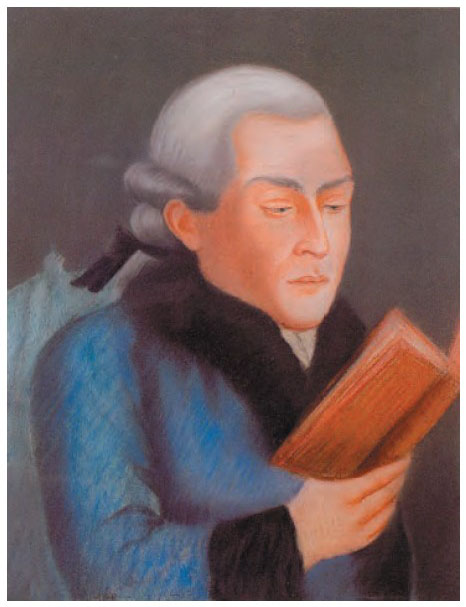
Fig. 1a. Jacques-André Mallet (1740--1790), founder of Geneva Observatory (1772), (Wikipedia)
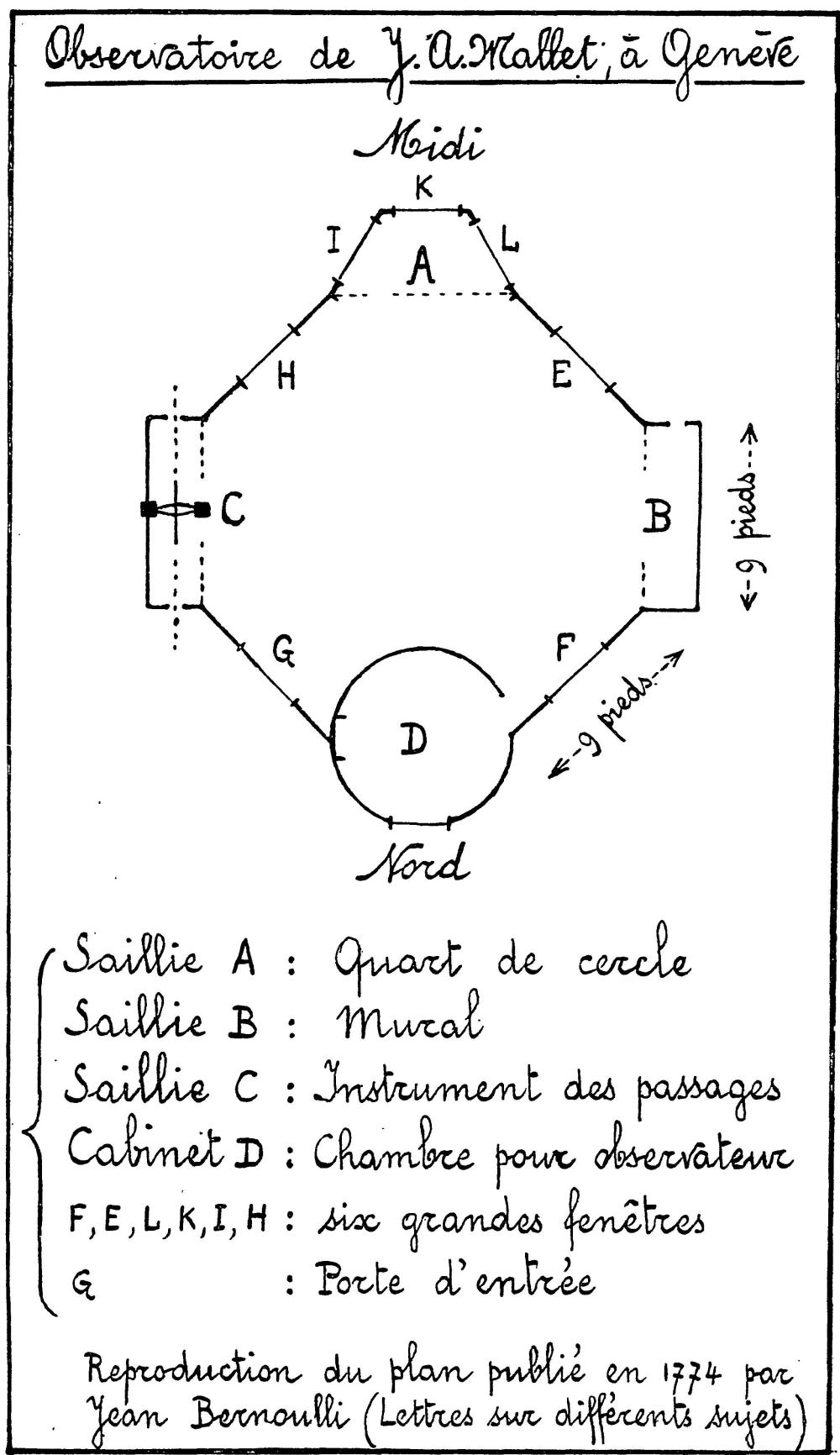
Fig. 1b. Mallet’s Geneva Observatory (1772), (Gautier & Tiercy, 1930)
Astronomical research in Geneva benefits from a long and rich tradition. In 1772, the first Swiss observatory was founded in Geneva under the direction of Jacques-André Mallet (1740--1790), mathematician and astronomer. He studied at the Académie de Genève and was a student of the mathematician Louis Necker (1730--1804). Then Mallet studied at the University of Basel with Daniel Bernoulli (1700--1782) from 1760 to 1762. With his brother-in-law Jean-Louis Pictet (1739--1781) he was a participant in the Venus Transit expedition (1769), initiated by Tsarina Catherine II, in which also the famous scientists Maximilian Hell (1720--1792), Jeremiah Dixon (1733--1779), William Bayly (1737--1810), Anders Hellant (1717--1789), and Anders Planman (1724--1803 ) participated.
In 1771, Mallet, honorary professor at the Académie de Genève, asked the council of Geneva for permission to build an observatory on the city fortification -- at his own expense. Mallet, director since 1772, and his assistants Marc-Auguste Pictet (1752--1825) and Jean Trembley (1749--1811), made numerous observations of sunspots, solar (May 12, 1706) and lunar eclipses, the moons of Jupiter, occultations of a star by the Moon, the motions of planets and comets. Another focus of Geneva Observatory was on meteorological observations and timekeeping. The most importatnt objective was to determine the exact time for the Geneva watchmakers. Since 1790, the observatory held chronometer competitions.
In 1786, Mallet decided to bring his instruments to his country house in Avully and to set up a comfortable private observatory there.
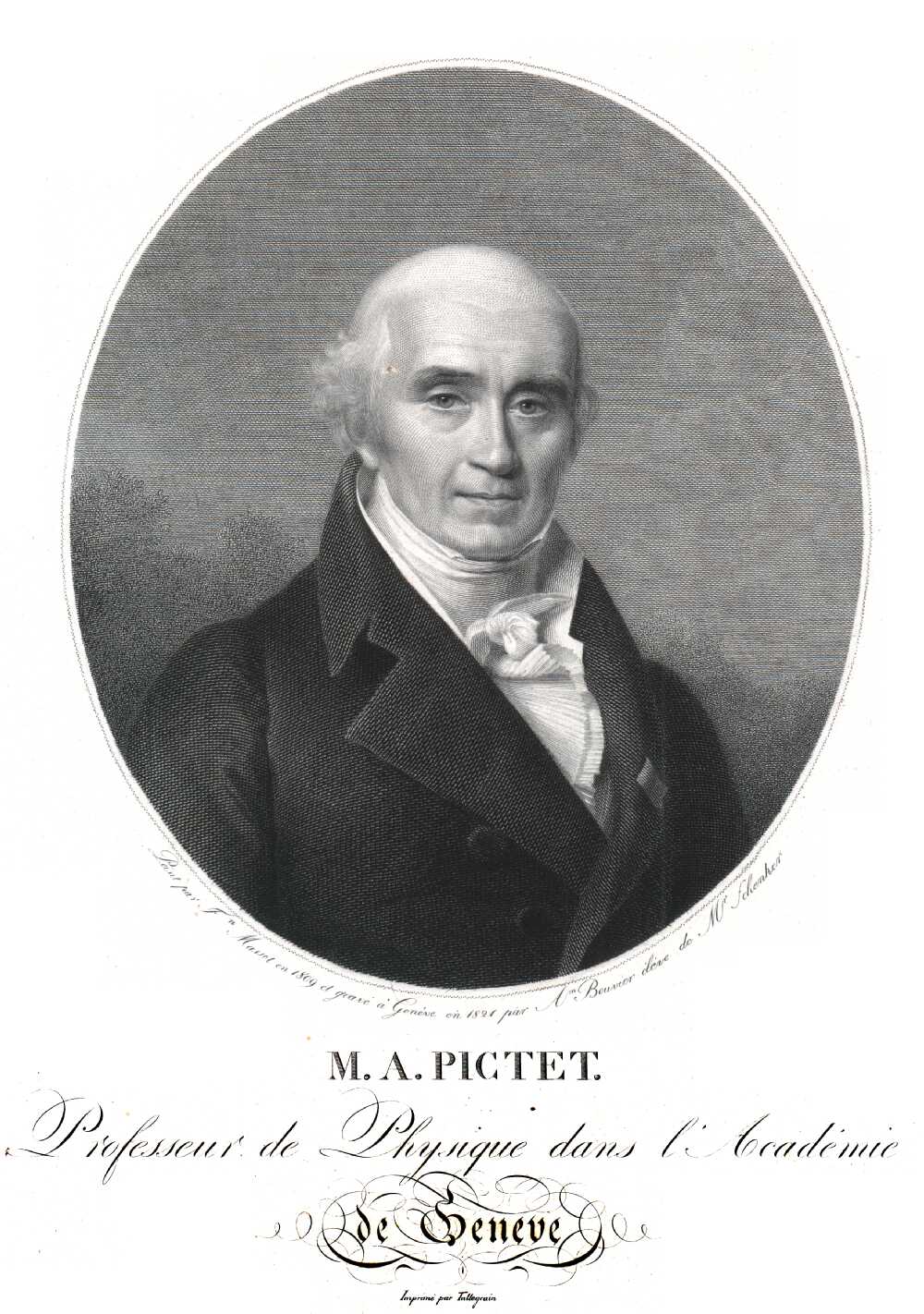
Fig. 2. Marc-Auguste Pictet (1752--1825), (Wikipedia)
Marc-Auguste Pictet (1752--1825) studied at the Geneva Academy and in England, especially astronomy. He was enthusiastic about meteorology and accompanied Professor Horace-Bénédict de Saussure (1740--1799) on his expeditions concerning hypsometry (barometric altitude measurement). In 1817, he founded an observatory on the Great St. Bernhard. From 1786 to 1825 Pictet was a professor for natural philosophy (physics and chemistry) at the Geneva Academy. In addition, he was elected member of many academies.
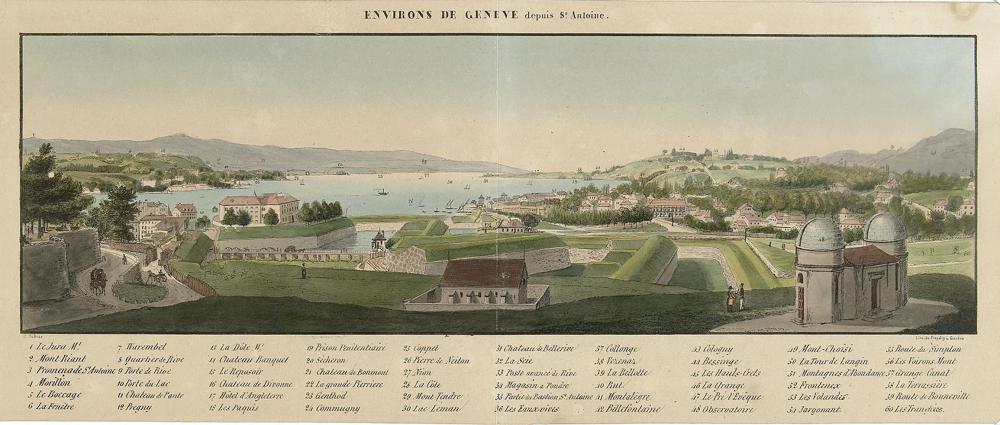
Fig. 3a. The second Geneva Observatory with two domes and the meridian slit on Bastion de Saint-Antoine (1830), Geneva view taken from Saint-Antoine, Rive quartier, Les Eaux-Vives quartier (J. Dubois (fl. 1789--1849); Jacques Freydig, watercolored lithograph, © Bibliothèque de Genève)
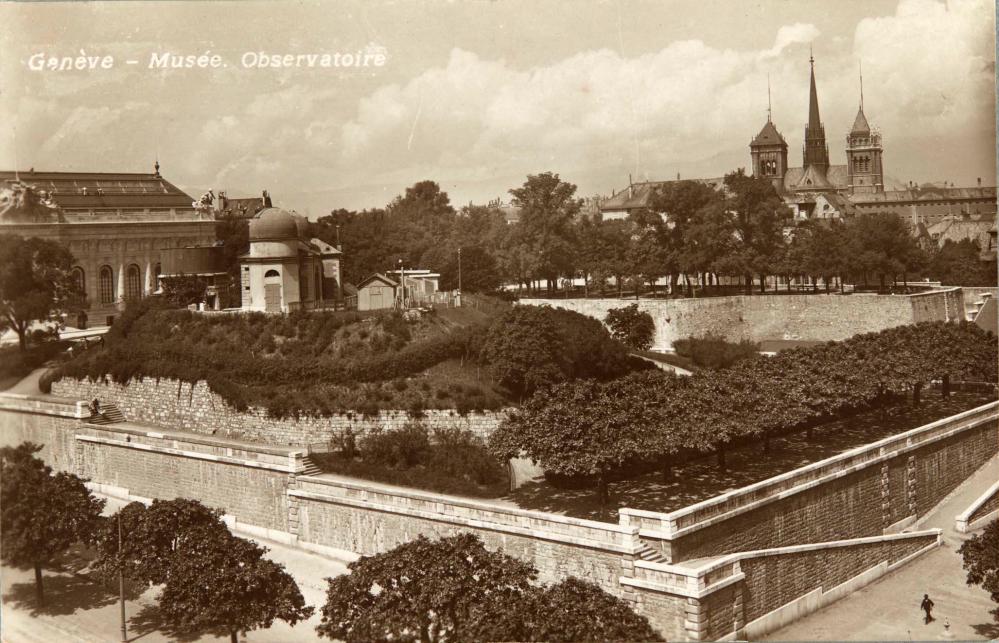
Fig. 3b. The second Geneva Observatory with two domes and the meridian slit on Bastion de Saint-Antoine (1830), to the left the Musée d’Art et Histoire, to the right the Cathedral St. Pierre
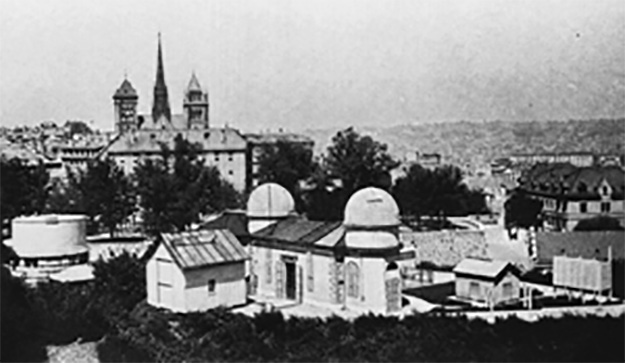
Fig. 3c. The second Geneva Observatory with two domes and the meridian slit on Bastion de Saint-Antoine (1830), in the background Cathedral St. Pierre (photographed in 1930 at the centennial, https://www.unige.ch/sciences/astro/en/services/presentation/)
In 1830, Jean Alfred Gautier (1793--1881) organized the erection of a second Geneva Observatory on Bastion de Saint-Antoine, 70m from the old one. He took part in the changeover from true solar time to mean solar time for civilian life in Geneva in 1821.
After reading the work of Rudolf Wolf (1816--1893) and Johann von Lamont (1805--1879), he was a co-discoverer in noticing the correlation between the cycle of sunspot activity with the variation of the earth’s magnetic field.
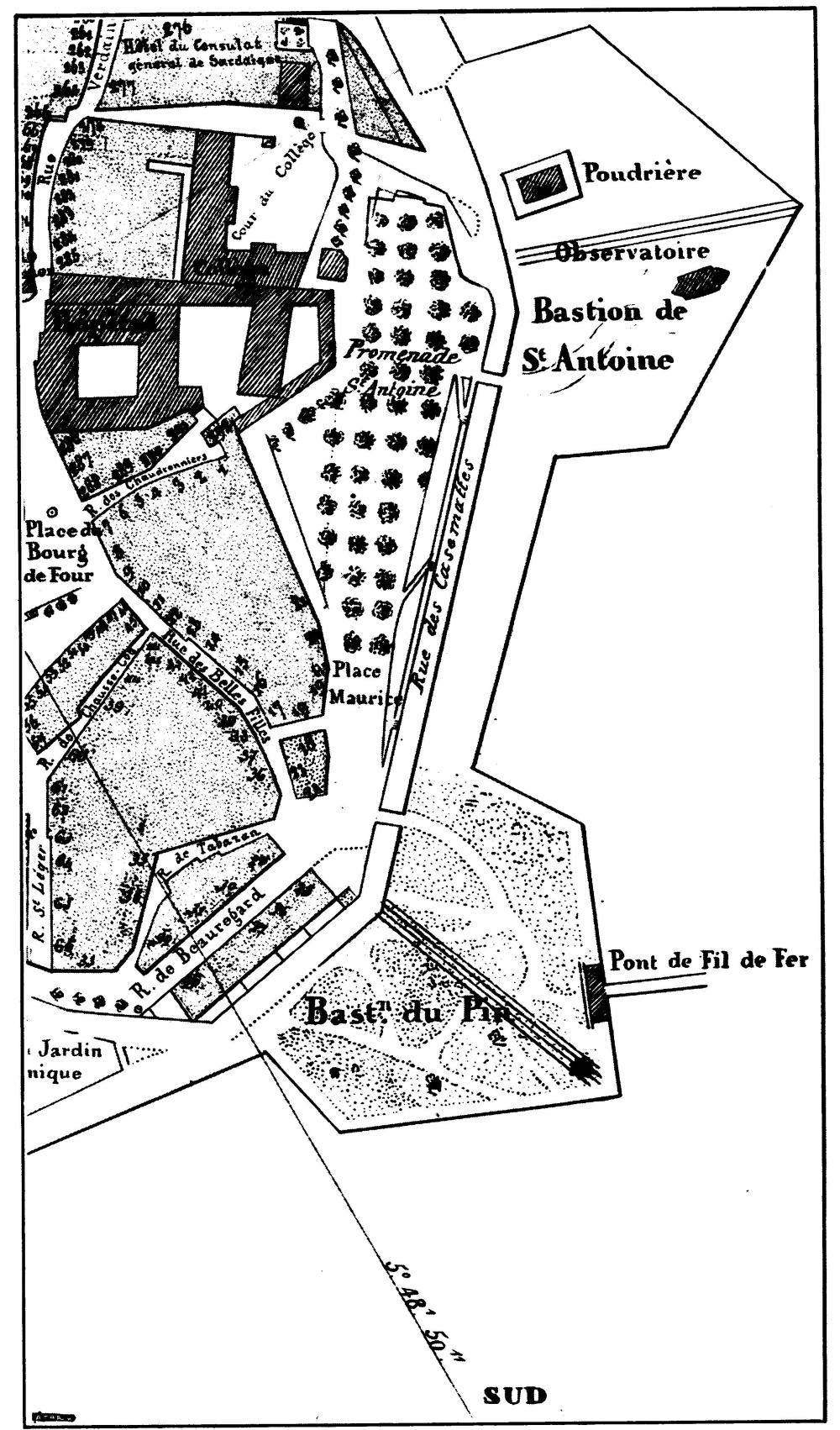
Fig. 3d. Second Geneva Observatory on Bastion de Saint-Antoine (1830), (Gautier & Tiercy, 1930)
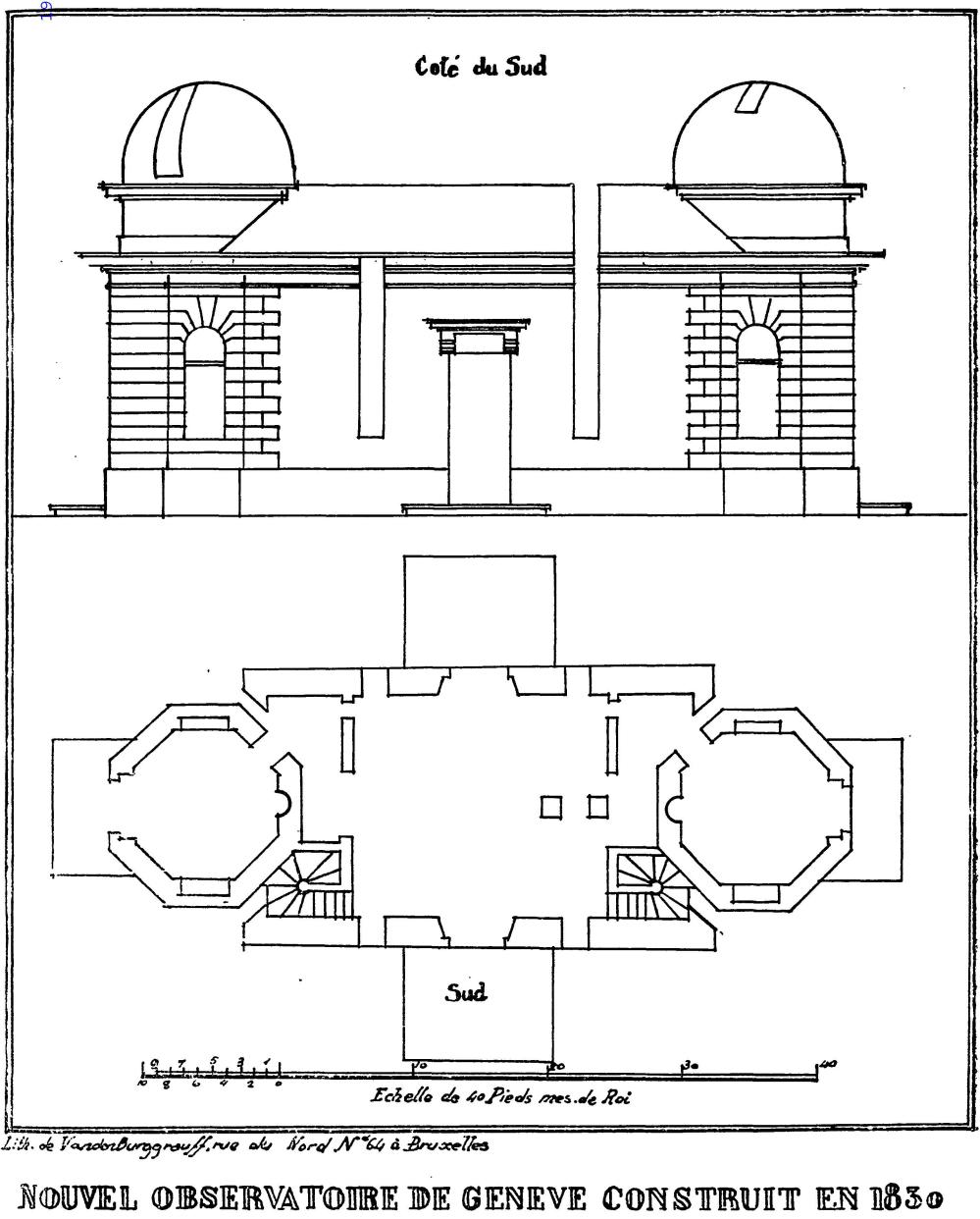
Fig. 3e. Geneva Observatory on Bastion de Saint-Antoine (1830), (Gautier & Tiercy, 1930)
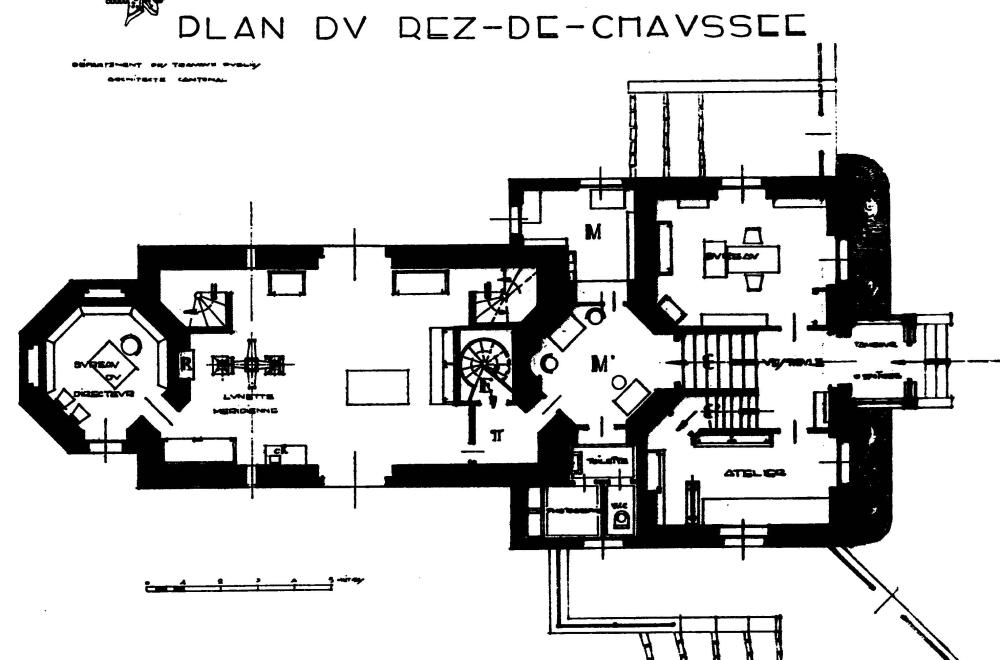
Fig. 3f. Geneva Observatory on Bastion de Saint-Antoine (1830), ground floor (Gautier & Tiercy, 1930)
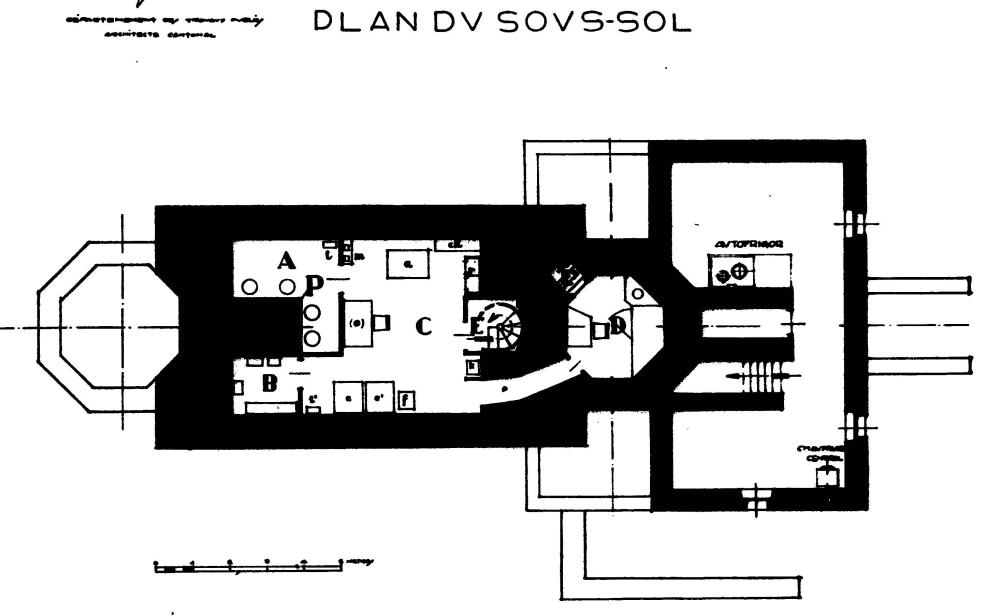
Fig. 3g. Geneva Observatory on Bastion de Saint-Antoine (1830), cellar with the clocks (Gautier & Tiercy, 1930)
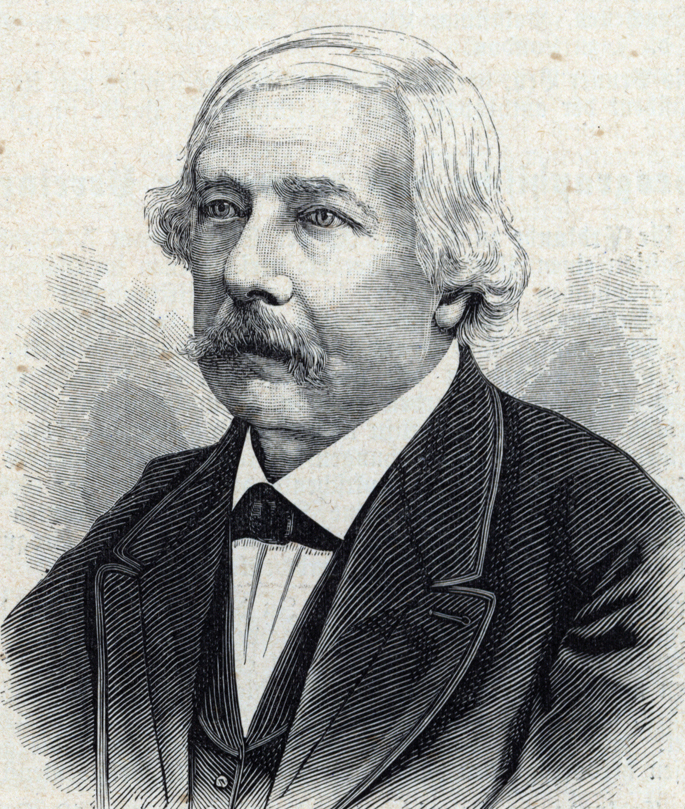
Fig. 4. Émile Plantamour (1815--1882), (Wikipedia)
One of the most important directors was Émile Plantamour (1815--1882), who studied at the Geneva Academy with Alfred Gautier as professor since 1833. He first went to Paris and was Arago’s assistant from 1835 to 1837. In 1837, he moved on to Königsberg zu Bessel, where he received his doctorate in 1838 with a thesis on methods for calculating comet orbits. Finally visited in winter 1838/39 Encke in Berlin, and finally Gauss in Göttingen - with a recommendation from Humboldt.
Thus, best educated, his main interest was comet observations and calculations (Mauvais and Biela), using his own 10-inch-refractor. In addition, he was interested in chronometry, meteorology, barometric altitude measurement, and geodesy. Under his leadership, the observatory built a laboratory for magnetic observations, enlarged the main building in 1878, and established a new ’tower’ for a new equatorial in 1880. Finally, he took over five astronomical stations -- in cooperation within the framework of the "Europäische Gradmessungskommission" (European Arc Measurement Commission 1867, "International Geodetic Association",1886). He measured the longitude difference to the Neuchâtel Observatory and to the Federal Observatory in Zürich -- transmitted through telegraphic signals.
The Geneva Observatory prices in 1872 Vacheron Constantin watches due for their high quality. In the chronometer competition of the Geneva Observatory, Schoof got the second place with one of his instruments in 1884.
In 1969, the old Geneva Observatory was demolished after the new "Observatoire de Genève" in Versoix, built in 1967, went into operation. Today, on the old site is the Parc de l’Observatoire.
History - InfoTheme: Astronomy from the Renaissance to the mid-twentieth century
Entity: 212
Subentity: 1
Version: 8
Status: PUB
Date: 2022-03-15 19:27:23
Author(s): Gudrun Wolfschmidt
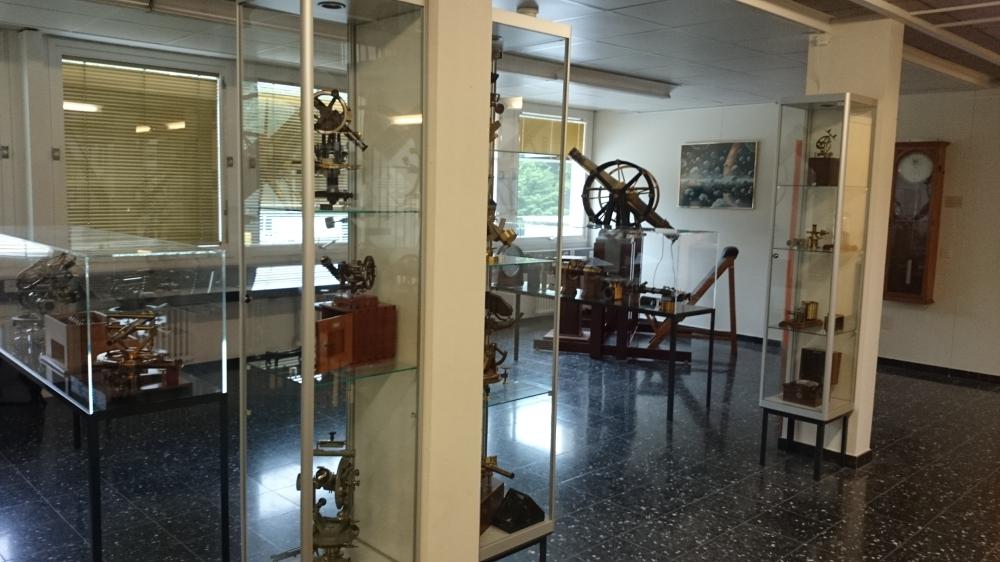
Fig. 4. Instruments of Geneva Observatory, now in the Musée d’Art et d’Histoire (Photo: Ricardo Barbosa)
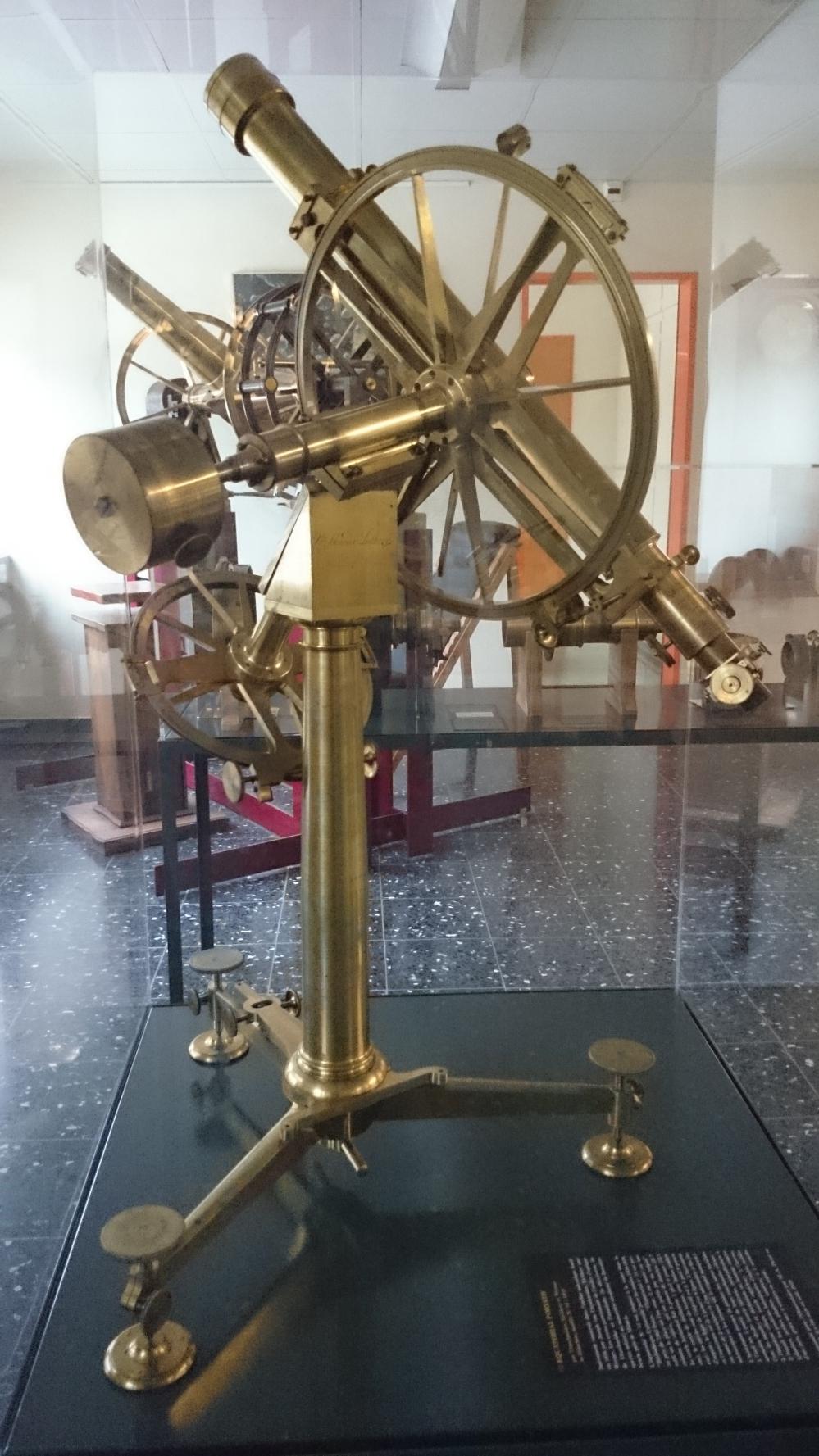
Fig. 5a. Portable equatorial refractor, Utzschneider, Fraunhofer & Werner (1810) (Photo: Ricardo Barbosa)
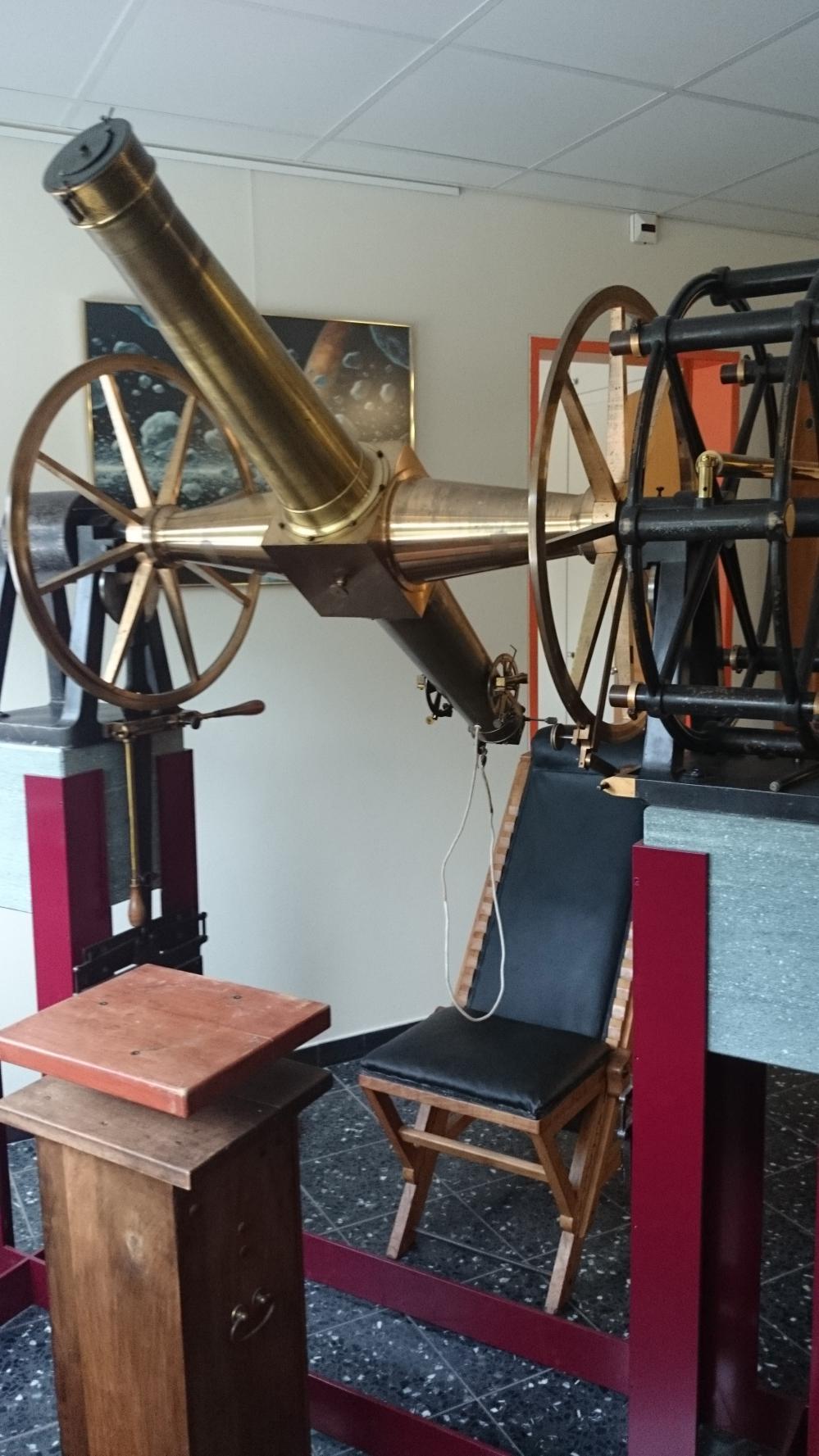
Fig. 5b. Meridian circle, Gambey of Paris (1829), electrical illumination added in 1894 (Photo: Ricardo Barbosa)
Instruments of Geneva Observatory, now in the Musée d’Art et d’Histoire
- Quadrant, 2½ ft, Jean Sisson of London
- Méridienne telescope, 4 ft, Jean Sisson of London
- Quadrant, Butterfield of Paris
- Telescope, 3 ft
- 92-mm-Achromatique Telescope, 10 ft, Dollond of London
- Large cross wire Micrometer
- Precision pendulum clock - Pendule Lepaute.
- 4 Theodolits, 2 Sextants
- Telescope 56cm, Ramsden of London (1787), acquired by Pictet
- Telescope 21cm/8-inch, 30-inch focal length, Ramsden of London (1787), acquired by Pictet
- Repetion circle and a Reflecting circle
- 20-inch Repetion circle, Gambey (1831)
- Portable equatorial refractor, Utzschneider, Fraunhofer & Werner (1810)
- 10.2-cm-Meridian circle, Gambey of Paris (1829), electrical illumination added in 1894, with an unpersonel micrometer (1927)
- 4 Precision pendulum clocks - Pendule Hess 1 (1930) and Hess-Zibach (1930), Pendule Zénith (1930), Pendule Leroy & Gutkaes (1930)
- Meteorological instruments: self-registering anemometer, donated by Emile Gautier (1889), self-registering barometer, Rédier, donated by Philippe Plantamour (1883).
- 10.2-cm-Equatorial refractor, Henry-Prudence Gambey of Paris (1829/31), new objective Merz of Munich (1852),
restored in 1930 and electric drive, used with a spectroscope à vision directe, Hoffmann, donated by Emile Gautier (1871, 1883)
- 5 Precision pendulum clocks - Kutter (1876, modernized in 1929), Favarger (1900, modernized in 1930), Shelton (1777, modernized in 1930), École de l’horlogerie (1900), Riefler (1902) - all clocks mounted with second contacts
- 2 Marine Chronometers, Nardin (1900, 1926)
- 3 secondary pendulum clocks - Arnold & Dent, Gutkaes, Baridon
- 4 Chronographes, Favag (Hipp), two old ones modernized, and 1926, 1929
- 10-cm-Seeker, equatorial mounting, Fraunhofer of Munich (1841), drive added in 1929,
and a 8-cm-photo camera (f=60cm), Carl Zeiss of Jena (1905)
- 6-cm-Altazimuth, Société genevoise d’Instruments de Physique (1876), donated by Alexandre Prevost-Martin,
modernized in 1929/30, new objective, Koristka of Milan
- 10-inch-Equatorial Refractor, acquired by Plantamour (1878/79),
new 27-cm-objective (3.95m focal length), Merz of Munich,
2-prism-spectroscope donated by Alfred Gautier, modernized in 1927/28,
two cameras added: 20-cm-objective, Emile Schaer, and 16-cm-objective, Boulenger, with an 11-cm-objective prism,
new finder (16-cm-objective, 2.3-m-focal length), donated by Emile Schaer (1929)
- 1-m-Reflector, donated by Emile Schaer (1922), mounted in Pavilion Schaer (later in Jungfraujoch)
with two seekers, one with 16-cm-objective (f=2.3m), (1929)
- Six-Prism-Spectrographe, donated by Emile Schaer (1928)
- 2 Prisms (18cm, 60° and 30°), donated by Emile Schaer (1929)
- Spectrocomparator, Société genevoise d’Instruments de Physique, donated by Société Académique de Genève (1928)
- 1-m-Reflector, donated by Emile Schaer (1927), Jungfraujoch
- 60-cm-Reflector, donated by Emile Schaer (1929), Jungfraujoch
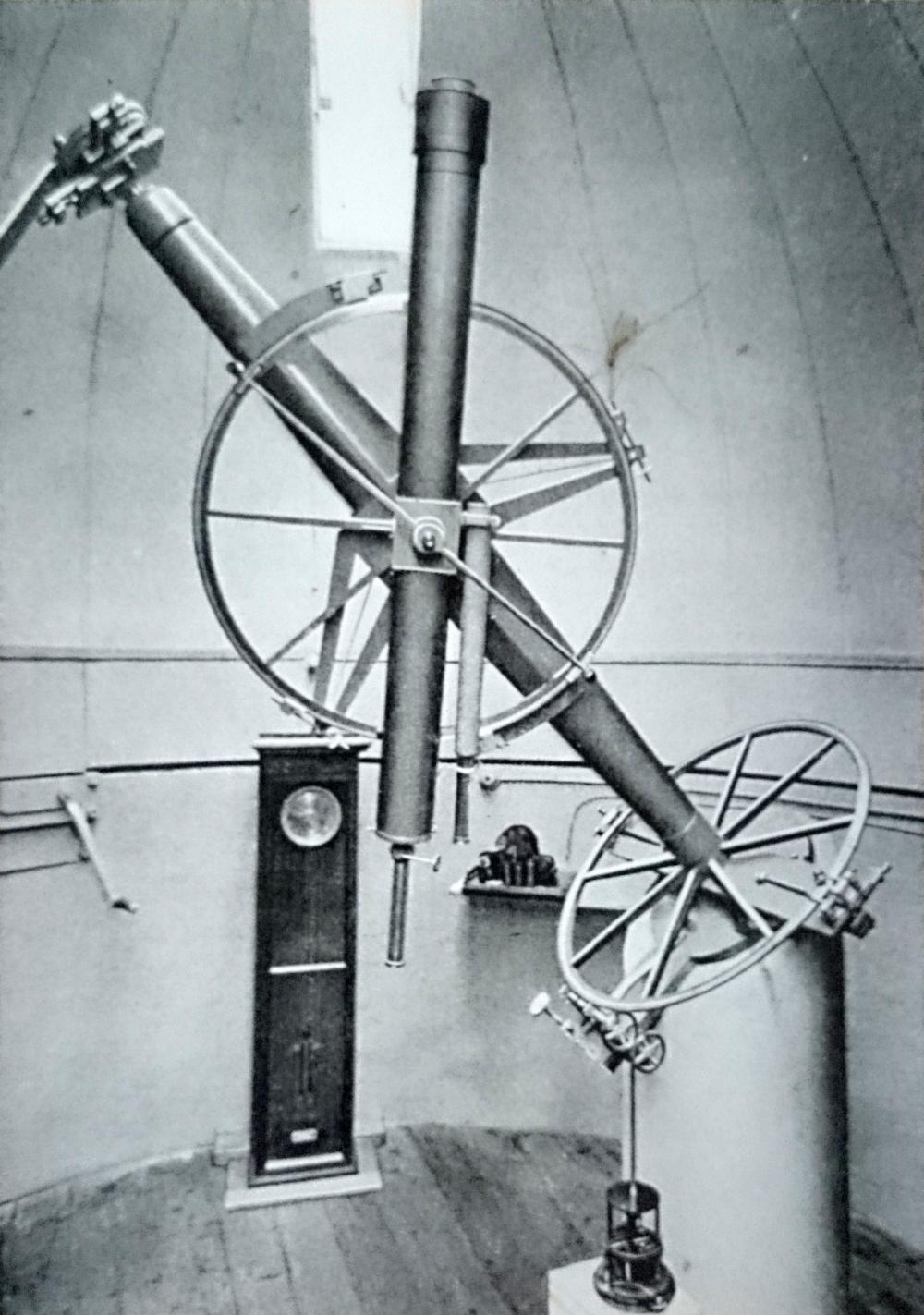
Fig. 6a. Equatorial, Gambey of Paris (1829/31), pendulum clock, Gutkaes (Photo: Ricardo Barbosa)
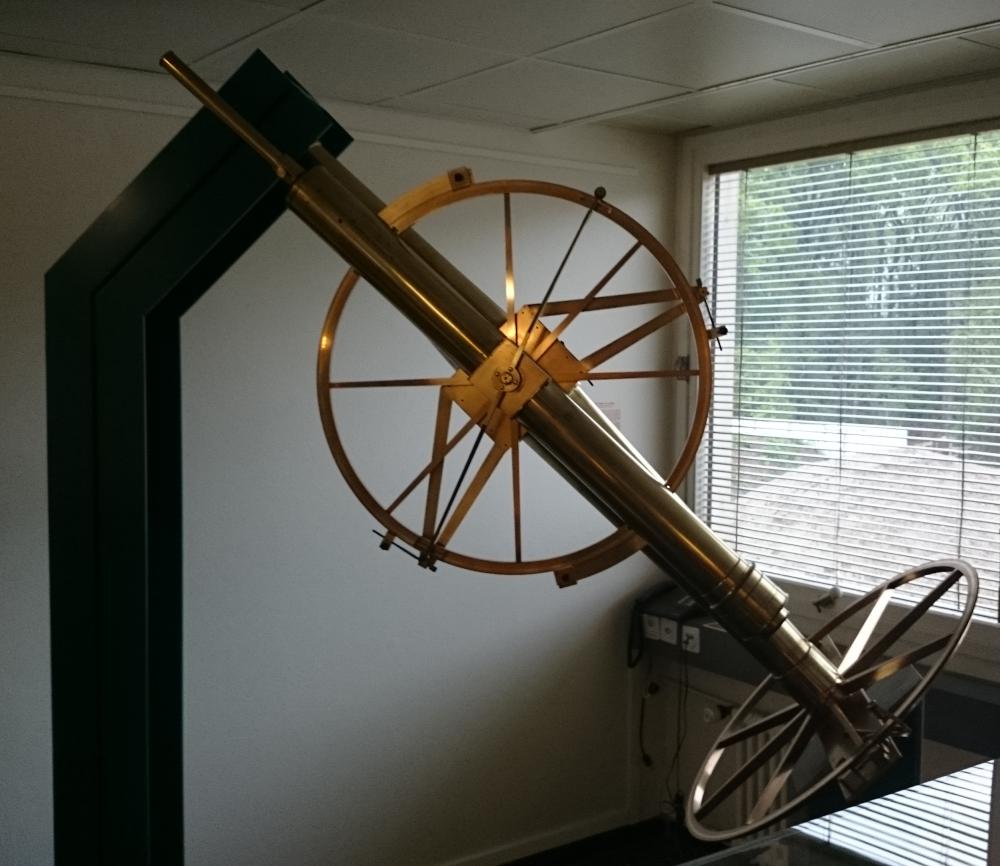
Fig. 6b. Equatorial, Gambey of Paris (1829/31) (Photo: Ricardo Barbosa)
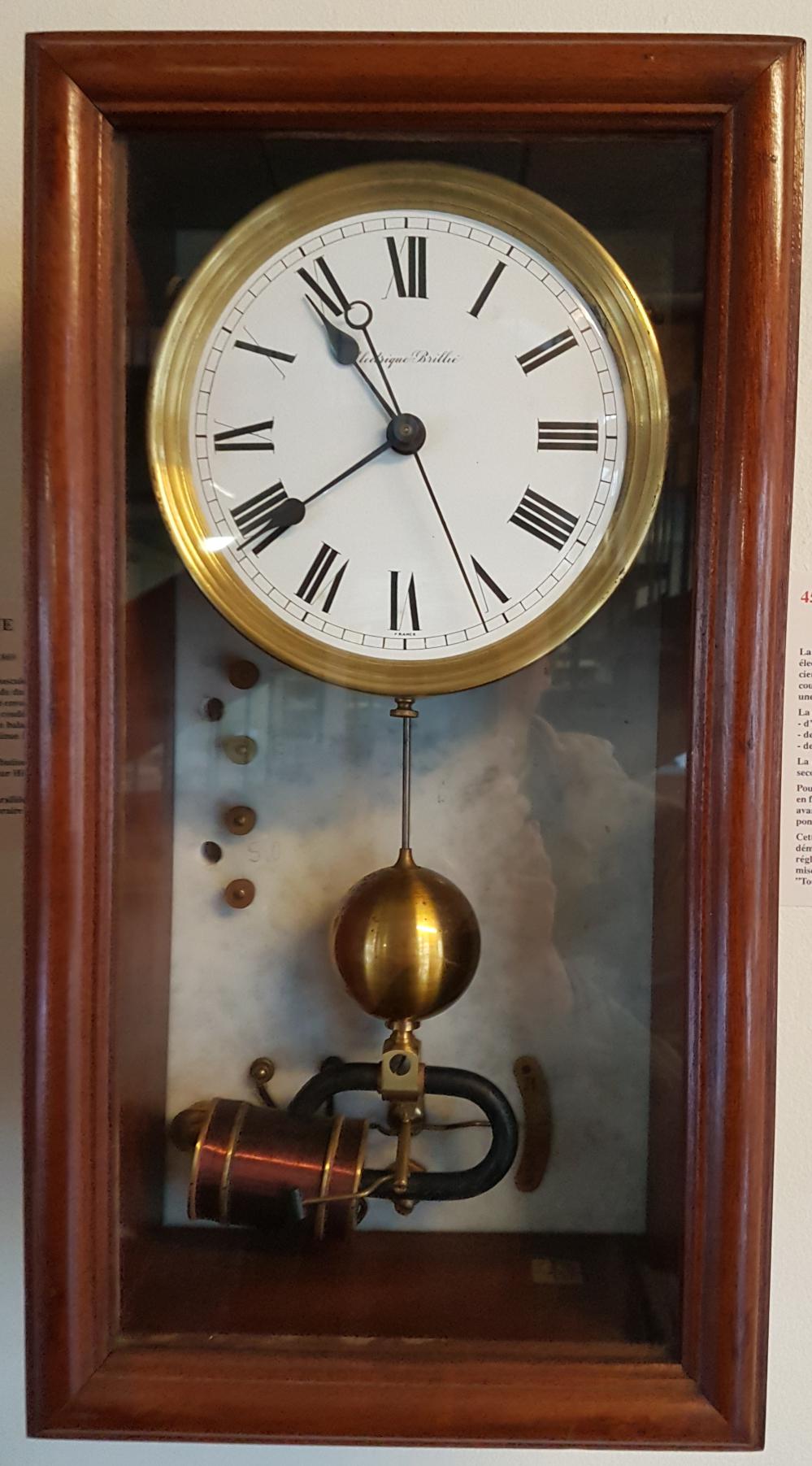
Fig. 6c. Matthaeus Hipp, Neuchâtel (1885), (Photo: Ricardo Barbosa)
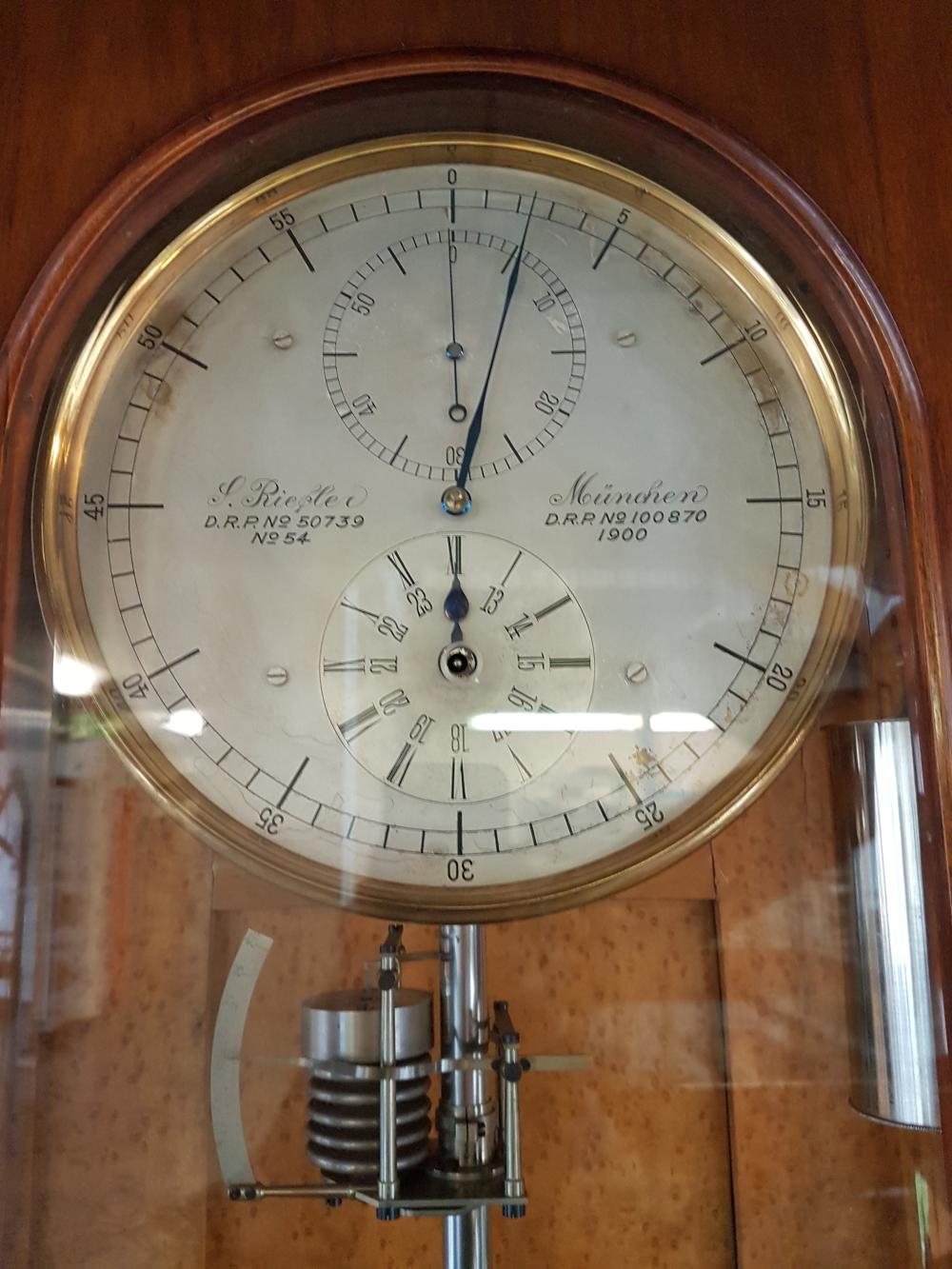
Fig. 6d. S. Riefler, No. 54 (1900) was placed in the meridian room, (Photo: Ricardo Barbosa)
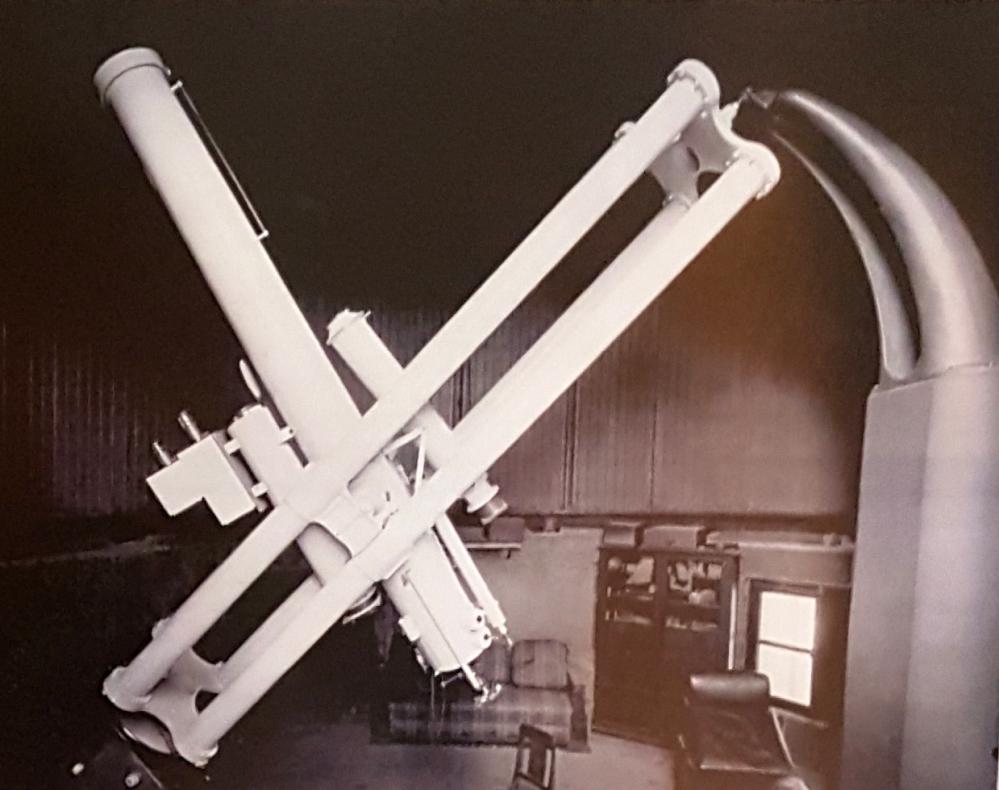
Fig. 7a. 10-inch-Equatorial, , acquired by Plantamour (1878) (Photo: Ricardo Barbosa)
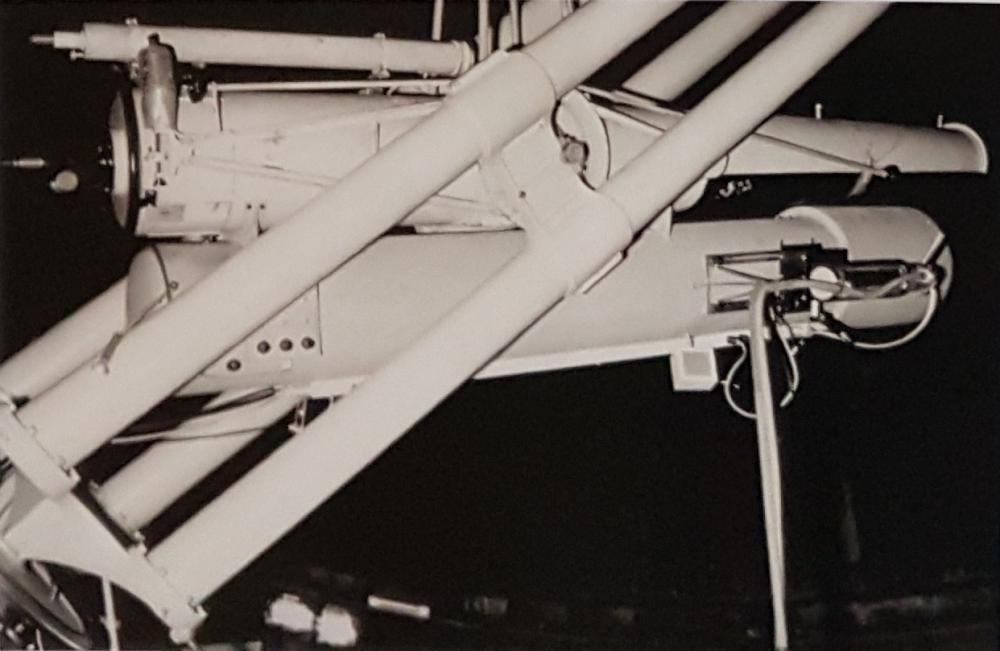
Fig. 7b. 16-cm-Boulenger-camera with objective lens prism under the Equatorial Plantamour (1878) (Photo: Ricardo Barbosa)
Directors of Geneva and Versoix Observatory
- Jacques-André Mallet (1740--1790), 1772 to 1790
- Marc Auguste Pictet (1752--1825), 1790 to 1819
- Jean Alfred Gautier (1793--1881), 1819 to 1839
- Émile Plantamour (1815--1882), 1839 to 1882
- Étienne Alfred Émile Gautier (1822--1891), 1883 to 1889
- Raoul Gautier (1854--1931), 1889 to 1927
- Georges Tiercy (1886--1955), 1928 to 1956
- Marcel Jules Edouard Golay (1927--2015), 1956 to 1992
- André Maeder, 1992 to 1998
- Michel Gustave Édouard Mayor (*1942), 1998 to 2004
- Gilbert Burki, 2004 to 2010
- Stéphane Udry, 2010 to 2019
- Francesco Pepe, since 2019.

Fig. 8a. Directors of Geneva Observatory (Photo: Ricardo Barbosa)
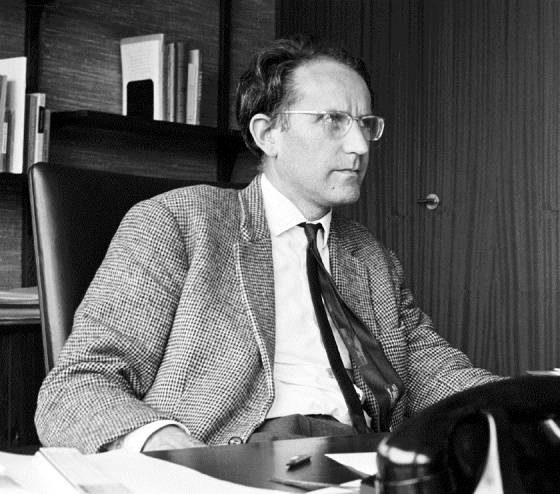
Fig. 8b. Marcel Jules Edouard Golay (1927--2015), director from 1956 to 1992, moved the Geneva Observatory in 1967 to the new site in Versoix (Wikipedia)
State of preservation - InfoTheme: Astronomy from the Renaissance to the mid-twentieth century
Entity: 212
Subentity: 1
Version: 3
Status: PUB
Date: 2021-11-05 13:54:42
Author(s): Gudrun Wolfschmidt
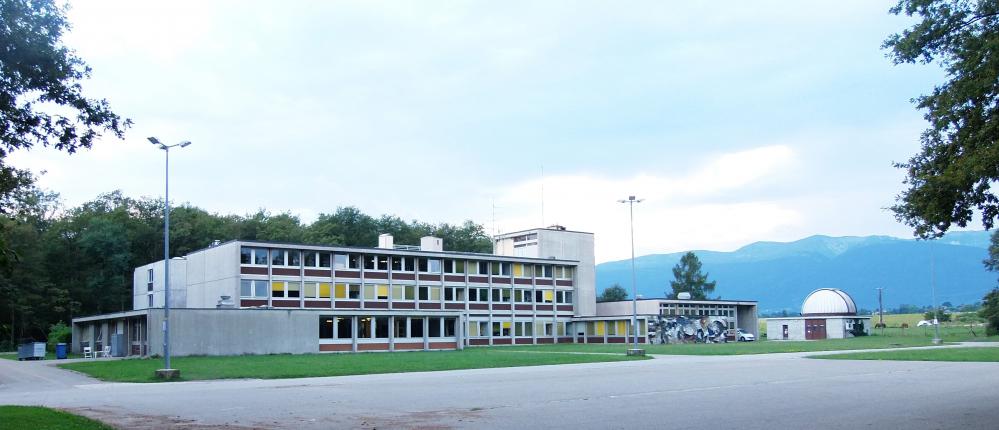
Fig. 9. Observatoire astronomique de l’Université de Genève (OAUG), new building in Sauverny near Versoix, erected in 1967 (Wikipedia, CC3, Adrien Coffinet dit SenseiAC)
The observatory, built in 1772, and the second observatory on the Bastion St. Antoine, built in 1830, are no longer existing in Geneva. This bastion was at the extreme limit of the city facing the deep night of a countryside without light. But after the destruction of the fortifications in the 1850s, the dazzling construction of new neighborhoods and the advent of electric light, the observatory found itself surrounded by city lights and poorly placed for viewing the sky.
Thus, the observatory on the Bastion St. Antoine in Geneva was demolished in 1969 after the commissioning of the new Geneva observatory in n Sauverny near Versoix, erected in 1967. The site is now replaced by the Parc de l’Observatoire -- leveled and planted with trees in 1909.
Comparison with related/similar sites - InfoTheme: Astronomy from the Renaissance to the mid-twentieth century
Entity: 212
Subentity: 1
Version: 3
Status: PUB
Date: 2021-10-25 22:28:18
Author(s): Gudrun Wolfschmidt
The second Geneva Observatory with two domes and the meridian slit on Bastion de Saint-Antoine (1830) reminds of the old
Munich-Bogenhausen Observatory (1817), Hamburg Millerntor Observatory (1825), and the old Brussels Observatory in Saint-Josse-ten-Noode (1826).
Threats or potential threats - InfoTheme: Astronomy from the Renaissance to the mid-twentieth century
Entity: 212
Subentity: 1
Version: 2
Status: PUB
Date: 2021-10-25 22:28:41
Author(s): Gudrun Wolfschmidt
--
Present use - InfoTheme: Astronomy from the Renaissance to the mid-twentieth century
Entity: 212
Subentity: 1
Version: 2
Status: PUB
Date: 2021-10-25 22:29:01
Author(s): Gudrun Wolfschmidt
The building of the observatory is no longer existing in Geneva.
Astronomical relevance today - InfoTheme: Astronomy from the Renaissance to the mid-twentieth century
Entity: 212
Subentity: 1
Version: 2
Status: PUB
Date: 2021-10-25 22:29:32
Author(s): Gudrun Wolfschmidt
The old observatory is no longer existing in Geneva since the 1969. But an active new observatory was built outside of the city.
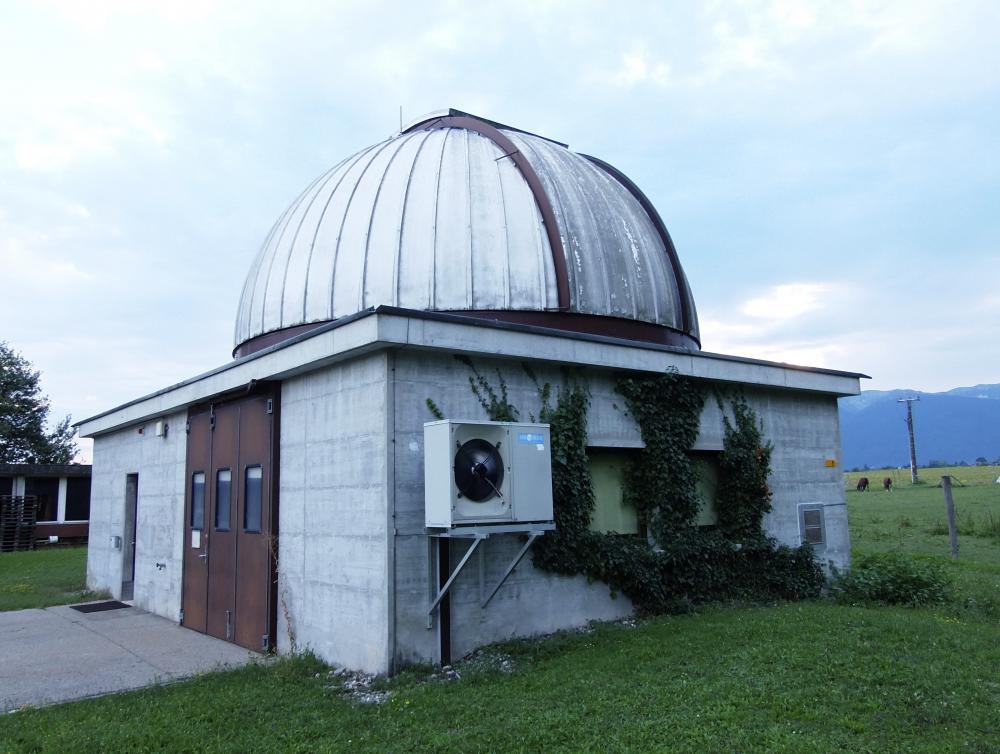
Fig. 10. First Dome of the Observatoire astronomique de l’Université de Genève (OAUG) in Sauverny near Versoix (Wikipedia, CC3, SenseiAC)
The new Geneva Observatory -- Observatoire astronomique de l’Université de Genève (OAUG, IAU Code 517) -- developed since 1967 under the direction of Marcel Golay with the new building in Sauverny near Versoix (46°11’59’’ N, 6°09’08’’ E), and the 1-m-reflecting telescope on the premises of the Observatoire de Haute-Provence (OHP) in France to become the largest Swiss observatory. Besides Haute-Provence Geneva has observing station in La Silla and Paranal (ESO) in Chile (1.2-m-telescope), El Roque de los Muchachos on La Palma in the Canary Islands, Spain, and as well aboard several astronomical satellites, e.g. HIPPARCOS, GAIA, COROT (seismology and planetary transits), INTEGRAL (Gamma Ray), PLANCK (cosmology), and SIM (interferometry).
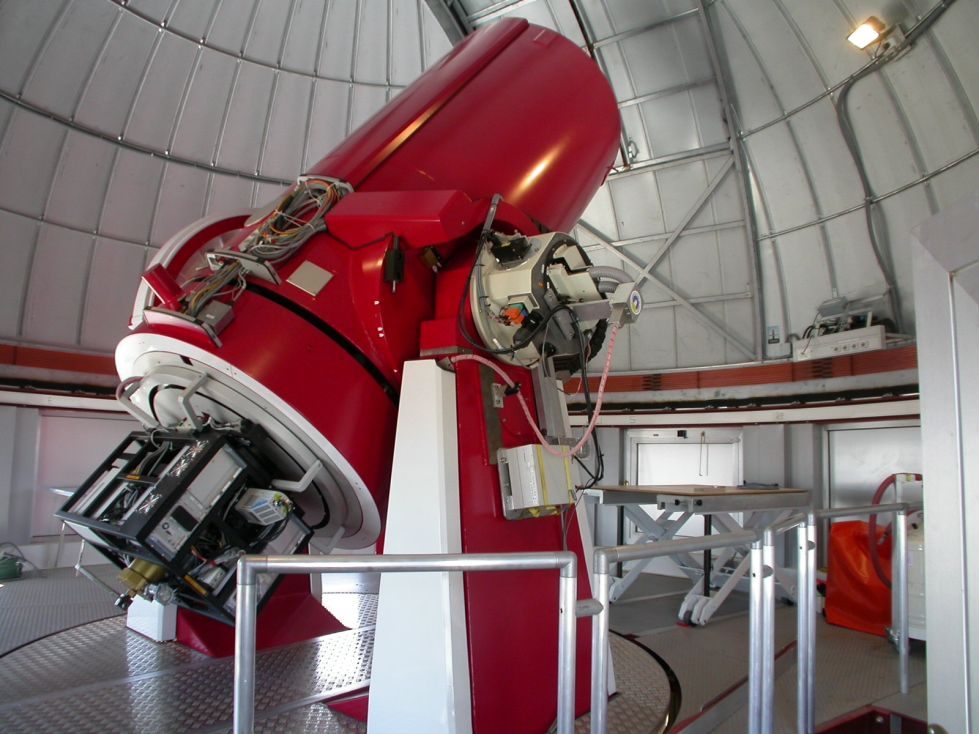
Fig. 11. 120cm-Telescope in La Silla, Chile (ESO), (© OAUG)
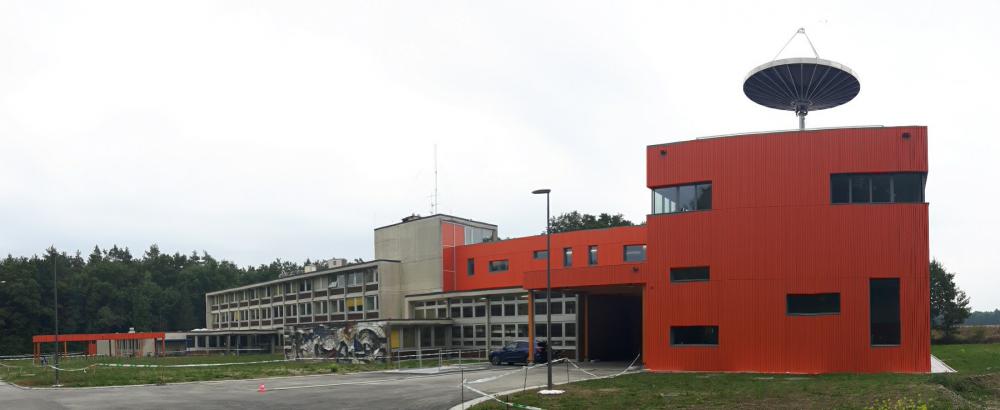
Fig. 12. The Geneva Observatory in Sauverny, including the new "AstroTech" building on the right (Wikipedia, CC3, Adrien Coffinet dit SenseiAC)
The Geneva Observatory houses both the university’s astronomy department Geneva (Geneva Observatory) and the "Laboratoire d’Astrophysique de l’EPFL". The "Integral Science Data Center" (ISDC) is located in Ecogia (municipality of Versoix), which is connected to the Geneva Observatory and deals with the analysis of the data supplied by the "INTEGRAL (INTErnational Gamma Ray Astrophysic Laboratory)" satellite of the European Space Agency (ESA), cf. Projects.
The Highlight in the History of Geneva Observatory:
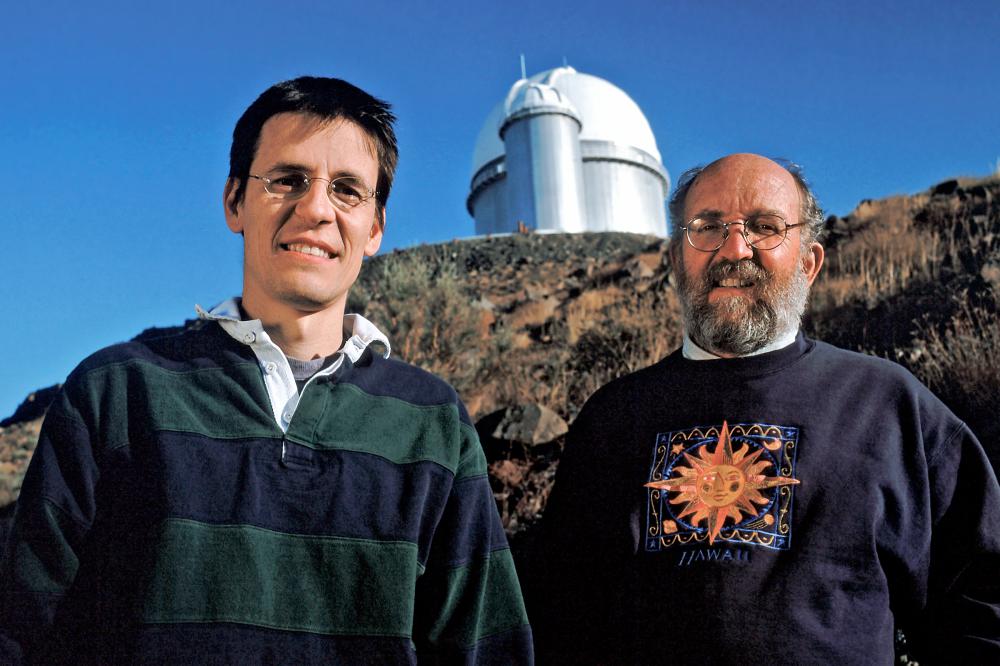
Fig. 13a. Michel Mayor and Didier Queloz in La Silla (2012), (© ESO)
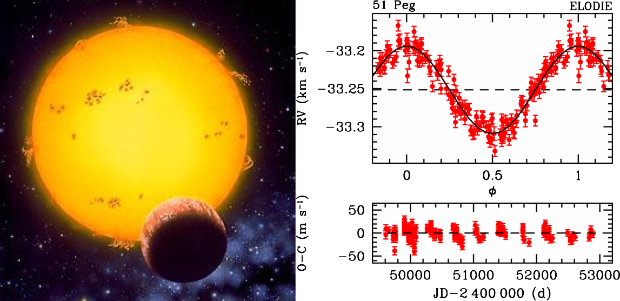
Fig. 13b. Michel Mayor and Didier Queloz: 51 Peg and radial velocity curve (© OAUG)
Michel Mayor and Didier Queloz got the Nobel Prize in Physics (2019) for the discovery of the first planet outside our Solar system, named 51 Pegasi b, this very first exoplanet.
References
Bibliography (books and published articles) - InfoTheme: Astronomy from the Renaissance to the mid-twentieth century
Entity: 212
Subentity: 1
Version: 3
Status: PUB
Date: 2021-11-05 14:01:22
Author(s): Gudrun Wolfschmidt
- Buchs, Armand: Raoul Gautier. In: HLS -- Historisches Lexikon der Schweiz (03.07.2007),
(https://hls-dhs-dss.ch/de/articles/028833/2007-07-03/).
- Faye, Hervé: Comptes rendus hebdomadaires des séances de l’Académie des sciences / publiés ... par MM. les secrétaires perpétuels. In: Gallica (January 1880), p. 1465.
- Gautier, Raoul & Georges Tiercy: L’Observatoire de Genève, 1772--1830--1930. In: Publications of the Observatoire Geneve Series A, vol. 12 (1930), p. B3--B170.
- Golay, Marcel: Jacques-André Mallet. In: HLS -- Historisches Lexikon der Schweiz (25.08.2008),
(https://hls-dhs-dss.ch/de/articles/026055/2008-08-25/).
- Golay, Marcel: Emile Plantamour. In: HLS -- Historisches Lexikon der Schweiz (25.01.2011),
(https://hls-dhs-dss.ch/de/articles/028912/2011-01-25/).
- Golay, Marcel: Alfred Gautier. In: HLS -- Historisches Lexikon der Schweiz (17.10.2003),
(https://hls-dhs-dss.ch/de/articles/028831/2003-10-17/).
- Golay, Marcel: Émile Gautier. In: HLS -- Historisches Lexikon der Schweiz (03.07.2007),
(https://hls-dhs-dss.ch/de/articles/028832/2007-07-03/).
- Guyot, Edmond: Le service de l’heure en Suisse. In: Cellular and Molecular Life Sciences. In: Experientia 5 (Octobre 1949), no 10, p. 373-380.
- Hauck, Bernard: Marcel Golay. In: HLS -- Historisches Lexikon der Schweiz (26.06.2015),
(https://hls-dhs-dss.ch/de/articles/043520/2015-06-26/).
- N.N.: J.A. Gautier. In: Monthly Notices of the Royal Astronomical Society 42 (1882), p. 150.
- Sigrist, René: Marc-Auguste Pictet. In: HLS -- Historisches Lexikon der Schweiz ( 18.01.2011),
(https://hls-dhs-dss.ch/de/articles/021593/2011-01-18/).
- Wolf, Rudolf: Geschichte der Vermessung der Schweiz als Historische Einleitung zu dem Arbeiten der schweiz. geodätischen Commission. Zürich: S. Höhr 1879.
Links to external sites - InfoTheme: Astronomy from the Renaissance to the mid-twentieth century
Entity: 212
Subentity: 1
Version: 3
Status: PUB
Date: 2021-11-05 13:53:14
Author(s): Gudrun Wolfschmidt
- Observatory of Geneva, Astronomy Department
- Observatory of Geneva, English version
- Promenade de l’Observatoire
- Physics Nobel prize laureates: Michel Mayor and Didier Queloz: discovery of the first planet outside our Solar system, named 51 Pegasi b, this very first exoplanet.
- Nobel Prize in Physics 2019: Michel Mayor and Didier Queloz
- Observatoire de Genève, Département d’Astronomie de l’Université de Genève, Projects
- Observatory of Geneva, Research
- Observatory of Geneva, Chronometry
- Geneva Observatory (Watch Wiki)
- Observatoire de Genève (Wikipédia)
- Wolf, Rudolf (1879): Kapitel VI. Die Sternwarten in Zürich und Genf. 62. Jacques-Andre Mallet
- Wolf, Rudolf (1879): Kapitel VI. Die Sternwarten in Zürich und Genf. 63. Die erste Sternwarte in Genf
- Observatoire de Genève, Département d’Astronomie de l’Université de Genève, Chemin Pegasi, 51, CH-1290 Versoix, Switzerland
- Solar Physics Historical Timeline (1800--1999)
Links to external on-line pictures - InfoTheme: Astronomy from the Renaissance to the mid-twentieth century
Entity: 212
Subentity: 1
Version: 1
Status: PUB
Date: 2021-10-25 21:29:19
Author(s): Gudrun Wolfschmidt
no information available
PrintPrint contents of 'Description' tab
(opens in a new window) Theme
Astronomy from the Renaissance to the mid-twentieth century
Case Study Navigation
- InfoTheme: Astronomy from the Renaissance to the mid-twentieth century
Entity: 212
Subentity: 1
Version: 2
Status: PUB
Date: 2021-10-25 21:43:54
Author(s): Gudrun Wolfschmidt
Geneva Observatory, Geneva (Genf, Genève) on Bastion de Saint-Antoine, now: Parc de l’Observatoire, Geneva, Switzerland.
The new Geneva Observatory (OAUG, IAU Code 517) (46°11’59’’ N, 6°09’08’’ E) is located since 1967 in a new building in the Sauverny area:
Observatoire astronomique de l’Université de Genève, Chemin Pegasi, 51, 1290 Versoix, Canton of Geneva, Switzerland
Location - InfoTheme: Astronomy from the Renaissance to the mid-twentieth century
Entity: 212
Subentity: 1
Version: 2
Status: PUB
Date: 2021-10-25 22:14:23
Author(s): Gudrun Wolfschmidt
Latitude 46°11’59’’ N, 6°09’08’’ E, Elevation ....m above mean sea level.
IAU observatory code - InfoTheme: Astronomy from the Renaissance to the mid-twentieth century
Entity: 212
Subentity: 1
Version: 1
Status: PUB
Date: 2021-10-25 21:29:18
Author(s): Gudrun Wolfschmidt
189
Description of (scientific/cultural/natural) heritage - InfoTheme: Astronomy from the Renaissance to the mid-twentieth century
Entity: 212
Subentity: 1
Version: 4
Status: PUB
Date: 2021-11-05 17:55:42
Author(s): Gudrun Wolfschmidt

Fig. 1a. Jacques-André Mallet (1740--1790), founder of Geneva Observatory (1772), (Wikipedia)

Fig. 1b. Mallet’s Geneva Observatory (1772), (Gautier & Tiercy, 1930)
Astronomical research in Geneva benefits from a long and rich tradition. In 1772, the first Swiss observatory was founded in Geneva under the direction of Jacques-André Mallet (1740--1790), mathematician and astronomer. He studied at the Académie de Genève and was a student of the mathematician Louis Necker (1730--1804). Then Mallet studied at the University of Basel with Daniel Bernoulli (1700--1782) from 1760 to 1762. With his brother-in-law Jean-Louis Pictet (1739--1781) he was a participant in the Venus Transit expedition (1769), initiated by Tsarina Catherine II, in which also the famous scientists Maximilian Hell (1720--1792), Jeremiah Dixon (1733--1779), William Bayly (1737--1810), Anders Hellant (1717--1789), and Anders Planman (1724--1803 ) participated.
In 1771, Mallet, honorary professor at the Académie de Genève, asked the council of Geneva for permission to build an observatory on the city fortification -- at his own expense. Mallet, director since 1772, and his assistants Marc-Auguste Pictet (1752--1825) and Jean Trembley (1749--1811), made numerous observations of sunspots, solar (May 12, 1706) and lunar eclipses, the moons of Jupiter, occultations of a star by the Moon, the motions of planets and comets. Another focus of Geneva Observatory was on meteorological observations and timekeeping. The most importatnt objective was to determine the exact time for the Geneva watchmakers. Since 1790, the observatory held chronometer competitions.
In 1786, Mallet decided to bring his instruments to his country house in Avully and to set up a comfortable private observatory there.

Fig. 2. Marc-Auguste Pictet (1752--1825), (Wikipedia)
Marc-Auguste Pictet (1752--1825) studied at the Geneva Academy and in England, especially astronomy. He was enthusiastic about meteorology and accompanied Professor Horace-Bénédict de Saussure (1740--1799) on his expeditions concerning hypsometry (barometric altitude measurement). In 1817, he founded an observatory on the Great St. Bernhard. From 1786 to 1825 Pictet was a professor for natural philosophy (physics and chemistry) at the Geneva Academy. In addition, he was elected member of many academies.

Fig. 3a. The second Geneva Observatory with two domes and the meridian slit on Bastion de Saint-Antoine (1830), Geneva view taken from Saint-Antoine, Rive quartier, Les Eaux-Vives quartier (J. Dubois (fl. 1789--1849); Jacques Freydig, watercolored lithograph, © Bibliothèque de Genève)

Fig. 3b. The second Geneva Observatory with two domes and the meridian slit on Bastion de Saint-Antoine (1830), to the left the Musée d’Art et Histoire, to the right the Cathedral St. Pierre

Fig. 3c. The second Geneva Observatory with two domes and the meridian slit on Bastion de Saint-Antoine (1830), in the background Cathedral St. Pierre (photographed in 1930 at the centennial, https://www.unige.ch/sciences/astro/en/services/presentation/)
In 1830, Jean Alfred Gautier (1793--1881) organized the erection of a second Geneva Observatory on Bastion de Saint-Antoine, 70m from the old one. He took part in the changeover from true solar time to mean solar time for civilian life in Geneva in 1821.
After reading the work of Rudolf Wolf (1816--1893) and Johann von Lamont (1805--1879), he was a co-discoverer in noticing the correlation between the cycle of sunspot activity with the variation of the earth’s magnetic field.

Fig. 3d. Second Geneva Observatory on Bastion de Saint-Antoine (1830), (Gautier & Tiercy, 1930)

Fig. 3e. Geneva Observatory on Bastion de Saint-Antoine (1830), (Gautier & Tiercy, 1930)

Fig. 3f. Geneva Observatory on Bastion de Saint-Antoine (1830), ground floor (Gautier & Tiercy, 1930)

Fig. 3g. Geneva Observatory on Bastion de Saint-Antoine (1830), cellar with the clocks (Gautier & Tiercy, 1930)

Fig. 4. Émile Plantamour (1815--1882), (Wikipedia)
One of the most important directors was Émile Plantamour (1815--1882), who studied at the Geneva Academy with Alfred Gautier as professor since 1833. He first went to Paris and was Arago’s assistant from 1835 to 1837. In 1837, he moved on to Königsberg zu Bessel, where he received his doctorate in 1838 with a thesis on methods for calculating comet orbits. Finally visited in winter 1838/39 Encke in Berlin, and finally Gauss in Göttingen - with a recommendation from Humboldt.
Thus, best educated, his main interest was comet observations and calculations (Mauvais and Biela), using his own 10-inch-refractor. In addition, he was interested in chronometry, meteorology, barometric altitude measurement, and geodesy. Under his leadership, the observatory built a laboratory for magnetic observations, enlarged the main building in 1878, and established a new ’tower’ for a new equatorial in 1880. Finally, he took over five astronomical stations -- in cooperation within the framework of the "Europäische Gradmessungskommission" (European Arc Measurement Commission 1867, "International Geodetic Association",1886). He measured the longitude difference to the Neuchâtel Observatory and to the Federal Observatory in Zürich -- transmitted through telegraphic signals.
The Geneva Observatory prices in 1872 Vacheron Constantin watches due for their high quality. In the chronometer competition of the Geneva Observatory, Schoof got the second place with one of his instruments in 1884.
In 1969, the old Geneva Observatory was demolished after the new "Observatoire de Genève" in Versoix, built in 1967, went into operation. Today, on the old site is the Parc de l’Observatoire.
History - InfoTheme: Astronomy from the Renaissance to the mid-twentieth century
Entity: 212
Subentity: 1
Version: 8
Status: PUB
Date: 2022-03-15 19:27:23
Author(s): Gudrun Wolfschmidt

Fig. 4. Instruments of Geneva Observatory, now in the Musée d’Art et d’Histoire (Photo: Ricardo Barbosa)

Fig. 5a. Portable equatorial refractor, Utzschneider, Fraunhofer & Werner (1810) (Photo: Ricardo Barbosa)

Fig. 5b. Meridian circle, Gambey of Paris (1829), electrical illumination added in 1894 (Photo: Ricardo Barbosa)
Instruments of Geneva Observatory, now in the Musée d’Art et d’Histoire
- Quadrant, 2½ ft, Jean Sisson of London
- Méridienne telescope, 4 ft, Jean Sisson of London
- Quadrant, Butterfield of Paris
- Telescope, 3 ft
- 92-mm-Achromatique Telescope, 10 ft, Dollond of London
- Large cross wire Micrometer
- Precision pendulum clock - Pendule Lepaute.
- 4 Theodolits, 2 Sextants
- Telescope 56cm, Ramsden of London (1787), acquired by Pictet
- Telescope 21cm/8-inch, 30-inch focal length, Ramsden of London (1787), acquired by Pictet
- Repetion circle and a Reflecting circle
- 20-inch Repetion circle, Gambey (1831)
- Portable equatorial refractor, Utzschneider, Fraunhofer & Werner (1810)
- 10.2-cm-Meridian circle, Gambey of Paris (1829), electrical illumination added in 1894, with an unpersonel micrometer (1927)
- 4 Precision pendulum clocks - Pendule Hess 1 (1930) and Hess-Zibach (1930), Pendule Zénith (1930), Pendule Leroy & Gutkaes (1930)
- Meteorological instruments: self-registering anemometer, donated by Emile Gautier (1889), self-registering barometer, Rédier, donated by Philippe Plantamour (1883).
- 10.2-cm-Equatorial refractor, Henry-Prudence Gambey of Paris (1829/31), new objective Merz of Munich (1852),
restored in 1930 and electric drive, used with a spectroscope à vision directe, Hoffmann, donated by Emile Gautier (1871, 1883)
- 5 Precision pendulum clocks - Kutter (1876, modernized in 1929), Favarger (1900, modernized in 1930), Shelton (1777, modernized in 1930), École de l’horlogerie (1900), Riefler (1902) - all clocks mounted with second contacts
- 2 Marine Chronometers, Nardin (1900, 1926)
- 3 secondary pendulum clocks - Arnold & Dent, Gutkaes, Baridon
- 4 Chronographes, Favag (Hipp), two old ones modernized, and 1926, 1929
- 10-cm-Seeker, equatorial mounting, Fraunhofer of Munich (1841), drive added in 1929,
and a 8-cm-photo camera (f=60cm), Carl Zeiss of Jena (1905)
- 6-cm-Altazimuth, Société genevoise d’Instruments de Physique (1876), donated by Alexandre Prevost-Martin,
modernized in 1929/30, new objective, Koristka of Milan
- 10-inch-Equatorial Refractor, acquired by Plantamour (1878/79),
new 27-cm-objective (3.95m focal length), Merz of Munich,
2-prism-spectroscope donated by Alfred Gautier, modernized in 1927/28,
two cameras added: 20-cm-objective, Emile Schaer, and 16-cm-objective, Boulenger, with an 11-cm-objective prism,
new finder (16-cm-objective, 2.3-m-focal length), donated by Emile Schaer (1929)
- 1-m-Reflector, donated by Emile Schaer (1922), mounted in Pavilion Schaer (later in Jungfraujoch)
with two seekers, one with 16-cm-objective (f=2.3m), (1929)
- Six-Prism-Spectrographe, donated by Emile Schaer (1928)
- 2 Prisms (18cm, 60° and 30°), donated by Emile Schaer (1929)
- Spectrocomparator, Société genevoise d’Instruments de Physique, donated by Société Académique de Genève (1928)
- 1-m-Reflector, donated by Emile Schaer (1927), Jungfraujoch
- 60-cm-Reflector, donated by Emile Schaer (1929), Jungfraujoch

Fig. 6a. Equatorial, Gambey of Paris (1829/31), pendulum clock, Gutkaes (Photo: Ricardo Barbosa)

Fig. 6b. Equatorial, Gambey of Paris (1829/31) (Photo: Ricardo Barbosa)

Fig. 6c. Matthaeus Hipp, Neuchâtel (1885), (Photo: Ricardo Barbosa)

Fig. 6d. S. Riefler, No. 54 (1900) was placed in the meridian room, (Photo: Ricardo Barbosa)

Fig. 7a. 10-inch-Equatorial, , acquired by Plantamour (1878) (Photo: Ricardo Barbosa)

Fig. 7b. 16-cm-Boulenger-camera with objective lens prism under the Equatorial Plantamour (1878) (Photo: Ricardo Barbosa)
Directors of Geneva and Versoix Observatory
- Jacques-André Mallet (1740--1790), 1772 to 1790
- Marc Auguste Pictet (1752--1825), 1790 to 1819
- Jean Alfred Gautier (1793--1881), 1819 to 1839
- Émile Plantamour (1815--1882), 1839 to 1882
- Étienne Alfred Émile Gautier (1822--1891), 1883 to 1889
- Raoul Gautier (1854--1931), 1889 to 1927
- Georges Tiercy (1886--1955), 1928 to 1956
- Marcel Jules Edouard Golay (1927--2015), 1956 to 1992
- André Maeder, 1992 to 1998
- Michel Gustave Édouard Mayor (*1942), 1998 to 2004
- Gilbert Burki, 2004 to 2010
- Stéphane Udry, 2010 to 2019
- Francesco Pepe, since 2019.

Fig. 8a. Directors of Geneva Observatory (Photo: Ricardo Barbosa)

Fig. 8b. Marcel Jules Edouard Golay (1927--2015), director from 1956 to 1992, moved the Geneva Observatory in 1967 to the new site in Versoix (Wikipedia)
State of preservation - InfoTheme: Astronomy from the Renaissance to the mid-twentieth century
Entity: 212
Subentity: 1
Version: 3
Status: PUB
Date: 2021-11-05 13:54:42
Author(s): Gudrun Wolfschmidt

Fig. 9. Observatoire astronomique de l’Université de Genève (OAUG), new building in Sauverny near Versoix, erected in 1967 (Wikipedia, CC3, Adrien Coffinet dit SenseiAC)
The observatory, built in 1772, and the second observatory on the Bastion St. Antoine, built in 1830, are no longer existing in Geneva. This bastion was at the extreme limit of the city facing the deep night of a countryside without light. But after the destruction of the fortifications in the 1850s, the dazzling construction of new neighborhoods and the advent of electric light, the observatory found itself surrounded by city lights and poorly placed for viewing the sky.
Thus, the observatory on the Bastion St. Antoine in Geneva was demolished in 1969 after the commissioning of the new Geneva observatory in n Sauverny near Versoix, erected in 1967. The site is now replaced by the Parc de l’Observatoire -- leveled and planted with trees in 1909.
Comparison with related/similar sites - InfoTheme: Astronomy from the Renaissance to the mid-twentieth century
Entity: 212
Subentity: 1
Version: 3
Status: PUB
Date: 2021-10-25 22:28:18
Author(s): Gudrun Wolfschmidt
The second Geneva Observatory with two domes and the meridian slit on Bastion de Saint-Antoine (1830) reminds of the old
Munich-Bogenhausen Observatory (1817), Hamburg Millerntor Observatory (1825), and the old Brussels Observatory in Saint-Josse-ten-Noode (1826).
Threats or potential threats - InfoTheme: Astronomy from the Renaissance to the mid-twentieth century
Entity: 212
Subentity: 1
Version: 2
Status: PUB
Date: 2021-10-25 22:28:41
Author(s): Gudrun Wolfschmidt
--
Present use - InfoTheme: Astronomy from the Renaissance to the mid-twentieth century
Entity: 212
Subentity: 1
Version: 2
Status: PUB
Date: 2021-10-25 22:29:01
Author(s): Gudrun Wolfschmidt
The building of the observatory is no longer existing in Geneva.
Astronomical relevance today - InfoTheme: Astronomy from the Renaissance to the mid-twentieth century
Entity: 212
Subentity: 1
Version: 2
Status: PUB
Date: 2021-10-25 22:29:32
Author(s): Gudrun Wolfschmidt
The old observatory is no longer existing in Geneva since the 1969. But an active new observatory was built outside of the city.

Fig. 10. First Dome of the Observatoire astronomique de l’Université de Genève (OAUG) in Sauverny near Versoix (Wikipedia, CC3, SenseiAC)
The new Geneva Observatory -- Observatoire astronomique de l’Université de Genève (OAUG, IAU Code 517) -- developed since 1967 under the direction of Marcel Golay with the new building in Sauverny near Versoix (46°11’59’’ N, 6°09’08’’ E), and the 1-m-reflecting telescope on the premises of the Observatoire de Haute-Provence (OHP) in France to become the largest Swiss observatory. Besides Haute-Provence Geneva has observing station in La Silla and Paranal (ESO) in Chile (1.2-m-telescope), El Roque de los Muchachos on La Palma in the Canary Islands, Spain, and as well aboard several astronomical satellites, e.g. HIPPARCOS, GAIA, COROT (seismology and planetary transits), INTEGRAL (Gamma Ray), PLANCK (cosmology), and SIM (interferometry).

Fig. 11. 120cm-Telescope in La Silla, Chile (ESO), (© OAUG)

Fig. 12. The Geneva Observatory in Sauverny, including the new "AstroTech" building on the right (Wikipedia, CC3, Adrien Coffinet dit SenseiAC)
The Geneva Observatory houses both the university’s astronomy department Geneva (Geneva Observatory) and the "Laboratoire d’Astrophysique de l’EPFL". The "Integral Science Data Center" (ISDC) is located in Ecogia (municipality of Versoix), which is connected to the Geneva Observatory and deals with the analysis of the data supplied by the "INTEGRAL (INTErnational Gamma Ray Astrophysic Laboratory)" satellite of the European Space Agency (ESA), cf. Projects.
The Highlight in the History of Geneva Observatory:

Fig. 13a. Michel Mayor and Didier Queloz in La Silla (2012), (© ESO)

Fig. 13b. Michel Mayor and Didier Queloz: 51 Peg and radial velocity curve (© OAUG)
Michel Mayor and Didier Queloz got the Nobel Prize in Physics (2019) for the discovery of the first planet outside our Solar system, named 51 Pegasi b, this very first exoplanet.
References
Bibliography (books and published articles) - InfoTheme: Astronomy from the Renaissance to the mid-twentieth century
Entity: 212
Subentity: 1
Version: 3
Status: PUB
Date: 2021-11-05 14:01:22
Author(s): Gudrun Wolfschmidt
- Buchs, Armand: Raoul Gautier. In: HLS -- Historisches Lexikon der Schweiz (03.07.2007),
(https://hls-dhs-dss.ch/de/articles/028833/2007-07-03/).
- Faye, Hervé: Comptes rendus hebdomadaires des séances de l’Académie des sciences / publiés ... par MM. les secrétaires perpétuels. In: Gallica (January 1880), p. 1465.
- Gautier, Raoul & Georges Tiercy: L’Observatoire de Genève, 1772--1830--1930. In: Publications of the Observatoire Geneve Series A, vol. 12 (1930), p. B3--B170.
- Golay, Marcel: Jacques-André Mallet. In: HLS -- Historisches Lexikon der Schweiz (25.08.2008),
(https://hls-dhs-dss.ch/de/articles/026055/2008-08-25/).
- Golay, Marcel: Emile Plantamour. In: HLS -- Historisches Lexikon der Schweiz (25.01.2011),
(https://hls-dhs-dss.ch/de/articles/028912/2011-01-25/).
- Golay, Marcel: Alfred Gautier. In: HLS -- Historisches Lexikon der Schweiz (17.10.2003),
(https://hls-dhs-dss.ch/de/articles/028831/2003-10-17/).
- Golay, Marcel: Émile Gautier. In: HLS -- Historisches Lexikon der Schweiz (03.07.2007),
(https://hls-dhs-dss.ch/de/articles/028832/2007-07-03/).
- Guyot, Edmond: Le service de l’heure en Suisse. In: Cellular and Molecular Life Sciences. In: Experientia 5 (Octobre 1949), no 10, p. 373-380.
- Hauck, Bernard: Marcel Golay. In: HLS -- Historisches Lexikon der Schweiz (26.06.2015),
(https://hls-dhs-dss.ch/de/articles/043520/2015-06-26/).
- N.N.: J.A. Gautier. In: Monthly Notices of the Royal Astronomical Society 42 (1882), p. 150.
- Sigrist, René: Marc-Auguste Pictet. In: HLS -- Historisches Lexikon der Schweiz ( 18.01.2011),
(https://hls-dhs-dss.ch/de/articles/021593/2011-01-18/).
- Wolf, Rudolf: Geschichte der Vermessung der Schweiz als Historische Einleitung zu dem Arbeiten der schweiz. geodätischen Commission. Zürich: S. Höhr 1879.
Links to external sites - InfoTheme: Astronomy from the Renaissance to the mid-twentieth century
Entity: 212
Subentity: 1
Version: 3
Status: PUB
Date: 2021-11-05 13:53:14
Author(s): Gudrun Wolfschmidt
- Observatory of Geneva, Astronomy Department
- Observatory of Geneva, English version
- Promenade de l’Observatoire
- Physics Nobel prize laureates: Michel Mayor and Didier Queloz: discovery of the first planet outside our Solar system, named 51 Pegasi b, this very first exoplanet.
- Nobel Prize in Physics 2019: Michel Mayor and Didier Queloz
- Observatoire de Genève, Département d’Astronomie de l’Université de Genève, Projects
- Observatory of Geneva, Research
- Observatory of Geneva, Chronometry
- Geneva Observatory (Watch Wiki)
- Observatoire de Genève (Wikipédia)
- Wolf, Rudolf (1879): Kapitel VI. Die Sternwarten in Zürich und Genf. 62. Jacques-Andre Mallet
- Wolf, Rudolf (1879): Kapitel VI. Die Sternwarten in Zürich und Genf. 63. Die erste Sternwarte in Genf
- Observatoire de Genève, Département d’Astronomie de l’Université de Genève, Chemin Pegasi, 51, CH-1290 Versoix, Switzerland
- Solar Physics Historical Timeline (1800--1999)
Links to external on-line pictures - InfoTheme: Astronomy from the Renaissance to the mid-twentieth century
Entity: 212
Subentity: 1
Version: 1
Status: PUB
Date: 2021-10-25 21:29:19
Author(s): Gudrun Wolfschmidt
no information available
PrintPrint contents of 'Description' tab
(opens in a new window) Theme
Astronomy from the Renaissance to the mid-twentieth century
Case Study Navigation
- InfoTheme: Astronomy from the Renaissance to the mid-twentieth century
Entity: 212
Subentity: 1
Version: 2
Status: PUB
Date: 2021-10-25 22:14:23
Author(s): Gudrun Wolfschmidt
Latitude 46°11’59’’ N, 6°09’08’’ E, Elevation ....m above mean sea level.
IAU observatory code - InfoTheme: Astronomy from the Renaissance to the mid-twentieth century
Entity: 212
Subentity: 1
Version: 1
Status: PUB
Date: 2021-10-25 21:29:18
Author(s): Gudrun Wolfschmidt
189
Description of (scientific/cultural/natural) heritage - InfoTheme: Astronomy from the Renaissance to the mid-twentieth century
Entity: 212
Subentity: 1
Version: 4
Status: PUB
Date: 2021-11-05 17:55:42
Author(s): Gudrun Wolfschmidt

Fig. 1a. Jacques-André Mallet (1740--1790), founder of Geneva Observatory (1772), (Wikipedia)

Fig. 1b. Mallet’s Geneva Observatory (1772), (Gautier & Tiercy, 1930)
Astronomical research in Geneva benefits from a long and rich tradition. In 1772, the first Swiss observatory was founded in Geneva under the direction of Jacques-André Mallet (1740--1790), mathematician and astronomer. He studied at the Académie de Genève and was a student of the mathematician Louis Necker (1730--1804). Then Mallet studied at the University of Basel with Daniel Bernoulli (1700--1782) from 1760 to 1762. With his brother-in-law Jean-Louis Pictet (1739--1781) he was a participant in the Venus Transit expedition (1769), initiated by Tsarina Catherine II, in which also the famous scientists Maximilian Hell (1720--1792), Jeremiah Dixon (1733--1779), William Bayly (1737--1810), Anders Hellant (1717--1789), and Anders Planman (1724--1803 ) participated.
In 1771, Mallet, honorary professor at the Académie de Genève, asked the council of Geneva for permission to build an observatory on the city fortification -- at his own expense. Mallet, director since 1772, and his assistants Marc-Auguste Pictet (1752--1825) and Jean Trembley (1749--1811), made numerous observations of sunspots, solar (May 12, 1706) and lunar eclipses, the moons of Jupiter, occultations of a star by the Moon, the motions of planets and comets. Another focus of Geneva Observatory was on meteorological observations and timekeeping. The most importatnt objective was to determine the exact time for the Geneva watchmakers. Since 1790, the observatory held chronometer competitions.
In 1786, Mallet decided to bring his instruments to his country house in Avully and to set up a comfortable private observatory there.

Fig. 2. Marc-Auguste Pictet (1752--1825), (Wikipedia)
Marc-Auguste Pictet (1752--1825) studied at the Geneva Academy and in England, especially astronomy. He was enthusiastic about meteorology and accompanied Professor Horace-Bénédict de Saussure (1740--1799) on his expeditions concerning hypsometry (barometric altitude measurement). In 1817, he founded an observatory on the Great St. Bernhard. From 1786 to 1825 Pictet was a professor for natural philosophy (physics and chemistry) at the Geneva Academy. In addition, he was elected member of many academies.

Fig. 3a. The second Geneva Observatory with two domes and the meridian slit on Bastion de Saint-Antoine (1830), Geneva view taken from Saint-Antoine, Rive quartier, Les Eaux-Vives quartier (J. Dubois (fl. 1789--1849); Jacques Freydig, watercolored lithograph, © Bibliothèque de Genève)

Fig. 3b. The second Geneva Observatory with two domes and the meridian slit on Bastion de Saint-Antoine (1830), to the left the Musée d’Art et Histoire, to the right the Cathedral St. Pierre

Fig. 3c. The second Geneva Observatory with two domes and the meridian slit on Bastion de Saint-Antoine (1830), in the background Cathedral St. Pierre (photographed in 1930 at the centennial, https://www.unige.ch/sciences/astro/en/services/presentation/)
In 1830, Jean Alfred Gautier (1793--1881) organized the erection of a second Geneva Observatory on Bastion de Saint-Antoine, 70m from the old one. He took part in the changeover from true solar time to mean solar time for civilian life in Geneva in 1821.
After reading the work of Rudolf Wolf (1816--1893) and Johann von Lamont (1805--1879), he was a co-discoverer in noticing the correlation between the cycle of sunspot activity with the variation of the earth’s magnetic field.

Fig. 3d. Second Geneva Observatory on Bastion de Saint-Antoine (1830), (Gautier & Tiercy, 1930)

Fig. 3e. Geneva Observatory on Bastion de Saint-Antoine (1830), (Gautier & Tiercy, 1930)

Fig. 3f. Geneva Observatory on Bastion de Saint-Antoine (1830), ground floor (Gautier & Tiercy, 1930)

Fig. 3g. Geneva Observatory on Bastion de Saint-Antoine (1830), cellar with the clocks (Gautier & Tiercy, 1930)

Fig. 4. Émile Plantamour (1815--1882), (Wikipedia)
One of the most important directors was Émile Plantamour (1815--1882), who studied at the Geneva Academy with Alfred Gautier as professor since 1833. He first went to Paris and was Arago’s assistant from 1835 to 1837. In 1837, he moved on to Königsberg zu Bessel, where he received his doctorate in 1838 with a thesis on methods for calculating comet orbits. Finally visited in winter 1838/39 Encke in Berlin, and finally Gauss in Göttingen - with a recommendation from Humboldt.
Thus, best educated, his main interest was comet observations and calculations (Mauvais and Biela), using his own 10-inch-refractor. In addition, he was interested in chronometry, meteorology, barometric altitude measurement, and geodesy. Under his leadership, the observatory built a laboratory for magnetic observations, enlarged the main building in 1878, and established a new ’tower’ for a new equatorial in 1880. Finally, he took over five astronomical stations -- in cooperation within the framework of the "Europäische Gradmessungskommission" (European Arc Measurement Commission 1867, "International Geodetic Association",1886). He measured the longitude difference to the Neuchâtel Observatory and to the Federal Observatory in Zürich -- transmitted through telegraphic signals.
The Geneva Observatory prices in 1872 Vacheron Constantin watches due for their high quality. In the chronometer competition of the Geneva Observatory, Schoof got the second place with one of his instruments in 1884.
In 1969, the old Geneva Observatory was demolished after the new "Observatoire de Genève" in Versoix, built in 1967, went into operation. Today, on the old site is the Parc de l’Observatoire.
History - InfoTheme: Astronomy from the Renaissance to the mid-twentieth century
Entity: 212
Subentity: 1
Version: 8
Status: PUB
Date: 2022-03-15 19:27:23
Author(s): Gudrun Wolfschmidt

Fig. 4. Instruments of Geneva Observatory, now in the Musée d’Art et d’Histoire (Photo: Ricardo Barbosa)

Fig. 5a. Portable equatorial refractor, Utzschneider, Fraunhofer & Werner (1810) (Photo: Ricardo Barbosa)

Fig. 5b. Meridian circle, Gambey of Paris (1829), electrical illumination added in 1894 (Photo: Ricardo Barbosa)
Instruments of Geneva Observatory, now in the Musée d’Art et d’Histoire
- Quadrant, 2½ ft, Jean Sisson of London
- Méridienne telescope, 4 ft, Jean Sisson of London
- Quadrant, Butterfield of Paris
- Telescope, 3 ft
- 92-mm-Achromatique Telescope, 10 ft, Dollond of London
- Large cross wire Micrometer
- Precision pendulum clock - Pendule Lepaute.
- 4 Theodolits, 2 Sextants
- Telescope 56cm, Ramsden of London (1787), acquired by Pictet
- Telescope 21cm/8-inch, 30-inch focal length, Ramsden of London (1787), acquired by Pictet
- Repetion circle and a Reflecting circle
- 20-inch Repetion circle, Gambey (1831)
- Portable equatorial refractor, Utzschneider, Fraunhofer & Werner (1810)
- 10.2-cm-Meridian circle, Gambey of Paris (1829), electrical illumination added in 1894, with an unpersonel micrometer (1927)
- 4 Precision pendulum clocks - Pendule Hess 1 (1930) and Hess-Zibach (1930), Pendule Zénith (1930), Pendule Leroy & Gutkaes (1930)
- Meteorological instruments: self-registering anemometer, donated by Emile Gautier (1889), self-registering barometer, Rédier, donated by Philippe Plantamour (1883).
- 10.2-cm-Equatorial refractor, Henry-Prudence Gambey of Paris (1829/31), new objective Merz of Munich (1852),
restored in 1930 and electric drive, used with a spectroscope à vision directe, Hoffmann, donated by Emile Gautier (1871, 1883)
- 5 Precision pendulum clocks - Kutter (1876, modernized in 1929), Favarger (1900, modernized in 1930), Shelton (1777, modernized in 1930), École de l’horlogerie (1900), Riefler (1902) - all clocks mounted with second contacts
- 2 Marine Chronometers, Nardin (1900, 1926)
- 3 secondary pendulum clocks - Arnold & Dent, Gutkaes, Baridon
- 4 Chronographes, Favag (Hipp), two old ones modernized, and 1926, 1929
- 10-cm-Seeker, equatorial mounting, Fraunhofer of Munich (1841), drive added in 1929,
and a 8-cm-photo camera (f=60cm), Carl Zeiss of Jena (1905)
- 6-cm-Altazimuth, Société genevoise d’Instruments de Physique (1876), donated by Alexandre Prevost-Martin,
modernized in 1929/30, new objective, Koristka of Milan
- 10-inch-Equatorial Refractor, acquired by Plantamour (1878/79),
new 27-cm-objective (3.95m focal length), Merz of Munich,
2-prism-spectroscope donated by Alfred Gautier, modernized in 1927/28,
two cameras added: 20-cm-objective, Emile Schaer, and 16-cm-objective, Boulenger, with an 11-cm-objective prism,
new finder (16-cm-objective, 2.3-m-focal length), donated by Emile Schaer (1929)
- 1-m-Reflector, donated by Emile Schaer (1922), mounted in Pavilion Schaer (later in Jungfraujoch)
with two seekers, one with 16-cm-objective (f=2.3m), (1929)
- Six-Prism-Spectrographe, donated by Emile Schaer (1928)
- 2 Prisms (18cm, 60° and 30°), donated by Emile Schaer (1929)
- Spectrocomparator, Société genevoise d’Instruments de Physique, donated by Société Académique de Genève (1928)
- 1-m-Reflector, donated by Emile Schaer (1927), Jungfraujoch
- 60-cm-Reflector, donated by Emile Schaer (1929), Jungfraujoch

Fig. 6a. Equatorial, Gambey of Paris (1829/31), pendulum clock, Gutkaes (Photo: Ricardo Barbosa)

Fig. 6b. Equatorial, Gambey of Paris (1829/31) (Photo: Ricardo Barbosa)

Fig. 6c. Matthaeus Hipp, Neuchâtel (1885), (Photo: Ricardo Barbosa)

Fig. 6d. S. Riefler, No. 54 (1900) was placed in the meridian room, (Photo: Ricardo Barbosa)

Fig. 7a. 10-inch-Equatorial, , acquired by Plantamour (1878) (Photo: Ricardo Barbosa)

Fig. 7b. 16-cm-Boulenger-camera with objective lens prism under the Equatorial Plantamour (1878) (Photo: Ricardo Barbosa)
Directors of Geneva and Versoix Observatory
- Jacques-André Mallet (1740--1790), 1772 to 1790
- Marc Auguste Pictet (1752--1825), 1790 to 1819
- Jean Alfred Gautier (1793--1881), 1819 to 1839
- Émile Plantamour (1815--1882), 1839 to 1882
- Étienne Alfred Émile Gautier (1822--1891), 1883 to 1889
- Raoul Gautier (1854--1931), 1889 to 1927
- Georges Tiercy (1886--1955), 1928 to 1956
- Marcel Jules Edouard Golay (1927--2015), 1956 to 1992
- André Maeder, 1992 to 1998
- Michel Gustave Édouard Mayor (*1942), 1998 to 2004
- Gilbert Burki, 2004 to 2010
- Stéphane Udry, 2010 to 2019
- Francesco Pepe, since 2019.

Fig. 8a. Directors of Geneva Observatory (Photo: Ricardo Barbosa)

Fig. 8b. Marcel Jules Edouard Golay (1927--2015), director from 1956 to 1992, moved the Geneva Observatory in 1967 to the new site in Versoix (Wikipedia)
State of preservation - InfoTheme: Astronomy from the Renaissance to the mid-twentieth century
Entity: 212
Subentity: 1
Version: 3
Status: PUB
Date: 2021-11-05 13:54:42
Author(s): Gudrun Wolfschmidt

Fig. 9. Observatoire astronomique de l’Université de Genève (OAUG), new building in Sauverny near Versoix, erected in 1967 (Wikipedia, CC3, Adrien Coffinet dit SenseiAC)
The observatory, built in 1772, and the second observatory on the Bastion St. Antoine, built in 1830, are no longer existing in Geneva. This bastion was at the extreme limit of the city facing the deep night of a countryside without light. But after the destruction of the fortifications in the 1850s, the dazzling construction of new neighborhoods and the advent of electric light, the observatory found itself surrounded by city lights and poorly placed for viewing the sky.
Thus, the observatory on the Bastion St. Antoine in Geneva was demolished in 1969 after the commissioning of the new Geneva observatory in n Sauverny near Versoix, erected in 1967. The site is now replaced by the Parc de l’Observatoire -- leveled and planted with trees in 1909.
Comparison with related/similar sites - InfoTheme: Astronomy from the Renaissance to the mid-twentieth century
Entity: 212
Subentity: 1
Version: 3
Status: PUB
Date: 2021-10-25 22:28:18
Author(s): Gudrun Wolfschmidt
The second Geneva Observatory with two domes and the meridian slit on Bastion de Saint-Antoine (1830) reminds of the old
Munich-Bogenhausen Observatory (1817), Hamburg Millerntor Observatory (1825), and the old Brussels Observatory in Saint-Josse-ten-Noode (1826).
Threats or potential threats - InfoTheme: Astronomy from the Renaissance to the mid-twentieth century
Entity: 212
Subentity: 1
Version: 2
Status: PUB
Date: 2021-10-25 22:28:41
Author(s): Gudrun Wolfschmidt
--
Present use - InfoTheme: Astronomy from the Renaissance to the mid-twentieth century
Entity: 212
Subentity: 1
Version: 2
Status: PUB
Date: 2021-10-25 22:29:01
Author(s): Gudrun Wolfschmidt
The building of the observatory is no longer existing in Geneva.
Astronomical relevance today - InfoTheme: Astronomy from the Renaissance to the mid-twentieth century
Entity: 212
Subentity: 1
Version: 2
Status: PUB
Date: 2021-10-25 22:29:32
Author(s): Gudrun Wolfschmidt
The old observatory is no longer existing in Geneva since the 1969. But an active new observatory was built outside of the city.

Fig. 10. First Dome of the Observatoire astronomique de l’Université de Genève (OAUG) in Sauverny near Versoix (Wikipedia, CC3, SenseiAC)
The new Geneva Observatory -- Observatoire astronomique de l’Université de Genève (OAUG, IAU Code 517) -- developed since 1967 under the direction of Marcel Golay with the new building in Sauverny near Versoix (46°11’59’’ N, 6°09’08’’ E), and the 1-m-reflecting telescope on the premises of the Observatoire de Haute-Provence (OHP) in France to become the largest Swiss observatory. Besides Haute-Provence Geneva has observing station in La Silla and Paranal (ESO) in Chile (1.2-m-telescope), El Roque de los Muchachos on La Palma in the Canary Islands, Spain, and as well aboard several astronomical satellites, e.g. HIPPARCOS, GAIA, COROT (seismology and planetary transits), INTEGRAL (Gamma Ray), PLANCK (cosmology), and SIM (interferometry).

Fig. 11. 120cm-Telescope in La Silla, Chile (ESO), (© OAUG)

Fig. 12. The Geneva Observatory in Sauverny, including the new "AstroTech" building on the right (Wikipedia, CC3, Adrien Coffinet dit SenseiAC)
The Geneva Observatory houses both the university’s astronomy department Geneva (Geneva Observatory) and the "Laboratoire d’Astrophysique de l’EPFL". The "Integral Science Data Center" (ISDC) is located in Ecogia (municipality of Versoix), which is connected to the Geneva Observatory and deals with the analysis of the data supplied by the "INTEGRAL (INTErnational Gamma Ray Astrophysic Laboratory)" satellite of the European Space Agency (ESA), cf. Projects.
The Highlight in the History of Geneva Observatory:

Fig. 13a. Michel Mayor and Didier Queloz in La Silla (2012), (© ESO)

Fig. 13b. Michel Mayor and Didier Queloz: 51 Peg and radial velocity curve (© OAUG)
Michel Mayor and Didier Queloz got the Nobel Prize in Physics (2019) for the discovery of the first planet outside our Solar system, named 51 Pegasi b, this very first exoplanet.
References
Bibliography (books and published articles) - InfoTheme: Astronomy from the Renaissance to the mid-twentieth century
Entity: 212
Subentity: 1
Version: 3
Status: PUB
Date: 2021-11-05 14:01:22
Author(s): Gudrun Wolfschmidt
- Buchs, Armand: Raoul Gautier. In: HLS -- Historisches Lexikon der Schweiz (03.07.2007),
(https://hls-dhs-dss.ch/de/articles/028833/2007-07-03/).
- Faye, Hervé: Comptes rendus hebdomadaires des séances de l’Académie des sciences / publiés ... par MM. les secrétaires perpétuels. In: Gallica (January 1880), p. 1465.
- Gautier, Raoul & Georges Tiercy: L’Observatoire de Genève, 1772--1830--1930. In: Publications of the Observatoire Geneve Series A, vol. 12 (1930), p. B3--B170.
- Golay, Marcel: Jacques-André Mallet. In: HLS -- Historisches Lexikon der Schweiz (25.08.2008),
(https://hls-dhs-dss.ch/de/articles/026055/2008-08-25/).
- Golay, Marcel: Emile Plantamour. In: HLS -- Historisches Lexikon der Schweiz (25.01.2011),
(https://hls-dhs-dss.ch/de/articles/028912/2011-01-25/).
- Golay, Marcel: Alfred Gautier. In: HLS -- Historisches Lexikon der Schweiz (17.10.2003),
(https://hls-dhs-dss.ch/de/articles/028831/2003-10-17/).
- Golay, Marcel: Émile Gautier. In: HLS -- Historisches Lexikon der Schweiz (03.07.2007),
(https://hls-dhs-dss.ch/de/articles/028832/2007-07-03/).
- Guyot, Edmond: Le service de l’heure en Suisse. In: Cellular and Molecular Life Sciences. In: Experientia 5 (Octobre 1949), no 10, p. 373-380.
- Hauck, Bernard: Marcel Golay. In: HLS -- Historisches Lexikon der Schweiz (26.06.2015),
(https://hls-dhs-dss.ch/de/articles/043520/2015-06-26/).
- N.N.: J.A. Gautier. In: Monthly Notices of the Royal Astronomical Society 42 (1882), p. 150.
- Sigrist, René: Marc-Auguste Pictet. In: HLS -- Historisches Lexikon der Schweiz ( 18.01.2011),
(https://hls-dhs-dss.ch/de/articles/021593/2011-01-18/).
- Wolf, Rudolf: Geschichte der Vermessung der Schweiz als Historische Einleitung zu dem Arbeiten der schweiz. geodätischen Commission. Zürich: S. Höhr 1879.
Links to external sites - InfoTheme: Astronomy from the Renaissance to the mid-twentieth century
Entity: 212
Subentity: 1
Version: 3
Status: PUB
Date: 2021-11-05 13:53:14
Author(s): Gudrun Wolfschmidt
- Observatory of Geneva, Astronomy Department
- Observatory of Geneva, English version
- Promenade de l’Observatoire
- Physics Nobel prize laureates: Michel Mayor and Didier Queloz: discovery of the first planet outside our Solar system, named 51 Pegasi b, this very first exoplanet.
- Nobel Prize in Physics 2019: Michel Mayor and Didier Queloz
- Observatoire de Genève, Département d’Astronomie de l’Université de Genève, Projects
- Observatory of Geneva, Research
- Observatory of Geneva, Chronometry
- Geneva Observatory (Watch Wiki)
- Observatoire de Genève (Wikipédia)
- Wolf, Rudolf (1879): Kapitel VI. Die Sternwarten in Zürich und Genf. 62. Jacques-Andre Mallet
- Wolf, Rudolf (1879): Kapitel VI. Die Sternwarten in Zürich und Genf. 63. Die erste Sternwarte in Genf
- Observatoire de Genève, Département d’Astronomie de l’Université de Genève, Chemin Pegasi, 51, CH-1290 Versoix, Switzerland
- Solar Physics Historical Timeline (1800--1999)
Links to external on-line pictures - InfoTheme: Astronomy from the Renaissance to the mid-twentieth century
Entity: 212
Subentity: 1
Version: 1
Status: PUB
Date: 2021-10-25 21:29:19
Author(s): Gudrun Wolfschmidt
no information available
PrintPrint contents of 'Description' tab
(opens in a new window) Theme
Astronomy from the Renaissance to the mid-twentieth century
Case Study Navigation
- InfoTheme: Astronomy from the Renaissance to the mid-twentieth century
Entity: 212
Subentity: 1
Version: 1
Status: PUB
Date: 2021-10-25 21:29:18
Author(s): Gudrun Wolfschmidt
189
Description of (scientific/cultural/natural) heritage - InfoTheme: Astronomy from the Renaissance to the mid-twentieth century
Entity: 212
Subentity: 1
Version: 4
Status: PUB
Date: 2021-11-05 17:55:42
Author(s): Gudrun Wolfschmidt

Fig. 1a. Jacques-André Mallet (1740--1790), founder of Geneva Observatory (1772), (Wikipedia)

Fig. 1b. Mallet’s Geneva Observatory (1772), (Gautier & Tiercy, 1930)
Astronomical research in Geneva benefits from a long and rich tradition. In 1772, the first Swiss observatory was founded in Geneva under the direction of Jacques-André Mallet (1740--1790), mathematician and astronomer. He studied at the Académie de Genève and was a student of the mathematician Louis Necker (1730--1804). Then Mallet studied at the University of Basel with Daniel Bernoulli (1700--1782) from 1760 to 1762. With his brother-in-law Jean-Louis Pictet (1739--1781) he was a participant in the Venus Transit expedition (1769), initiated by Tsarina Catherine II, in which also the famous scientists Maximilian Hell (1720--1792), Jeremiah Dixon (1733--1779), William Bayly (1737--1810), Anders Hellant (1717--1789), and Anders Planman (1724--1803 ) participated.
In 1771, Mallet, honorary professor at the Académie de Genève, asked the council of Geneva for permission to build an observatory on the city fortification -- at his own expense. Mallet, director since 1772, and his assistants Marc-Auguste Pictet (1752--1825) and Jean Trembley (1749--1811), made numerous observations of sunspots, solar (May 12, 1706) and lunar eclipses, the moons of Jupiter, occultations of a star by the Moon, the motions of planets and comets. Another focus of Geneva Observatory was on meteorological observations and timekeeping. The most importatnt objective was to determine the exact time for the Geneva watchmakers. Since 1790, the observatory held chronometer competitions.
In 1786, Mallet decided to bring his instruments to his country house in Avully and to set up a comfortable private observatory there.

Fig. 2. Marc-Auguste Pictet (1752--1825), (Wikipedia)
Marc-Auguste Pictet (1752--1825) studied at the Geneva Academy and in England, especially astronomy. He was enthusiastic about meteorology and accompanied Professor Horace-Bénédict de Saussure (1740--1799) on his expeditions concerning hypsometry (barometric altitude measurement). In 1817, he founded an observatory on the Great St. Bernhard. From 1786 to 1825 Pictet was a professor for natural philosophy (physics and chemistry) at the Geneva Academy. In addition, he was elected member of many academies.

Fig. 3a. The second Geneva Observatory with two domes and the meridian slit on Bastion de Saint-Antoine (1830), Geneva view taken from Saint-Antoine, Rive quartier, Les Eaux-Vives quartier (J. Dubois (fl. 1789--1849); Jacques Freydig, watercolored lithograph, © Bibliothèque de Genève)

Fig. 3b. The second Geneva Observatory with two domes and the meridian slit on Bastion de Saint-Antoine (1830), to the left the Musée d’Art et Histoire, to the right the Cathedral St. Pierre

Fig. 3c. The second Geneva Observatory with two domes and the meridian slit on Bastion de Saint-Antoine (1830), in the background Cathedral St. Pierre (photographed in 1930 at the centennial, https://www.unige.ch/sciences/astro/en/services/presentation/)
In 1830, Jean Alfred Gautier (1793--1881) organized the erection of a second Geneva Observatory on Bastion de Saint-Antoine, 70m from the old one. He took part in the changeover from true solar time to mean solar time for civilian life in Geneva in 1821.
After reading the work of Rudolf Wolf (1816--1893) and Johann von Lamont (1805--1879), he was a co-discoverer in noticing the correlation between the cycle of sunspot activity with the variation of the earth’s magnetic field.

Fig. 3d. Second Geneva Observatory on Bastion de Saint-Antoine (1830), (Gautier & Tiercy, 1930)

Fig. 3e. Geneva Observatory on Bastion de Saint-Antoine (1830), (Gautier & Tiercy, 1930)

Fig. 3f. Geneva Observatory on Bastion de Saint-Antoine (1830), ground floor (Gautier & Tiercy, 1930)

Fig. 3g. Geneva Observatory on Bastion de Saint-Antoine (1830), cellar with the clocks (Gautier & Tiercy, 1930)

Fig. 4. Émile Plantamour (1815--1882), (Wikipedia)
One of the most important directors was Émile Plantamour (1815--1882), who studied at the Geneva Academy with Alfred Gautier as professor since 1833. He first went to Paris and was Arago’s assistant from 1835 to 1837. In 1837, he moved on to Königsberg zu Bessel, where he received his doctorate in 1838 with a thesis on methods for calculating comet orbits. Finally visited in winter 1838/39 Encke in Berlin, and finally Gauss in Göttingen - with a recommendation from Humboldt.
Thus, best educated, his main interest was comet observations and calculations (Mauvais and Biela), using his own 10-inch-refractor. In addition, he was interested in chronometry, meteorology, barometric altitude measurement, and geodesy. Under his leadership, the observatory built a laboratory for magnetic observations, enlarged the main building in 1878, and established a new ’tower’ for a new equatorial in 1880. Finally, he took over five astronomical stations -- in cooperation within the framework of the "Europäische Gradmessungskommission" (European Arc Measurement Commission 1867, "International Geodetic Association",1886). He measured the longitude difference to the Neuchâtel Observatory and to the Federal Observatory in Zürich -- transmitted through telegraphic signals.
The Geneva Observatory prices in 1872 Vacheron Constantin watches due for their high quality. In the chronometer competition of the Geneva Observatory, Schoof got the second place with one of his instruments in 1884.
In 1969, the old Geneva Observatory was demolished after the new "Observatoire de Genève" in Versoix, built in 1967, went into operation. Today, on the old site is the Parc de l’Observatoire.
History - InfoTheme: Astronomy from the Renaissance to the mid-twentieth century
Entity: 212
Subentity: 1
Version: 8
Status: PUB
Date: 2022-03-15 19:27:23
Author(s): Gudrun Wolfschmidt

Fig. 4. Instruments of Geneva Observatory, now in the Musée d’Art et d’Histoire (Photo: Ricardo Barbosa)

Fig. 5a. Portable equatorial refractor, Utzschneider, Fraunhofer & Werner (1810) (Photo: Ricardo Barbosa)

Fig. 5b. Meridian circle, Gambey of Paris (1829), electrical illumination added in 1894 (Photo: Ricardo Barbosa)
Instruments of Geneva Observatory, now in the Musée d’Art et d’Histoire
- Quadrant, 2½ ft, Jean Sisson of London
- Méridienne telescope, 4 ft, Jean Sisson of London
- Quadrant, Butterfield of Paris
- Telescope, 3 ft
- 92-mm-Achromatique Telescope, 10 ft, Dollond of London
- Large cross wire Micrometer
- Precision pendulum clock - Pendule Lepaute.
- 4 Theodolits, 2 Sextants
- Telescope 56cm, Ramsden of London (1787), acquired by Pictet
- Telescope 21cm/8-inch, 30-inch focal length, Ramsden of London (1787), acquired by Pictet
- Repetion circle and a Reflecting circle
- 20-inch Repetion circle, Gambey (1831)
- Portable equatorial refractor, Utzschneider, Fraunhofer & Werner (1810)
- 10.2-cm-Meridian circle, Gambey of Paris (1829), electrical illumination added in 1894, with an unpersonel micrometer (1927)
- 4 Precision pendulum clocks - Pendule Hess 1 (1930) and Hess-Zibach (1930), Pendule Zénith (1930), Pendule Leroy & Gutkaes (1930)
- Meteorological instruments: self-registering anemometer, donated by Emile Gautier (1889), self-registering barometer, Rédier, donated by Philippe Plantamour (1883).
- 10.2-cm-Equatorial refractor, Henry-Prudence Gambey of Paris (1829/31), new objective Merz of Munich (1852),
restored in 1930 and electric drive, used with a spectroscope à vision directe, Hoffmann, donated by Emile Gautier (1871, 1883)
- 5 Precision pendulum clocks - Kutter (1876, modernized in 1929), Favarger (1900, modernized in 1930), Shelton (1777, modernized in 1930), École de l’horlogerie (1900), Riefler (1902) - all clocks mounted with second contacts
- 2 Marine Chronometers, Nardin (1900, 1926)
- 3 secondary pendulum clocks - Arnold & Dent, Gutkaes, Baridon
- 4 Chronographes, Favag (Hipp), two old ones modernized, and 1926, 1929
- 10-cm-Seeker, equatorial mounting, Fraunhofer of Munich (1841), drive added in 1929,
and a 8-cm-photo camera (f=60cm), Carl Zeiss of Jena (1905)
- 6-cm-Altazimuth, Société genevoise d’Instruments de Physique (1876), donated by Alexandre Prevost-Martin,
modernized in 1929/30, new objective, Koristka of Milan
- 10-inch-Equatorial Refractor, acquired by Plantamour (1878/79),
new 27-cm-objective (3.95m focal length), Merz of Munich,
2-prism-spectroscope donated by Alfred Gautier, modernized in 1927/28,
two cameras added: 20-cm-objective, Emile Schaer, and 16-cm-objective, Boulenger, with an 11-cm-objective prism,
new finder (16-cm-objective, 2.3-m-focal length), donated by Emile Schaer (1929)
- 1-m-Reflector, donated by Emile Schaer (1922), mounted in Pavilion Schaer (later in Jungfraujoch)
with two seekers, one with 16-cm-objective (f=2.3m), (1929)
- Six-Prism-Spectrographe, donated by Emile Schaer (1928)
- 2 Prisms (18cm, 60° and 30°), donated by Emile Schaer (1929)
- Spectrocomparator, Société genevoise d’Instruments de Physique, donated by Société Académique de Genève (1928)
- 1-m-Reflector, donated by Emile Schaer (1927), Jungfraujoch
- 60-cm-Reflector, donated by Emile Schaer (1929), Jungfraujoch

Fig. 6a. Equatorial, Gambey of Paris (1829/31), pendulum clock, Gutkaes (Photo: Ricardo Barbosa)

Fig. 6b. Equatorial, Gambey of Paris (1829/31) (Photo: Ricardo Barbosa)

Fig. 6c. Matthaeus Hipp, Neuchâtel (1885), (Photo: Ricardo Barbosa)

Fig. 6d. S. Riefler, No. 54 (1900) was placed in the meridian room, (Photo: Ricardo Barbosa)

Fig. 7a. 10-inch-Equatorial, , acquired by Plantamour (1878) (Photo: Ricardo Barbosa)

Fig. 7b. 16-cm-Boulenger-camera with objective lens prism under the Equatorial Plantamour (1878) (Photo: Ricardo Barbosa)
Directors of Geneva and Versoix Observatory
- Jacques-André Mallet (1740--1790), 1772 to 1790
- Marc Auguste Pictet (1752--1825), 1790 to 1819
- Jean Alfred Gautier (1793--1881), 1819 to 1839
- Émile Plantamour (1815--1882), 1839 to 1882
- Étienne Alfred Émile Gautier (1822--1891), 1883 to 1889
- Raoul Gautier (1854--1931), 1889 to 1927
- Georges Tiercy (1886--1955), 1928 to 1956
- Marcel Jules Edouard Golay (1927--2015), 1956 to 1992
- André Maeder, 1992 to 1998
- Michel Gustave Édouard Mayor (*1942), 1998 to 2004
- Gilbert Burki, 2004 to 2010
- Stéphane Udry, 2010 to 2019
- Francesco Pepe, since 2019.

Fig. 8a. Directors of Geneva Observatory (Photo: Ricardo Barbosa)

Fig. 8b. Marcel Jules Edouard Golay (1927--2015), director from 1956 to 1992, moved the Geneva Observatory in 1967 to the new site in Versoix (Wikipedia)
State of preservation - InfoTheme: Astronomy from the Renaissance to the mid-twentieth century
Entity: 212
Subentity: 1
Version: 3
Status: PUB
Date: 2021-11-05 13:54:42
Author(s): Gudrun Wolfschmidt

Fig. 9. Observatoire astronomique de l’Université de Genève (OAUG), new building in Sauverny near Versoix, erected in 1967 (Wikipedia, CC3, Adrien Coffinet dit SenseiAC)
The observatory, built in 1772, and the second observatory on the Bastion St. Antoine, built in 1830, are no longer existing in Geneva. This bastion was at the extreme limit of the city facing the deep night of a countryside without light. But after the destruction of the fortifications in the 1850s, the dazzling construction of new neighborhoods and the advent of electric light, the observatory found itself surrounded by city lights and poorly placed for viewing the sky.
Thus, the observatory on the Bastion St. Antoine in Geneva was demolished in 1969 after the commissioning of the new Geneva observatory in n Sauverny near Versoix, erected in 1967. The site is now replaced by the Parc de l’Observatoire -- leveled and planted with trees in 1909.
Comparison with related/similar sites - InfoTheme: Astronomy from the Renaissance to the mid-twentieth century
Entity: 212
Subentity: 1
Version: 3
Status: PUB
Date: 2021-10-25 22:28:18
Author(s): Gudrun Wolfschmidt
The second Geneva Observatory with two domes and the meridian slit on Bastion de Saint-Antoine (1830) reminds of the old
Munich-Bogenhausen Observatory (1817), Hamburg Millerntor Observatory (1825), and the old Brussels Observatory in Saint-Josse-ten-Noode (1826).
Threats or potential threats - InfoTheme: Astronomy from the Renaissance to the mid-twentieth century
Entity: 212
Subentity: 1
Version: 2
Status: PUB
Date: 2021-10-25 22:28:41
Author(s): Gudrun Wolfschmidt
--
Present use - InfoTheme: Astronomy from the Renaissance to the mid-twentieth century
Entity: 212
Subentity: 1
Version: 2
Status: PUB
Date: 2021-10-25 22:29:01
Author(s): Gudrun Wolfschmidt
The building of the observatory is no longer existing in Geneva.
Astronomical relevance today - InfoTheme: Astronomy from the Renaissance to the mid-twentieth century
Entity: 212
Subentity: 1
Version: 2
Status: PUB
Date: 2021-10-25 22:29:32
Author(s): Gudrun Wolfschmidt
The old observatory is no longer existing in Geneva since the 1969. But an active new observatory was built outside of the city.

Fig. 10. First Dome of the Observatoire astronomique de l’Université de Genève (OAUG) in Sauverny near Versoix (Wikipedia, CC3, SenseiAC)
The new Geneva Observatory -- Observatoire astronomique de l’Université de Genève (OAUG, IAU Code 517) -- developed since 1967 under the direction of Marcel Golay with the new building in Sauverny near Versoix (46°11’59’’ N, 6°09’08’’ E), and the 1-m-reflecting telescope on the premises of the Observatoire de Haute-Provence (OHP) in France to become the largest Swiss observatory. Besides Haute-Provence Geneva has observing station in La Silla and Paranal (ESO) in Chile (1.2-m-telescope), El Roque de los Muchachos on La Palma in the Canary Islands, Spain, and as well aboard several astronomical satellites, e.g. HIPPARCOS, GAIA, COROT (seismology and planetary transits), INTEGRAL (Gamma Ray), PLANCK (cosmology), and SIM (interferometry).

Fig. 11. 120cm-Telescope in La Silla, Chile (ESO), (© OAUG)

Fig. 12. The Geneva Observatory in Sauverny, including the new "AstroTech" building on the right (Wikipedia, CC3, Adrien Coffinet dit SenseiAC)
The Geneva Observatory houses both the university’s astronomy department Geneva (Geneva Observatory) and the "Laboratoire d’Astrophysique de l’EPFL". The "Integral Science Data Center" (ISDC) is located in Ecogia (municipality of Versoix), which is connected to the Geneva Observatory and deals with the analysis of the data supplied by the "INTEGRAL (INTErnational Gamma Ray Astrophysic Laboratory)" satellite of the European Space Agency (ESA), cf. Projects.
The Highlight in the History of Geneva Observatory:

Fig. 13a. Michel Mayor and Didier Queloz in La Silla (2012), (© ESO)

Fig. 13b. Michel Mayor and Didier Queloz: 51 Peg and radial velocity curve (© OAUG)
Michel Mayor and Didier Queloz got the Nobel Prize in Physics (2019) for the discovery of the first planet outside our Solar system, named 51 Pegasi b, this very first exoplanet.
References
Bibliography (books and published articles) - InfoTheme: Astronomy from the Renaissance to the mid-twentieth century
Entity: 212
Subentity: 1
Version: 3
Status: PUB
Date: 2021-11-05 14:01:22
Author(s): Gudrun Wolfschmidt
- Buchs, Armand: Raoul Gautier. In: HLS -- Historisches Lexikon der Schweiz (03.07.2007),
(https://hls-dhs-dss.ch/de/articles/028833/2007-07-03/).
- Faye, Hervé: Comptes rendus hebdomadaires des séances de l’Académie des sciences / publiés ... par MM. les secrétaires perpétuels. In: Gallica (January 1880), p. 1465.
- Gautier, Raoul & Georges Tiercy: L’Observatoire de Genève, 1772--1830--1930. In: Publications of the Observatoire Geneve Series A, vol. 12 (1930), p. B3--B170.
- Golay, Marcel: Jacques-André Mallet. In: HLS -- Historisches Lexikon der Schweiz (25.08.2008),
(https://hls-dhs-dss.ch/de/articles/026055/2008-08-25/).
- Golay, Marcel: Emile Plantamour. In: HLS -- Historisches Lexikon der Schweiz (25.01.2011),
(https://hls-dhs-dss.ch/de/articles/028912/2011-01-25/).
- Golay, Marcel: Alfred Gautier. In: HLS -- Historisches Lexikon der Schweiz (17.10.2003),
(https://hls-dhs-dss.ch/de/articles/028831/2003-10-17/).
- Golay, Marcel: Émile Gautier. In: HLS -- Historisches Lexikon der Schweiz (03.07.2007),
(https://hls-dhs-dss.ch/de/articles/028832/2007-07-03/).
- Guyot, Edmond: Le service de l’heure en Suisse. In: Cellular and Molecular Life Sciences. In: Experientia 5 (Octobre 1949), no 10, p. 373-380.
- Hauck, Bernard: Marcel Golay. In: HLS -- Historisches Lexikon der Schweiz (26.06.2015),
(https://hls-dhs-dss.ch/de/articles/043520/2015-06-26/).
- N.N.: J.A. Gautier. In: Monthly Notices of the Royal Astronomical Society 42 (1882), p. 150.
- Sigrist, René: Marc-Auguste Pictet. In: HLS -- Historisches Lexikon der Schweiz ( 18.01.2011),
(https://hls-dhs-dss.ch/de/articles/021593/2011-01-18/).
- Wolf, Rudolf: Geschichte der Vermessung der Schweiz als Historische Einleitung zu dem Arbeiten der schweiz. geodätischen Commission. Zürich: S. Höhr 1879.
Links to external sites - InfoTheme: Astronomy from the Renaissance to the mid-twentieth century
Entity: 212
Subentity: 1
Version: 3
Status: PUB
Date: 2021-11-05 13:53:14
Author(s): Gudrun Wolfschmidt
- Observatory of Geneva, Astronomy Department
- Observatory of Geneva, English version
- Promenade de l’Observatoire
- Physics Nobel prize laureates: Michel Mayor and Didier Queloz: discovery of the first planet outside our Solar system, named 51 Pegasi b, this very first exoplanet.
- Nobel Prize in Physics 2019: Michel Mayor and Didier Queloz
- Observatoire de Genève, Département d’Astronomie de l’Université de Genève, Projects
- Observatory of Geneva, Research
- Observatory of Geneva, Chronometry
- Geneva Observatory (Watch Wiki)
- Observatoire de Genève (Wikipédia)
- Wolf, Rudolf (1879): Kapitel VI. Die Sternwarten in Zürich und Genf. 62. Jacques-Andre Mallet
- Wolf, Rudolf (1879): Kapitel VI. Die Sternwarten in Zürich und Genf. 63. Die erste Sternwarte in Genf
- Observatoire de Genève, Département d’Astronomie de l’Université de Genève, Chemin Pegasi, 51, CH-1290 Versoix, Switzerland
- Solar Physics Historical Timeline (1800--1999)
Links to external on-line pictures - InfoTheme: Astronomy from the Renaissance to the mid-twentieth century
Entity: 212
Subentity: 1
Version: 1
Status: PUB
Date: 2021-10-25 21:29:19
Author(s): Gudrun Wolfschmidt
no information available
PrintPrint contents of 'Description' tab
(opens in a new window) Theme
Astronomy from the Renaissance to the mid-twentieth century
Case Study Navigation
- InfoTheme: Astronomy from the Renaissance to the mid-twentieth century
Entity: 212
Subentity: 1
Version: 4
Status: PUB
Date: 2021-11-05 17:55:42
Author(s): Gudrun Wolfschmidt

Fig. 1a. Jacques-André Mallet (1740--1790), founder of Geneva Observatory (1772), (Wikipedia)

Fig. 1b. Mallet’s Geneva Observatory (1772), (Gautier & Tiercy, 1930)
Astronomical research in Geneva benefits from a long and rich tradition. In 1772, the first Swiss observatory was founded in Geneva under the direction of Jacques-André Mallet (1740--1790), mathematician and astronomer. He studied at the Académie de Genève and was a student of the mathematician Louis Necker (1730--1804). Then Mallet studied at the University of Basel with Daniel Bernoulli (1700--1782) from 1760 to 1762. With his brother-in-law Jean-Louis Pictet (1739--1781) he was a participant in the Venus Transit expedition (1769), initiated by Tsarina Catherine II, in which also the famous scientists Maximilian Hell (1720--1792), Jeremiah Dixon (1733--1779), William Bayly (1737--1810), Anders Hellant (1717--1789), and Anders Planman (1724--1803 ) participated.
In 1771, Mallet, honorary professor at the Académie de Genève, asked the council of Geneva for permission to build an observatory on the city fortification -- at his own expense. Mallet, director since 1772, and his assistants Marc-Auguste Pictet (1752--1825) and Jean Trembley (1749--1811), made numerous observations of sunspots, solar (May 12, 1706) and lunar eclipses, the moons of Jupiter, occultations of a star by the Moon, the motions of planets and comets. Another focus of Geneva Observatory was on meteorological observations and timekeeping. The most importatnt objective was to determine the exact time for the Geneva watchmakers. Since 1790, the observatory held chronometer competitions.
In 1786, Mallet decided to bring his instruments to his country house in Avully and to set up a comfortable private observatory there.

Fig. 2. Marc-Auguste Pictet (1752--1825), (Wikipedia)
Marc-Auguste Pictet (1752--1825) studied at the Geneva Academy and in England, especially astronomy. He was enthusiastic about meteorology and accompanied Professor Horace-Bénédict de Saussure (1740--1799) on his expeditions concerning hypsometry (barometric altitude measurement). In 1817, he founded an observatory on the Great St. Bernhard. From 1786 to 1825 Pictet was a professor for natural philosophy (physics and chemistry) at the Geneva Academy. In addition, he was elected member of many academies.

Fig. 3a. The second Geneva Observatory with two domes and the meridian slit on Bastion de Saint-Antoine (1830), Geneva view taken from Saint-Antoine, Rive quartier, Les Eaux-Vives quartier (J. Dubois (fl. 1789--1849); Jacques Freydig, watercolored lithograph, © Bibliothèque de Genève)

Fig. 3b. The second Geneva Observatory with two domes and the meridian slit on Bastion de Saint-Antoine (1830), to the left the Musée d’Art et Histoire, to the right the Cathedral St. Pierre

Fig. 3c. The second Geneva Observatory with two domes and the meridian slit on Bastion de Saint-Antoine (1830), in the background Cathedral St. Pierre (photographed in 1930 at the centennial, https://www.unige.ch/sciences/astro/en/services/presentation/)
In 1830, Jean Alfred Gautier (1793--1881) organized the erection of a second Geneva Observatory on Bastion de Saint-Antoine, 70m from the old one. He took part in the changeover from true solar time to mean solar time for civilian life in Geneva in 1821.
After reading the work of Rudolf Wolf (1816--1893) and Johann von Lamont (1805--1879), he was a co-discoverer in noticing the correlation between the cycle of sunspot activity with the variation of the earth’s magnetic field.

Fig. 3d. Second Geneva Observatory on Bastion de Saint-Antoine (1830), (Gautier & Tiercy, 1930)

Fig. 3e. Geneva Observatory on Bastion de Saint-Antoine (1830), (Gautier & Tiercy, 1930)

Fig. 3f. Geneva Observatory on Bastion de Saint-Antoine (1830), ground floor (Gautier & Tiercy, 1930)

Fig. 3g. Geneva Observatory on Bastion de Saint-Antoine (1830), cellar with the clocks (Gautier & Tiercy, 1930)

Fig. 4. Émile Plantamour (1815--1882), (Wikipedia)
One of the most important directors was Émile Plantamour (1815--1882), who studied at the Geneva Academy with Alfred Gautier as professor since 1833. He first went to Paris and was Arago’s assistant from 1835 to 1837. In 1837, he moved on to Königsberg zu Bessel, where he received his doctorate in 1838 with a thesis on methods for calculating comet orbits. Finally visited in winter 1838/39 Encke in Berlin, and finally Gauss in Göttingen - with a recommendation from Humboldt.
Thus, best educated, his main interest was comet observations and calculations (Mauvais and Biela), using his own 10-inch-refractor. In addition, he was interested in chronometry, meteorology, barometric altitude measurement, and geodesy. Under his leadership, the observatory built a laboratory for magnetic observations, enlarged the main building in 1878, and established a new ’tower’ for a new equatorial in 1880. Finally, he took over five astronomical stations -- in cooperation within the framework of the "Europäische Gradmessungskommission" (European Arc Measurement Commission 1867, "International Geodetic Association",1886). He measured the longitude difference to the Neuchâtel Observatory and to the Federal Observatory in Zürich -- transmitted through telegraphic signals.
The Geneva Observatory prices in 1872 Vacheron Constantin watches due for their high quality. In the chronometer competition of the Geneva Observatory, Schoof got the second place with one of his instruments in 1884.
In 1969, the old Geneva Observatory was demolished after the new "Observatoire de Genève" in Versoix, built in 1967, went into operation. Today, on the old site is the Parc de l’Observatoire.
History - InfoTheme: Astronomy from the Renaissance to the mid-twentieth century
Entity: 212
Subentity: 1
Version: 8
Status: PUB
Date: 2022-03-15 19:27:23
Author(s): Gudrun Wolfschmidt

Fig. 4. Instruments of Geneva Observatory, now in the Musée d’Art et d’Histoire (Photo: Ricardo Barbosa)

Fig. 5a. Portable equatorial refractor, Utzschneider, Fraunhofer & Werner (1810) (Photo: Ricardo Barbosa)

Fig. 5b. Meridian circle, Gambey of Paris (1829), electrical illumination added in 1894 (Photo: Ricardo Barbosa)
Instruments of Geneva Observatory, now in the Musée d’Art et d’Histoire
- Quadrant, 2½ ft, Jean Sisson of London
- Méridienne telescope, 4 ft, Jean Sisson of London
- Quadrant, Butterfield of Paris
- Telescope, 3 ft
- 92-mm-Achromatique Telescope, 10 ft, Dollond of London
- Large cross wire Micrometer
- Precision pendulum clock - Pendule Lepaute.
- 4 Theodolits, 2 Sextants
- Telescope 56cm, Ramsden of London (1787), acquired by Pictet
- Telescope 21cm/8-inch, 30-inch focal length, Ramsden of London (1787), acquired by Pictet
- Repetion circle and a Reflecting circle
- 20-inch Repetion circle, Gambey (1831)
- Portable equatorial refractor, Utzschneider, Fraunhofer & Werner (1810)
- 10.2-cm-Meridian circle, Gambey of Paris (1829), electrical illumination added in 1894, with an unpersonel micrometer (1927)
- 4 Precision pendulum clocks - Pendule Hess 1 (1930) and Hess-Zibach (1930), Pendule Zénith (1930), Pendule Leroy & Gutkaes (1930)
- Meteorological instruments: self-registering anemometer, donated by Emile Gautier (1889), self-registering barometer, Rédier, donated by Philippe Plantamour (1883).
- 10.2-cm-Equatorial refractor, Henry-Prudence Gambey of Paris (1829/31), new objective Merz of Munich (1852),
restored in 1930 and electric drive, used with a spectroscope à vision directe, Hoffmann, donated by Emile Gautier (1871, 1883)
- 5 Precision pendulum clocks - Kutter (1876, modernized in 1929), Favarger (1900, modernized in 1930), Shelton (1777, modernized in 1930), École de l’horlogerie (1900), Riefler (1902) - all clocks mounted with second contacts
- 2 Marine Chronometers, Nardin (1900, 1926)
- 3 secondary pendulum clocks - Arnold & Dent, Gutkaes, Baridon
- 4 Chronographes, Favag (Hipp), two old ones modernized, and 1926, 1929
- 10-cm-Seeker, equatorial mounting, Fraunhofer of Munich (1841), drive added in 1929,
and a 8-cm-photo camera (f=60cm), Carl Zeiss of Jena (1905)
- 6-cm-Altazimuth, Société genevoise d’Instruments de Physique (1876), donated by Alexandre Prevost-Martin,
modernized in 1929/30, new objective, Koristka of Milan
- 10-inch-Equatorial Refractor, acquired by Plantamour (1878/79),
new 27-cm-objective (3.95m focal length), Merz of Munich,
2-prism-spectroscope donated by Alfred Gautier, modernized in 1927/28,
two cameras added: 20-cm-objective, Emile Schaer, and 16-cm-objective, Boulenger, with an 11-cm-objective prism,
new finder (16-cm-objective, 2.3-m-focal length), donated by Emile Schaer (1929)
- 1-m-Reflector, donated by Emile Schaer (1922), mounted in Pavilion Schaer (later in Jungfraujoch)
with two seekers, one with 16-cm-objective (f=2.3m), (1929)
- Six-Prism-Spectrographe, donated by Emile Schaer (1928)
- 2 Prisms (18cm, 60° and 30°), donated by Emile Schaer (1929)
- Spectrocomparator, Société genevoise d’Instruments de Physique, donated by Société Académique de Genève (1928)
- 1-m-Reflector, donated by Emile Schaer (1927), Jungfraujoch
- 60-cm-Reflector, donated by Emile Schaer (1929), Jungfraujoch

Fig. 6a. Equatorial, Gambey of Paris (1829/31), pendulum clock, Gutkaes (Photo: Ricardo Barbosa)

Fig. 6b. Equatorial, Gambey of Paris (1829/31) (Photo: Ricardo Barbosa)

Fig. 6c. Matthaeus Hipp, Neuchâtel (1885), (Photo: Ricardo Barbosa)

Fig. 6d. S. Riefler, No. 54 (1900) was placed in the meridian room, (Photo: Ricardo Barbosa)

Fig. 7a. 10-inch-Equatorial, , acquired by Plantamour (1878) (Photo: Ricardo Barbosa)

Fig. 7b. 16-cm-Boulenger-camera with objective lens prism under the Equatorial Plantamour (1878) (Photo: Ricardo Barbosa)
Directors of Geneva and Versoix Observatory
- Jacques-André Mallet (1740--1790), 1772 to 1790
- Marc Auguste Pictet (1752--1825), 1790 to 1819
- Jean Alfred Gautier (1793--1881), 1819 to 1839
- Émile Plantamour (1815--1882), 1839 to 1882
- Étienne Alfred Émile Gautier (1822--1891), 1883 to 1889
- Raoul Gautier (1854--1931), 1889 to 1927
- Georges Tiercy (1886--1955), 1928 to 1956
- Marcel Jules Edouard Golay (1927--2015), 1956 to 1992
- André Maeder, 1992 to 1998
- Michel Gustave Édouard Mayor (*1942), 1998 to 2004
- Gilbert Burki, 2004 to 2010
- Stéphane Udry, 2010 to 2019
- Francesco Pepe, since 2019.

Fig. 8a. Directors of Geneva Observatory (Photo: Ricardo Barbosa)

Fig. 8b. Marcel Jules Edouard Golay (1927--2015), director from 1956 to 1992, moved the Geneva Observatory in 1967 to the new site in Versoix (Wikipedia)
State of preservation - InfoTheme: Astronomy from the Renaissance to the mid-twentieth century
Entity: 212
Subentity: 1
Version: 3
Status: PUB
Date: 2021-11-05 13:54:42
Author(s): Gudrun Wolfschmidt

Fig. 9. Observatoire astronomique de l’Université de Genève (OAUG), new building in Sauverny near Versoix, erected in 1967 (Wikipedia, CC3, Adrien Coffinet dit SenseiAC)
The observatory, built in 1772, and the second observatory on the Bastion St. Antoine, built in 1830, are no longer existing in Geneva. This bastion was at the extreme limit of the city facing the deep night of a countryside without light. But after the destruction of the fortifications in the 1850s, the dazzling construction of new neighborhoods and the advent of electric light, the observatory found itself surrounded by city lights and poorly placed for viewing the sky.
Thus, the observatory on the Bastion St. Antoine in Geneva was demolished in 1969 after the commissioning of the new Geneva observatory in n Sauverny near Versoix, erected in 1967. The site is now replaced by the Parc de l’Observatoire -- leveled and planted with trees in 1909.
Comparison with related/similar sites - InfoTheme: Astronomy from the Renaissance to the mid-twentieth century
Entity: 212
Subentity: 1
Version: 3
Status: PUB
Date: 2021-10-25 22:28:18
Author(s): Gudrun Wolfschmidt
The second Geneva Observatory with two domes and the meridian slit on Bastion de Saint-Antoine (1830) reminds of the old
Munich-Bogenhausen Observatory (1817), Hamburg Millerntor Observatory (1825), and the old Brussels Observatory in Saint-Josse-ten-Noode (1826).
Threats or potential threats - InfoTheme: Astronomy from the Renaissance to the mid-twentieth century
Entity: 212
Subentity: 1
Version: 2
Status: PUB
Date: 2021-10-25 22:28:41
Author(s): Gudrun Wolfschmidt
--
Present use - InfoTheme: Astronomy from the Renaissance to the mid-twentieth century
Entity: 212
Subentity: 1
Version: 2
Status: PUB
Date: 2021-10-25 22:29:01
Author(s): Gudrun Wolfschmidt
The building of the observatory is no longer existing in Geneva.
Astronomical relevance today - InfoTheme: Astronomy from the Renaissance to the mid-twentieth century
Entity: 212
Subentity: 1
Version: 2
Status: PUB
Date: 2021-10-25 22:29:32
Author(s): Gudrun Wolfschmidt
The old observatory is no longer existing in Geneva since the 1969. But an active new observatory was built outside of the city.

Fig. 10. First Dome of the Observatoire astronomique de l’Université de Genève (OAUG) in Sauverny near Versoix (Wikipedia, CC3, SenseiAC)
The new Geneva Observatory -- Observatoire astronomique de l’Université de Genève (OAUG, IAU Code 517) -- developed since 1967 under the direction of Marcel Golay with the new building in Sauverny near Versoix (46°11’59’’ N, 6°09’08’’ E), and the 1-m-reflecting telescope on the premises of the Observatoire de Haute-Provence (OHP) in France to become the largest Swiss observatory. Besides Haute-Provence Geneva has observing station in La Silla and Paranal (ESO) in Chile (1.2-m-telescope), El Roque de los Muchachos on La Palma in the Canary Islands, Spain, and as well aboard several astronomical satellites, e.g. HIPPARCOS, GAIA, COROT (seismology and planetary transits), INTEGRAL (Gamma Ray), PLANCK (cosmology), and SIM (interferometry).

Fig. 11. 120cm-Telescope in La Silla, Chile (ESO), (© OAUG)

Fig. 12. The Geneva Observatory in Sauverny, including the new "AstroTech" building on the right (Wikipedia, CC3, Adrien Coffinet dit SenseiAC)
The Geneva Observatory houses both the university’s astronomy department Geneva (Geneva Observatory) and the "Laboratoire d’Astrophysique de l’EPFL". The "Integral Science Data Center" (ISDC) is located in Ecogia (municipality of Versoix), which is connected to the Geneva Observatory and deals with the analysis of the data supplied by the "INTEGRAL (INTErnational Gamma Ray Astrophysic Laboratory)" satellite of the European Space Agency (ESA), cf. Projects.
The Highlight in the History of Geneva Observatory:

Fig. 13a. Michel Mayor and Didier Queloz in La Silla (2012), (© ESO)

Fig. 13b. Michel Mayor and Didier Queloz: 51 Peg and radial velocity curve (© OAUG)
Michel Mayor and Didier Queloz got the Nobel Prize in Physics (2019) for the discovery of the first planet outside our Solar system, named 51 Pegasi b, this very first exoplanet.
References
Bibliography (books and published articles) - InfoTheme: Astronomy from the Renaissance to the mid-twentieth century
Entity: 212
Subentity: 1
Version: 3
Status: PUB
Date: 2021-11-05 14:01:22
Author(s): Gudrun Wolfschmidt
- Buchs, Armand: Raoul Gautier. In: HLS -- Historisches Lexikon der Schweiz (03.07.2007),
(https://hls-dhs-dss.ch/de/articles/028833/2007-07-03/).
- Faye, Hervé: Comptes rendus hebdomadaires des séances de l’Académie des sciences / publiés ... par MM. les secrétaires perpétuels. In: Gallica (January 1880), p. 1465.
- Gautier, Raoul & Georges Tiercy: L’Observatoire de Genève, 1772--1830--1930. In: Publications of the Observatoire Geneve Series A, vol. 12 (1930), p. B3--B170.
- Golay, Marcel: Jacques-André Mallet. In: HLS -- Historisches Lexikon der Schweiz (25.08.2008),
(https://hls-dhs-dss.ch/de/articles/026055/2008-08-25/).
- Golay, Marcel: Emile Plantamour. In: HLS -- Historisches Lexikon der Schweiz (25.01.2011),
(https://hls-dhs-dss.ch/de/articles/028912/2011-01-25/).
- Golay, Marcel: Alfred Gautier. In: HLS -- Historisches Lexikon der Schweiz (17.10.2003),
(https://hls-dhs-dss.ch/de/articles/028831/2003-10-17/).
- Golay, Marcel: Émile Gautier. In: HLS -- Historisches Lexikon der Schweiz (03.07.2007),
(https://hls-dhs-dss.ch/de/articles/028832/2007-07-03/).
- Guyot, Edmond: Le service de l’heure en Suisse. In: Cellular and Molecular Life Sciences. In: Experientia 5 (Octobre 1949), no 10, p. 373-380.
- Hauck, Bernard: Marcel Golay. In: HLS -- Historisches Lexikon der Schweiz (26.06.2015),
(https://hls-dhs-dss.ch/de/articles/043520/2015-06-26/).
- N.N.: J.A. Gautier. In: Monthly Notices of the Royal Astronomical Society 42 (1882), p. 150.
- Sigrist, René: Marc-Auguste Pictet. In: HLS -- Historisches Lexikon der Schweiz ( 18.01.2011),
(https://hls-dhs-dss.ch/de/articles/021593/2011-01-18/).
- Wolf, Rudolf: Geschichte der Vermessung der Schweiz als Historische Einleitung zu dem Arbeiten der schweiz. geodätischen Commission. Zürich: S. Höhr 1879.
Links to external sites - InfoTheme: Astronomy from the Renaissance to the mid-twentieth century
Entity: 212
Subentity: 1
Version: 3
Status: PUB
Date: 2021-11-05 13:53:14
Author(s): Gudrun Wolfschmidt
- Observatory of Geneva, Astronomy Department
- Observatory of Geneva, English version
- Promenade de l’Observatoire
- Physics Nobel prize laureates: Michel Mayor and Didier Queloz: discovery of the first planet outside our Solar system, named 51 Pegasi b, this very first exoplanet.
- Nobel Prize in Physics 2019: Michel Mayor and Didier Queloz
- Observatoire de Genève, Département d’Astronomie de l’Université de Genève, Projects
- Observatory of Geneva, Research
- Observatory of Geneva, Chronometry
- Geneva Observatory (Watch Wiki)
- Observatoire de Genève (Wikipédia)
- Wolf, Rudolf (1879): Kapitel VI. Die Sternwarten in Zürich und Genf. 62. Jacques-Andre Mallet
- Wolf, Rudolf (1879): Kapitel VI. Die Sternwarten in Zürich und Genf. 63. Die erste Sternwarte in Genf
- Observatoire de Genève, Département d’Astronomie de l’Université de Genève, Chemin Pegasi, 51, CH-1290 Versoix, Switzerland
- Solar Physics Historical Timeline (1800--1999)
Links to external on-line pictures - InfoTheme: Astronomy from the Renaissance to the mid-twentieth century
Entity: 212
Subentity: 1
Version: 1
Status: PUB
Date: 2021-10-25 21:29:19
Author(s): Gudrun Wolfschmidt
no information available
PrintPrint contents of 'Description' tab
(opens in a new window) Theme
Astronomy from the Renaissance to the mid-twentieth century
Case Study Navigation
- InfoTheme: Astronomy from the Renaissance to the mid-twentieth century
Entity: 212
Subentity: 1
Version: 8
Status: PUB
Date: 2022-03-15 19:27:23
Author(s): Gudrun Wolfschmidt

Fig. 4. Instruments of Geneva Observatory, now in the Musée d’Art et d’Histoire (Photo: Ricardo Barbosa)

Fig. 5a. Portable equatorial refractor, Utzschneider, Fraunhofer & Werner (1810) (Photo: Ricardo Barbosa)

Fig. 5b. Meridian circle, Gambey of Paris (1829), electrical illumination added in 1894 (Photo: Ricardo Barbosa)
Instruments of Geneva Observatory, now in the Musée d’Art et d’Histoire
- Quadrant, 2½ ft, Jean Sisson of London
- Méridienne telescope, 4 ft, Jean Sisson of London
- Quadrant, Butterfield of Paris
- Telescope, 3 ft
- 92-mm-Achromatique Telescope, 10 ft, Dollond of London
- Large cross wire Micrometer
- Precision pendulum clock - Pendule Lepaute.
- 4 Theodolits, 2 Sextants
- Telescope 56cm, Ramsden of London (1787), acquired by Pictet
- Telescope 21cm/8-inch, 30-inch focal length, Ramsden of London (1787), acquired by Pictet
- Repetion circle and a Reflecting circle
- 20-inch Repetion circle, Gambey (1831)
- Portable equatorial refractor, Utzschneider, Fraunhofer & Werner (1810)
- 10.2-cm-Meridian circle, Gambey of Paris (1829), electrical illumination added in 1894, with an unpersonel micrometer (1927)
- 4 Precision pendulum clocks - Pendule Hess 1 (1930) and Hess-Zibach (1930), Pendule Zénith (1930), Pendule Leroy & Gutkaes (1930)
- Meteorological instruments: self-registering anemometer, donated by Emile Gautier (1889), self-registering barometer, Rédier, donated by Philippe Plantamour (1883).
- 10.2-cm-Equatorial refractor, Henry-Prudence Gambey of Paris (1829/31), new objective Merz of Munich (1852),
restored in 1930 and electric drive, used with a spectroscope à vision directe, Hoffmann, donated by Emile Gautier (1871, 1883)
- 5 Precision pendulum clocks - Kutter (1876, modernized in 1929), Favarger (1900, modernized in 1930), Shelton (1777, modernized in 1930), École de l’horlogerie (1900), Riefler (1902) - all clocks mounted with second contacts
- 2 Marine Chronometers, Nardin (1900, 1926)
- 3 secondary pendulum clocks - Arnold & Dent, Gutkaes, Baridon
- 4 Chronographes, Favag (Hipp), two old ones modernized, and 1926, 1929
- 10-cm-Seeker, equatorial mounting, Fraunhofer of Munich (1841), drive added in 1929,
and a 8-cm-photo camera (f=60cm), Carl Zeiss of Jena (1905)
- 6-cm-Altazimuth, Société genevoise d’Instruments de Physique (1876), donated by Alexandre Prevost-Martin,
modernized in 1929/30, new objective, Koristka of Milan
- 10-inch-Equatorial Refractor, acquired by Plantamour (1878/79),
new 27-cm-objective (3.95m focal length), Merz of Munich,
2-prism-spectroscope donated by Alfred Gautier, modernized in 1927/28,
two cameras added: 20-cm-objective, Emile Schaer, and 16-cm-objective, Boulenger, with an 11-cm-objective prism,
new finder (16-cm-objective, 2.3-m-focal length), donated by Emile Schaer (1929)
- 1-m-Reflector, donated by Emile Schaer (1922), mounted in Pavilion Schaer (later in Jungfraujoch)
with two seekers, one with 16-cm-objective (f=2.3m), (1929)
- Six-Prism-Spectrographe, donated by Emile Schaer (1928)
- 2 Prisms (18cm, 60° and 30°), donated by Emile Schaer (1929)
- Spectrocomparator, Société genevoise d’Instruments de Physique, donated by Société Académique de Genève (1928)
- 1-m-Reflector, donated by Emile Schaer (1927), Jungfraujoch
- 60-cm-Reflector, donated by Emile Schaer (1929), Jungfraujoch

Fig. 6a. Equatorial, Gambey of Paris (1829/31), pendulum clock, Gutkaes (Photo: Ricardo Barbosa)

Fig. 6b. Equatorial, Gambey of Paris (1829/31) (Photo: Ricardo Barbosa)

Fig. 6c. Matthaeus Hipp, Neuchâtel (1885), (Photo: Ricardo Barbosa)

Fig. 6d. S. Riefler, No. 54 (1900) was placed in the meridian room, (Photo: Ricardo Barbosa)

Fig. 7a. 10-inch-Equatorial, , acquired by Plantamour (1878) (Photo: Ricardo Barbosa)

Fig. 7b. 16-cm-Boulenger-camera with objective lens prism under the Equatorial Plantamour (1878) (Photo: Ricardo Barbosa)
Directors of Geneva and Versoix Observatory
- Jacques-André Mallet (1740--1790), 1772 to 1790
- Marc Auguste Pictet (1752--1825), 1790 to 1819
- Jean Alfred Gautier (1793--1881), 1819 to 1839
- Émile Plantamour (1815--1882), 1839 to 1882
- Étienne Alfred Émile Gautier (1822--1891), 1883 to 1889
- Raoul Gautier (1854--1931), 1889 to 1927
- Georges Tiercy (1886--1955), 1928 to 1956
- Marcel Jules Edouard Golay (1927--2015), 1956 to 1992
- André Maeder, 1992 to 1998
- Michel Gustave Édouard Mayor (*1942), 1998 to 2004
- Gilbert Burki, 2004 to 2010
- Stéphane Udry, 2010 to 2019
- Francesco Pepe, since 2019.

Fig. 8a. Directors of Geneva Observatory (Photo: Ricardo Barbosa)

Fig. 8b. Marcel Jules Edouard Golay (1927--2015), director from 1956 to 1992, moved the Geneva Observatory in 1967 to the new site in Versoix (Wikipedia)
State of preservation - InfoTheme: Astronomy from the Renaissance to the mid-twentieth century
Entity: 212
Subentity: 1
Version: 3
Status: PUB
Date: 2021-11-05 13:54:42
Author(s): Gudrun Wolfschmidt

Fig. 9. Observatoire astronomique de l’Université de Genève (OAUG), new building in Sauverny near Versoix, erected in 1967 (Wikipedia, CC3, Adrien Coffinet dit SenseiAC)
The observatory, built in 1772, and the second observatory on the Bastion St. Antoine, built in 1830, are no longer existing in Geneva. This bastion was at the extreme limit of the city facing the deep night of a countryside without light. But after the destruction of the fortifications in the 1850s, the dazzling construction of new neighborhoods and the advent of electric light, the observatory found itself surrounded by city lights and poorly placed for viewing the sky.
Thus, the observatory on the Bastion St. Antoine in Geneva was demolished in 1969 after the commissioning of the new Geneva observatory in n Sauverny near Versoix, erected in 1967. The site is now replaced by the Parc de l’Observatoire -- leveled and planted with trees in 1909.
Comparison with related/similar sites - InfoTheme: Astronomy from the Renaissance to the mid-twentieth century
Entity: 212
Subentity: 1
Version: 3
Status: PUB
Date: 2021-10-25 22:28:18
Author(s): Gudrun Wolfschmidt
The second Geneva Observatory with two domes and the meridian slit on Bastion de Saint-Antoine (1830) reminds of the old
Munich-Bogenhausen Observatory (1817), Hamburg Millerntor Observatory (1825), and the old Brussels Observatory in Saint-Josse-ten-Noode (1826).
Threats or potential threats - InfoTheme: Astronomy from the Renaissance to the mid-twentieth century
Entity: 212
Subentity: 1
Version: 2
Status: PUB
Date: 2021-10-25 22:28:41
Author(s): Gudrun Wolfschmidt
--
Present use - InfoTheme: Astronomy from the Renaissance to the mid-twentieth century
Entity: 212
Subentity: 1
Version: 2
Status: PUB
Date: 2021-10-25 22:29:01
Author(s): Gudrun Wolfschmidt
The building of the observatory is no longer existing in Geneva.
Astronomical relevance today - InfoTheme: Astronomy from the Renaissance to the mid-twentieth century
Entity: 212
Subentity: 1
Version: 2
Status: PUB
Date: 2021-10-25 22:29:32
Author(s): Gudrun Wolfschmidt
The old observatory is no longer existing in Geneva since the 1969. But an active new observatory was built outside of the city.

Fig. 10. First Dome of the Observatoire astronomique de l’Université de Genève (OAUG) in Sauverny near Versoix (Wikipedia, CC3, SenseiAC)
The new Geneva Observatory -- Observatoire astronomique de l’Université de Genève (OAUG, IAU Code 517) -- developed since 1967 under the direction of Marcel Golay with the new building in Sauverny near Versoix (46°11’59’’ N, 6°09’08’’ E), and the 1-m-reflecting telescope on the premises of the Observatoire de Haute-Provence (OHP) in France to become the largest Swiss observatory. Besides Haute-Provence Geneva has observing station in La Silla and Paranal (ESO) in Chile (1.2-m-telescope), El Roque de los Muchachos on La Palma in the Canary Islands, Spain, and as well aboard several astronomical satellites, e.g. HIPPARCOS, GAIA, COROT (seismology and planetary transits), INTEGRAL (Gamma Ray), PLANCK (cosmology), and SIM (interferometry).

Fig. 11. 120cm-Telescope in La Silla, Chile (ESO), (© OAUG)

Fig. 12. The Geneva Observatory in Sauverny, including the new "AstroTech" building on the right (Wikipedia, CC3, Adrien Coffinet dit SenseiAC)
The Geneva Observatory houses both the university’s astronomy department Geneva (Geneva Observatory) and the "Laboratoire d’Astrophysique de l’EPFL". The "Integral Science Data Center" (ISDC) is located in Ecogia (municipality of Versoix), which is connected to the Geneva Observatory and deals with the analysis of the data supplied by the "INTEGRAL (INTErnational Gamma Ray Astrophysic Laboratory)" satellite of the European Space Agency (ESA), cf. Projects.
The Highlight in the History of Geneva Observatory:

Fig. 13a. Michel Mayor and Didier Queloz in La Silla (2012), (© ESO)

Fig. 13b. Michel Mayor and Didier Queloz: 51 Peg and radial velocity curve (© OAUG)
Michel Mayor and Didier Queloz got the Nobel Prize in Physics (2019) for the discovery of the first planet outside our Solar system, named 51 Pegasi b, this very first exoplanet.
References
Bibliography (books and published articles) - InfoTheme: Astronomy from the Renaissance to the mid-twentieth century
Entity: 212
Subentity: 1
Version: 3
Status: PUB
Date: 2021-11-05 14:01:22
Author(s): Gudrun Wolfschmidt
- Buchs, Armand: Raoul Gautier. In: HLS -- Historisches Lexikon der Schweiz (03.07.2007),
(https://hls-dhs-dss.ch/de/articles/028833/2007-07-03/).
- Faye, Hervé: Comptes rendus hebdomadaires des séances de l’Académie des sciences / publiés ... par MM. les secrétaires perpétuels. In: Gallica (January 1880), p. 1465.
- Gautier, Raoul & Georges Tiercy: L’Observatoire de Genève, 1772--1830--1930. In: Publications of the Observatoire Geneve Series A, vol. 12 (1930), p. B3--B170.
- Golay, Marcel: Jacques-André Mallet. In: HLS -- Historisches Lexikon der Schweiz (25.08.2008),
(https://hls-dhs-dss.ch/de/articles/026055/2008-08-25/).
- Golay, Marcel: Emile Plantamour. In: HLS -- Historisches Lexikon der Schweiz (25.01.2011),
(https://hls-dhs-dss.ch/de/articles/028912/2011-01-25/).
- Golay, Marcel: Alfred Gautier. In: HLS -- Historisches Lexikon der Schweiz (17.10.2003),
(https://hls-dhs-dss.ch/de/articles/028831/2003-10-17/).
- Golay, Marcel: Émile Gautier. In: HLS -- Historisches Lexikon der Schweiz (03.07.2007),
(https://hls-dhs-dss.ch/de/articles/028832/2007-07-03/).
- Guyot, Edmond: Le service de l’heure en Suisse. In: Cellular and Molecular Life Sciences. In: Experientia 5 (Octobre 1949), no 10, p. 373-380.
- Hauck, Bernard: Marcel Golay. In: HLS -- Historisches Lexikon der Schweiz (26.06.2015),
(https://hls-dhs-dss.ch/de/articles/043520/2015-06-26/).
- N.N.: J.A. Gautier. In: Monthly Notices of the Royal Astronomical Society 42 (1882), p. 150.
- Sigrist, René: Marc-Auguste Pictet. In: HLS -- Historisches Lexikon der Schweiz ( 18.01.2011),
(https://hls-dhs-dss.ch/de/articles/021593/2011-01-18/).
- Wolf, Rudolf: Geschichte der Vermessung der Schweiz als Historische Einleitung zu dem Arbeiten der schweiz. geodätischen Commission. Zürich: S. Höhr 1879.
Links to external sites - InfoTheme: Astronomy from the Renaissance to the mid-twentieth century
Entity: 212
Subentity: 1
Version: 3
Status: PUB
Date: 2021-11-05 13:53:14
Author(s): Gudrun Wolfschmidt
- Observatory of Geneva, Astronomy Department
- Observatory of Geneva, English version
- Promenade de l’Observatoire
- Physics Nobel prize laureates: Michel Mayor and Didier Queloz: discovery of the first planet outside our Solar system, named 51 Pegasi b, this very first exoplanet.
- Nobel Prize in Physics 2019: Michel Mayor and Didier Queloz
- Observatoire de Genève, Département d’Astronomie de l’Université de Genève, Projects
- Observatory of Geneva, Research
- Observatory of Geneva, Chronometry
- Geneva Observatory (Watch Wiki)
- Observatoire de Genève (Wikipédia)
- Wolf, Rudolf (1879): Kapitel VI. Die Sternwarten in Zürich und Genf. 62. Jacques-Andre Mallet
- Wolf, Rudolf (1879): Kapitel VI. Die Sternwarten in Zürich und Genf. 63. Die erste Sternwarte in Genf
- Observatoire de Genève, Département d’Astronomie de l’Université de Genève, Chemin Pegasi, 51, CH-1290 Versoix, Switzerland
- Solar Physics Historical Timeline (1800--1999)
Links to external on-line pictures - InfoTheme: Astronomy from the Renaissance to the mid-twentieth century
Entity: 212
Subentity: 1
Version: 1
Status: PUB
Date: 2021-10-25 21:29:19
Author(s): Gudrun Wolfschmidt
no information available
PrintPrint contents of 'Description' tab
(opens in a new window) Theme
Astronomy from the Renaissance to the mid-twentieth century
Case Study Navigation
- InfoTheme: Astronomy from the Renaissance to the mid-twentieth century
Entity: 212
Subentity: 1
Version: 3
Status: PUB
Date: 2021-11-05 13:54:42
Author(s): Gudrun Wolfschmidt

Fig. 9. Observatoire astronomique de l’Université de Genève (OAUG), new building in Sauverny near Versoix, erected in 1967 (Wikipedia, CC3, Adrien Coffinet dit SenseiAC)
The observatory, built in 1772, and the second observatory on the Bastion St. Antoine, built in 1830, are no longer existing in Geneva. This bastion was at the extreme limit of the city facing the deep night of a countryside without light. But after the destruction of the fortifications in the 1850s, the dazzling construction of new neighborhoods and the advent of electric light, the observatory found itself surrounded by city lights and poorly placed for viewing the sky.
Thus, the observatory on the Bastion St. Antoine in Geneva was demolished in 1969 after the commissioning of the new Geneva observatory in n Sauverny near Versoix, erected in 1967. The site is now replaced by the Parc de l’Observatoire -- leveled and planted with trees in 1909.
Comparison with related/similar sites - InfoTheme: Astronomy from the Renaissance to the mid-twentieth century
Entity: 212
Subentity: 1
Version: 3
Status: PUB
Date: 2021-10-25 22:28:18
Author(s): Gudrun Wolfschmidt
The second Geneva Observatory with two domes and the meridian slit on Bastion de Saint-Antoine (1830) reminds of the old
Munich-Bogenhausen Observatory (1817), Hamburg Millerntor Observatory (1825), and the old Brussels Observatory in Saint-Josse-ten-Noode (1826).
Threats or potential threats - InfoTheme: Astronomy from the Renaissance to the mid-twentieth century
Entity: 212
Subentity: 1
Version: 2
Status: PUB
Date: 2021-10-25 22:28:41
Author(s): Gudrun Wolfschmidt
--
Present use - InfoTheme: Astronomy from the Renaissance to the mid-twentieth century
Entity: 212
Subentity: 1
Version: 2
Status: PUB
Date: 2021-10-25 22:29:01
Author(s): Gudrun Wolfschmidt
The building of the observatory is no longer existing in Geneva.
Astronomical relevance today - InfoTheme: Astronomy from the Renaissance to the mid-twentieth century
Entity: 212
Subentity: 1
Version: 2
Status: PUB
Date: 2021-10-25 22:29:32
Author(s): Gudrun Wolfschmidt
The old observatory is no longer existing in Geneva since the 1969. But an active new observatory was built outside of the city.

Fig. 10. First Dome of the Observatoire astronomique de l’Université de Genève (OAUG) in Sauverny near Versoix (Wikipedia, CC3, SenseiAC)
The new Geneva Observatory -- Observatoire astronomique de l’Université de Genève (OAUG, IAU Code 517) -- developed since 1967 under the direction of Marcel Golay with the new building in Sauverny near Versoix (46°11’59’’ N, 6°09’08’’ E), and the 1-m-reflecting telescope on the premises of the Observatoire de Haute-Provence (OHP) in France to become the largest Swiss observatory. Besides Haute-Provence Geneva has observing station in La Silla and Paranal (ESO) in Chile (1.2-m-telescope), El Roque de los Muchachos on La Palma in the Canary Islands, Spain, and as well aboard several astronomical satellites, e.g. HIPPARCOS, GAIA, COROT (seismology and planetary transits), INTEGRAL (Gamma Ray), PLANCK (cosmology), and SIM (interferometry).

Fig. 11. 120cm-Telescope in La Silla, Chile (ESO), (© OAUG)

Fig. 12. The Geneva Observatory in Sauverny, including the new "AstroTech" building on the right (Wikipedia, CC3, Adrien Coffinet dit SenseiAC)
The Geneva Observatory houses both the university’s astronomy department Geneva (Geneva Observatory) and the "Laboratoire d’Astrophysique de l’EPFL". The "Integral Science Data Center" (ISDC) is located in Ecogia (municipality of Versoix), which is connected to the Geneva Observatory and deals with the analysis of the data supplied by the "INTEGRAL (INTErnational Gamma Ray Astrophysic Laboratory)" satellite of the European Space Agency (ESA), cf. Projects.
The Highlight in the History of Geneva Observatory:

Fig. 13a. Michel Mayor and Didier Queloz in La Silla (2012), (© ESO)

Fig. 13b. Michel Mayor and Didier Queloz: 51 Peg and radial velocity curve (© OAUG)
Michel Mayor and Didier Queloz got the Nobel Prize in Physics (2019) for the discovery of the first planet outside our Solar system, named 51 Pegasi b, this very first exoplanet.
References
Bibliography (books and published articles) - InfoTheme: Astronomy from the Renaissance to the mid-twentieth century
Entity: 212
Subentity: 1
Version: 3
Status: PUB
Date: 2021-11-05 14:01:22
Author(s): Gudrun Wolfschmidt
- Buchs, Armand: Raoul Gautier. In: HLS -- Historisches Lexikon der Schweiz (03.07.2007),
(https://hls-dhs-dss.ch/de/articles/028833/2007-07-03/).
- Faye, Hervé: Comptes rendus hebdomadaires des séances de l’Académie des sciences / publiés ... par MM. les secrétaires perpétuels. In: Gallica (January 1880), p. 1465.
- Gautier, Raoul & Georges Tiercy: L’Observatoire de Genève, 1772--1830--1930. In: Publications of the Observatoire Geneve Series A, vol. 12 (1930), p. B3--B170.
- Golay, Marcel: Jacques-André Mallet. In: HLS -- Historisches Lexikon der Schweiz (25.08.2008),
(https://hls-dhs-dss.ch/de/articles/026055/2008-08-25/).
- Golay, Marcel: Emile Plantamour. In: HLS -- Historisches Lexikon der Schweiz (25.01.2011),
(https://hls-dhs-dss.ch/de/articles/028912/2011-01-25/).
- Golay, Marcel: Alfred Gautier. In: HLS -- Historisches Lexikon der Schweiz (17.10.2003),
(https://hls-dhs-dss.ch/de/articles/028831/2003-10-17/).
- Golay, Marcel: Émile Gautier. In: HLS -- Historisches Lexikon der Schweiz (03.07.2007),
(https://hls-dhs-dss.ch/de/articles/028832/2007-07-03/).
- Guyot, Edmond: Le service de l’heure en Suisse. In: Cellular and Molecular Life Sciences. In: Experientia 5 (Octobre 1949), no 10, p. 373-380.
- Hauck, Bernard: Marcel Golay. In: HLS -- Historisches Lexikon der Schweiz (26.06.2015),
(https://hls-dhs-dss.ch/de/articles/043520/2015-06-26/).
- N.N.: J.A. Gautier. In: Monthly Notices of the Royal Astronomical Society 42 (1882), p. 150.
- Sigrist, René: Marc-Auguste Pictet. In: HLS -- Historisches Lexikon der Schweiz ( 18.01.2011),
(https://hls-dhs-dss.ch/de/articles/021593/2011-01-18/).
- Wolf, Rudolf: Geschichte der Vermessung der Schweiz als Historische Einleitung zu dem Arbeiten der schweiz. geodätischen Commission. Zürich: S. Höhr 1879.
Links to external sites - InfoTheme: Astronomy from the Renaissance to the mid-twentieth century
Entity: 212
Subentity: 1
Version: 3
Status: PUB
Date: 2021-11-05 13:53:14
Author(s): Gudrun Wolfschmidt
- Observatory of Geneva, Astronomy Department
- Observatory of Geneva, English version
- Promenade de l’Observatoire
- Physics Nobel prize laureates: Michel Mayor and Didier Queloz: discovery of the first planet outside our Solar system, named 51 Pegasi b, this very first exoplanet.
- Nobel Prize in Physics 2019: Michel Mayor and Didier Queloz
- Observatoire de Genève, Département d’Astronomie de l’Université de Genève, Projects
- Observatory of Geneva, Research
- Observatory of Geneva, Chronometry
- Geneva Observatory (Watch Wiki)
- Observatoire de Genève (Wikipédia)
- Wolf, Rudolf (1879): Kapitel VI. Die Sternwarten in Zürich und Genf. 62. Jacques-Andre Mallet
- Wolf, Rudolf (1879): Kapitel VI. Die Sternwarten in Zürich und Genf. 63. Die erste Sternwarte in Genf
- Observatoire de Genève, Département d’Astronomie de l’Université de Genève, Chemin Pegasi, 51, CH-1290 Versoix, Switzerland
- Solar Physics Historical Timeline (1800--1999)
Links to external on-line pictures - InfoTheme: Astronomy from the Renaissance to the mid-twentieth century
Entity: 212
Subentity: 1
Version: 1
Status: PUB
Date: 2021-10-25 21:29:19
Author(s): Gudrun Wolfschmidt
no information available
PrintPrint contents of 'Description' tab
(opens in a new window) Theme
Astronomy from the Renaissance to the mid-twentieth century
Case Study Navigation
- InfoTheme: Astronomy from the Renaissance to the mid-twentieth century
Entity: 212
Subentity: 1
Version: 3
Status: PUB
Date: 2021-10-25 22:28:18
Author(s): Gudrun Wolfschmidt
The second Geneva Observatory with two domes and the meridian slit on Bastion de Saint-Antoine (1830) reminds of the old
Munich-Bogenhausen Observatory (1817), Hamburg Millerntor Observatory (1825), and the old Brussels Observatory in Saint-Josse-ten-Noode (1826).
Threats or potential threats - InfoTheme: Astronomy from the Renaissance to the mid-twentieth century
Entity: 212
Subentity: 1
Version: 2
Status: PUB
Date: 2021-10-25 22:28:41
Author(s): Gudrun Wolfschmidt
--
Present use - InfoTheme: Astronomy from the Renaissance to the mid-twentieth century
Entity: 212
Subentity: 1
Version: 2
Status: PUB
Date: 2021-10-25 22:29:01
Author(s): Gudrun Wolfschmidt
The building of the observatory is no longer existing in Geneva.
Astronomical relevance today - InfoTheme: Astronomy from the Renaissance to the mid-twentieth century
Entity: 212
Subentity: 1
Version: 2
Status: PUB
Date: 2021-10-25 22:29:32
Author(s): Gudrun Wolfschmidt
The old observatory is no longer existing in Geneva since the 1969. But an active new observatory was built outside of the city.

Fig. 10. First Dome of the Observatoire astronomique de l’Université de Genève (OAUG) in Sauverny near Versoix (Wikipedia, CC3, SenseiAC)
The new Geneva Observatory -- Observatoire astronomique de l’Université de Genève (OAUG, IAU Code 517) -- developed since 1967 under the direction of Marcel Golay with the new building in Sauverny near Versoix (46°11’59’’ N, 6°09’08’’ E), and the 1-m-reflecting telescope on the premises of the Observatoire de Haute-Provence (OHP) in France to become the largest Swiss observatory. Besides Haute-Provence Geneva has observing station in La Silla and Paranal (ESO) in Chile (1.2-m-telescope), El Roque de los Muchachos on La Palma in the Canary Islands, Spain, and as well aboard several astronomical satellites, e.g. HIPPARCOS, GAIA, COROT (seismology and planetary transits), INTEGRAL (Gamma Ray), PLANCK (cosmology), and SIM (interferometry).

Fig. 11. 120cm-Telescope in La Silla, Chile (ESO), (© OAUG)

Fig. 12. The Geneva Observatory in Sauverny, including the new "AstroTech" building on the right (Wikipedia, CC3, Adrien Coffinet dit SenseiAC)
The Geneva Observatory houses both the university’s astronomy department Geneva (Geneva Observatory) and the "Laboratoire d’Astrophysique de l’EPFL". The "Integral Science Data Center" (ISDC) is located in Ecogia (municipality of Versoix), which is connected to the Geneva Observatory and deals with the analysis of the data supplied by the "INTEGRAL (INTErnational Gamma Ray Astrophysic Laboratory)" satellite of the European Space Agency (ESA), cf. Projects.
The Highlight in the History of Geneva Observatory:

Fig. 13a. Michel Mayor and Didier Queloz in La Silla (2012), (© ESO)

Fig. 13b. Michel Mayor and Didier Queloz: 51 Peg and radial velocity curve (© OAUG)
Michel Mayor and Didier Queloz got the Nobel Prize in Physics (2019) for the discovery of the first planet outside our Solar system, named 51 Pegasi b, this very first exoplanet.
References
Bibliography (books and published articles) - InfoTheme: Astronomy from the Renaissance to the mid-twentieth century
Entity: 212
Subentity: 1
Version: 3
Status: PUB
Date: 2021-11-05 14:01:22
Author(s): Gudrun Wolfschmidt
- Buchs, Armand: Raoul Gautier. In: HLS -- Historisches Lexikon der Schweiz (03.07.2007),
(https://hls-dhs-dss.ch/de/articles/028833/2007-07-03/).
- Faye, Hervé: Comptes rendus hebdomadaires des séances de l’Académie des sciences / publiés ... par MM. les secrétaires perpétuels. In: Gallica (January 1880), p. 1465.
- Gautier, Raoul & Georges Tiercy: L’Observatoire de Genève, 1772--1830--1930. In: Publications of the Observatoire Geneve Series A, vol. 12 (1930), p. B3--B170.
- Golay, Marcel: Jacques-André Mallet. In: HLS -- Historisches Lexikon der Schweiz (25.08.2008),
(https://hls-dhs-dss.ch/de/articles/026055/2008-08-25/).
- Golay, Marcel: Emile Plantamour. In: HLS -- Historisches Lexikon der Schweiz (25.01.2011),
(https://hls-dhs-dss.ch/de/articles/028912/2011-01-25/).
- Golay, Marcel: Alfred Gautier. In: HLS -- Historisches Lexikon der Schweiz (17.10.2003),
(https://hls-dhs-dss.ch/de/articles/028831/2003-10-17/).
- Golay, Marcel: Émile Gautier. In: HLS -- Historisches Lexikon der Schweiz (03.07.2007),
(https://hls-dhs-dss.ch/de/articles/028832/2007-07-03/).
- Guyot, Edmond: Le service de l’heure en Suisse. In: Cellular and Molecular Life Sciences. In: Experientia 5 (Octobre 1949), no 10, p. 373-380.
- Hauck, Bernard: Marcel Golay. In: HLS -- Historisches Lexikon der Schweiz (26.06.2015),
(https://hls-dhs-dss.ch/de/articles/043520/2015-06-26/).
- N.N.: J.A. Gautier. In: Monthly Notices of the Royal Astronomical Society 42 (1882), p. 150.
- Sigrist, René: Marc-Auguste Pictet. In: HLS -- Historisches Lexikon der Schweiz ( 18.01.2011),
(https://hls-dhs-dss.ch/de/articles/021593/2011-01-18/).
- Wolf, Rudolf: Geschichte der Vermessung der Schweiz als Historische Einleitung zu dem Arbeiten der schweiz. geodätischen Commission. Zürich: S. Höhr 1879.
Links to external sites - InfoTheme: Astronomy from the Renaissance to the mid-twentieth century
Entity: 212
Subentity: 1
Version: 3
Status: PUB
Date: 2021-11-05 13:53:14
Author(s): Gudrun Wolfschmidt
- Observatory of Geneva, Astronomy Department
- Observatory of Geneva, English version
- Promenade de l’Observatoire
- Physics Nobel prize laureates: Michel Mayor and Didier Queloz: discovery of the first planet outside our Solar system, named 51 Pegasi b, this very first exoplanet.
- Nobel Prize in Physics 2019: Michel Mayor and Didier Queloz
- Observatoire de Genève, Département d’Astronomie de l’Université de Genève, Projects
- Observatory of Geneva, Research
- Observatory of Geneva, Chronometry
- Geneva Observatory (Watch Wiki)
- Observatoire de Genève (Wikipédia)
- Wolf, Rudolf (1879): Kapitel VI. Die Sternwarten in Zürich und Genf. 62. Jacques-Andre Mallet
- Wolf, Rudolf (1879): Kapitel VI. Die Sternwarten in Zürich und Genf. 63. Die erste Sternwarte in Genf
- Observatoire de Genève, Département d’Astronomie de l’Université de Genève, Chemin Pegasi, 51, CH-1290 Versoix, Switzerland
- Solar Physics Historical Timeline (1800--1999)
Links to external on-line pictures - InfoTheme: Astronomy from the Renaissance to the mid-twentieth century
Entity: 212
Subentity: 1
Version: 1
Status: PUB
Date: 2021-10-25 21:29:19
Author(s): Gudrun Wolfschmidt
no information available
PrintPrint contents of 'Description' tab
(opens in a new window) Theme
Astronomy from the Renaissance to the mid-twentieth century
Case Study Navigation
- InfoTheme: Astronomy from the Renaissance to the mid-twentieth century
Entity: 212
Subentity: 1
Version: 2
Status: PUB
Date: 2021-10-25 22:28:41
Author(s): Gudrun Wolfschmidt
--
Present use - InfoTheme: Astronomy from the Renaissance to the mid-twentieth century
Entity: 212
Subentity: 1
Version: 2
Status: PUB
Date: 2021-10-25 22:29:01
Author(s): Gudrun Wolfschmidt
The building of the observatory is no longer existing in Geneva.
Astronomical relevance today - InfoTheme: Astronomy from the Renaissance to the mid-twentieth century
Entity: 212
Subentity: 1
Version: 2
Status: PUB
Date: 2021-10-25 22:29:32
Author(s): Gudrun Wolfschmidt
The old observatory is no longer existing in Geneva since the 1969. But an active new observatory was built outside of the city.

Fig. 10. First Dome of the Observatoire astronomique de l’Université de Genève (OAUG) in Sauverny near Versoix (Wikipedia, CC3, SenseiAC)
The new Geneva Observatory -- Observatoire astronomique de l’Université de Genève (OAUG, IAU Code 517) -- developed since 1967 under the direction of Marcel Golay with the new building in Sauverny near Versoix (46°11’59’’ N, 6°09’08’’ E), and the 1-m-reflecting telescope on the premises of the Observatoire de Haute-Provence (OHP) in France to become the largest Swiss observatory. Besides Haute-Provence Geneva has observing station in La Silla and Paranal (ESO) in Chile (1.2-m-telescope), El Roque de los Muchachos on La Palma in the Canary Islands, Spain, and as well aboard several astronomical satellites, e.g. HIPPARCOS, GAIA, COROT (seismology and planetary transits), INTEGRAL (Gamma Ray), PLANCK (cosmology), and SIM (interferometry).

Fig. 11. 120cm-Telescope in La Silla, Chile (ESO), (© OAUG)

Fig. 12. The Geneva Observatory in Sauverny, including the new "AstroTech" building on the right (Wikipedia, CC3, Adrien Coffinet dit SenseiAC)
The Geneva Observatory houses both the university’s astronomy department Geneva (Geneva Observatory) and the "Laboratoire d’Astrophysique de l’EPFL". The "Integral Science Data Center" (ISDC) is located in Ecogia (municipality of Versoix), which is connected to the Geneva Observatory and deals with the analysis of the data supplied by the "INTEGRAL (INTErnational Gamma Ray Astrophysic Laboratory)" satellite of the European Space Agency (ESA), cf. Projects.
The Highlight in the History of Geneva Observatory:

Fig. 13a. Michel Mayor and Didier Queloz in La Silla (2012), (© ESO)

Fig. 13b. Michel Mayor and Didier Queloz: 51 Peg and radial velocity curve (© OAUG)
Michel Mayor and Didier Queloz got the Nobel Prize in Physics (2019) for the discovery of the first planet outside our Solar system, named 51 Pegasi b, this very first exoplanet.
References
Bibliography (books and published articles) - InfoTheme: Astronomy from the Renaissance to the mid-twentieth century
Entity: 212
Subentity: 1
Version: 3
Status: PUB
Date: 2021-11-05 14:01:22
Author(s): Gudrun Wolfschmidt
- Buchs, Armand: Raoul Gautier. In: HLS -- Historisches Lexikon der Schweiz (03.07.2007),
(https://hls-dhs-dss.ch/de/articles/028833/2007-07-03/).
- Faye, Hervé: Comptes rendus hebdomadaires des séances de l’Académie des sciences / publiés ... par MM. les secrétaires perpétuels. In: Gallica (January 1880), p. 1465.
- Gautier, Raoul & Georges Tiercy: L’Observatoire de Genève, 1772--1830--1930. In: Publications of the Observatoire Geneve Series A, vol. 12 (1930), p. B3--B170.
- Golay, Marcel: Jacques-André Mallet. In: HLS -- Historisches Lexikon der Schweiz (25.08.2008),
(https://hls-dhs-dss.ch/de/articles/026055/2008-08-25/).
- Golay, Marcel: Emile Plantamour. In: HLS -- Historisches Lexikon der Schweiz (25.01.2011),
(https://hls-dhs-dss.ch/de/articles/028912/2011-01-25/).
- Golay, Marcel: Alfred Gautier. In: HLS -- Historisches Lexikon der Schweiz (17.10.2003),
(https://hls-dhs-dss.ch/de/articles/028831/2003-10-17/).
- Golay, Marcel: Émile Gautier. In: HLS -- Historisches Lexikon der Schweiz (03.07.2007),
(https://hls-dhs-dss.ch/de/articles/028832/2007-07-03/).
- Guyot, Edmond: Le service de l’heure en Suisse. In: Cellular and Molecular Life Sciences. In: Experientia 5 (Octobre 1949), no 10, p. 373-380.
- Hauck, Bernard: Marcel Golay. In: HLS -- Historisches Lexikon der Schweiz (26.06.2015),
(https://hls-dhs-dss.ch/de/articles/043520/2015-06-26/).
- N.N.: J.A. Gautier. In: Monthly Notices of the Royal Astronomical Society 42 (1882), p. 150.
- Sigrist, René: Marc-Auguste Pictet. In: HLS -- Historisches Lexikon der Schweiz ( 18.01.2011),
(https://hls-dhs-dss.ch/de/articles/021593/2011-01-18/).
- Wolf, Rudolf: Geschichte der Vermessung der Schweiz als Historische Einleitung zu dem Arbeiten der schweiz. geodätischen Commission. Zürich: S. Höhr 1879.
Links to external sites - InfoTheme: Astronomy from the Renaissance to the mid-twentieth century
Entity: 212
Subentity: 1
Version: 3
Status: PUB
Date: 2021-11-05 13:53:14
Author(s): Gudrun Wolfschmidt
- Observatory of Geneva, Astronomy Department
- Observatory of Geneva, English version
- Promenade de l’Observatoire
- Physics Nobel prize laureates: Michel Mayor and Didier Queloz: discovery of the first planet outside our Solar system, named 51 Pegasi b, this very first exoplanet.
- Nobel Prize in Physics 2019: Michel Mayor and Didier Queloz
- Observatoire de Genève, Département d’Astronomie de l’Université de Genève, Projects
- Observatory of Geneva, Research
- Observatory of Geneva, Chronometry
- Geneva Observatory (Watch Wiki)
- Observatoire de Genève (Wikipédia)
- Wolf, Rudolf (1879): Kapitel VI. Die Sternwarten in Zürich und Genf. 62. Jacques-Andre Mallet
- Wolf, Rudolf (1879): Kapitel VI. Die Sternwarten in Zürich und Genf. 63. Die erste Sternwarte in Genf
- Observatoire de Genève, Département d’Astronomie de l’Université de Genève, Chemin Pegasi, 51, CH-1290 Versoix, Switzerland
- Solar Physics Historical Timeline (1800--1999)
Links to external on-line pictures - InfoTheme: Astronomy from the Renaissance to the mid-twentieth century
Entity: 212
Subentity: 1
Version: 1
Status: PUB
Date: 2021-10-25 21:29:19
Author(s): Gudrun Wolfschmidt
no information available
PrintPrint contents of 'Description' tab
(opens in a new window) Theme
Astronomy from the Renaissance to the mid-twentieth century
Case Study Navigation
- InfoTheme: Astronomy from the Renaissance to the mid-twentieth century
Entity: 212
Subentity: 1
Version: 2
Status: PUB
Date: 2021-10-25 22:29:01
Author(s): Gudrun Wolfschmidt
The building of the observatory is no longer existing in Geneva.
Astronomical relevance today - InfoTheme: Astronomy from the Renaissance to the mid-twentieth century
Entity: 212
Subentity: 1
Version: 2
Status: PUB
Date: 2021-10-25 22:29:32
Author(s): Gudrun Wolfschmidt
The old observatory is no longer existing in Geneva since the 1969. But an active new observatory was built outside of the city.

Fig. 10. First Dome of the Observatoire astronomique de l’Université de Genève (OAUG) in Sauverny near Versoix (Wikipedia, CC3, SenseiAC)
The new Geneva Observatory -- Observatoire astronomique de l’Université de Genève (OAUG, IAU Code 517) -- developed since 1967 under the direction of Marcel Golay with the new building in Sauverny near Versoix (46°11’59’’ N, 6°09’08’’ E), and the 1-m-reflecting telescope on the premises of the Observatoire de Haute-Provence (OHP) in France to become the largest Swiss observatory. Besides Haute-Provence Geneva has observing station in La Silla and Paranal (ESO) in Chile (1.2-m-telescope), El Roque de los Muchachos on La Palma in the Canary Islands, Spain, and as well aboard several astronomical satellites, e.g. HIPPARCOS, GAIA, COROT (seismology and planetary transits), INTEGRAL (Gamma Ray), PLANCK (cosmology), and SIM (interferometry).

Fig. 11. 120cm-Telescope in La Silla, Chile (ESO), (© OAUG)

Fig. 12. The Geneva Observatory in Sauverny, including the new "AstroTech" building on the right (Wikipedia, CC3, Adrien Coffinet dit SenseiAC)
The Geneva Observatory houses both the university’s astronomy department Geneva (Geneva Observatory) and the "Laboratoire d’Astrophysique de l’EPFL". The "Integral Science Data Center" (ISDC) is located in Ecogia (municipality of Versoix), which is connected to the Geneva Observatory and deals with the analysis of the data supplied by the "INTEGRAL (INTErnational Gamma Ray Astrophysic Laboratory)" satellite of the European Space Agency (ESA), cf. Projects.
The Highlight in the History of Geneva Observatory:

Fig. 13a. Michel Mayor and Didier Queloz in La Silla (2012), (© ESO)

Fig. 13b. Michel Mayor and Didier Queloz: 51 Peg and radial velocity curve (© OAUG)
Michel Mayor and Didier Queloz got the Nobel Prize in Physics (2019) for the discovery of the first planet outside our Solar system, named 51 Pegasi b, this very first exoplanet.
References
Bibliography (books and published articles) - InfoTheme: Astronomy from the Renaissance to the mid-twentieth century
Entity: 212
Subentity: 1
Version: 3
Status: PUB
Date: 2021-11-05 14:01:22
Author(s): Gudrun Wolfschmidt
- Buchs, Armand: Raoul Gautier. In: HLS -- Historisches Lexikon der Schweiz (03.07.2007),
(https://hls-dhs-dss.ch/de/articles/028833/2007-07-03/).
- Faye, Hervé: Comptes rendus hebdomadaires des séances de l’Académie des sciences / publiés ... par MM. les secrétaires perpétuels. In: Gallica (January 1880), p. 1465.
- Gautier, Raoul & Georges Tiercy: L’Observatoire de Genève, 1772--1830--1930. In: Publications of the Observatoire Geneve Series A, vol. 12 (1930), p. B3--B170.
- Golay, Marcel: Jacques-André Mallet. In: HLS -- Historisches Lexikon der Schweiz (25.08.2008),
(https://hls-dhs-dss.ch/de/articles/026055/2008-08-25/).
- Golay, Marcel: Emile Plantamour. In: HLS -- Historisches Lexikon der Schweiz (25.01.2011),
(https://hls-dhs-dss.ch/de/articles/028912/2011-01-25/).
- Golay, Marcel: Alfred Gautier. In: HLS -- Historisches Lexikon der Schweiz (17.10.2003),
(https://hls-dhs-dss.ch/de/articles/028831/2003-10-17/).
- Golay, Marcel: Émile Gautier. In: HLS -- Historisches Lexikon der Schweiz (03.07.2007),
(https://hls-dhs-dss.ch/de/articles/028832/2007-07-03/).
- Guyot, Edmond: Le service de l’heure en Suisse. In: Cellular and Molecular Life Sciences. In: Experientia 5 (Octobre 1949), no 10, p. 373-380.
- Hauck, Bernard: Marcel Golay. In: HLS -- Historisches Lexikon der Schweiz (26.06.2015),
(https://hls-dhs-dss.ch/de/articles/043520/2015-06-26/).
- N.N.: J.A. Gautier. In: Monthly Notices of the Royal Astronomical Society 42 (1882), p. 150.
- Sigrist, René: Marc-Auguste Pictet. In: HLS -- Historisches Lexikon der Schweiz ( 18.01.2011),
(https://hls-dhs-dss.ch/de/articles/021593/2011-01-18/).
- Wolf, Rudolf: Geschichte der Vermessung der Schweiz als Historische Einleitung zu dem Arbeiten der schweiz. geodätischen Commission. Zürich: S. Höhr 1879.
Links to external sites - InfoTheme: Astronomy from the Renaissance to the mid-twentieth century
Entity: 212
Subentity: 1
Version: 3
Status: PUB
Date: 2021-11-05 13:53:14
Author(s): Gudrun Wolfschmidt
- Observatory of Geneva, Astronomy Department
- Observatory of Geneva, English version
- Promenade de l’Observatoire
- Physics Nobel prize laureates: Michel Mayor and Didier Queloz: discovery of the first planet outside our Solar system, named 51 Pegasi b, this very first exoplanet.
- Nobel Prize in Physics 2019: Michel Mayor and Didier Queloz
- Observatoire de Genève, Département d’Astronomie de l’Université de Genève, Projects
- Observatory of Geneva, Research
- Observatory of Geneva, Chronometry
- Geneva Observatory (Watch Wiki)
- Observatoire de Genève (Wikipédia)
- Wolf, Rudolf (1879): Kapitel VI. Die Sternwarten in Zürich und Genf. 62. Jacques-Andre Mallet
- Wolf, Rudolf (1879): Kapitel VI. Die Sternwarten in Zürich und Genf. 63. Die erste Sternwarte in Genf
- Observatoire de Genève, Département d’Astronomie de l’Université de Genève, Chemin Pegasi, 51, CH-1290 Versoix, Switzerland
- Solar Physics Historical Timeline (1800--1999)
Links to external on-line pictures - InfoTheme: Astronomy from the Renaissance to the mid-twentieth century
Entity: 212
Subentity: 1
Version: 1
Status: PUB
Date: 2021-10-25 21:29:19
Author(s): Gudrun Wolfschmidt
no information available
PrintPrint contents of 'Description' tab
(opens in a new window) Theme
Astronomy from the Renaissance to the mid-twentieth century
Case Study Navigation
- InfoTheme: Astronomy from the Renaissance to the mid-twentieth century
Entity: 212
Subentity: 1
Version: 2
Status: PUB
Date: 2021-10-25 22:29:32
Author(s): Gudrun Wolfschmidt
The old observatory is no longer existing in Geneva since the 1969. But an active new observatory was built outside of the city.

Fig. 10. First Dome of the Observatoire astronomique de l’Université de Genève (OAUG) in Sauverny near Versoix (Wikipedia, CC3, SenseiAC)
The new Geneva Observatory -- Observatoire astronomique de l’Université de Genève (OAUG, IAU Code 517) -- developed since 1967 under the direction of Marcel Golay with the new building in Sauverny near Versoix (46°11’59’’ N, 6°09’08’’ E), and the 1-m-reflecting telescope on the premises of the Observatoire de Haute-Provence (OHP) in France to become the largest Swiss observatory. Besides Haute-Provence Geneva has observing station in La Silla and Paranal (ESO) in Chile (1.2-m-telescope), El Roque de los Muchachos on La Palma in the Canary Islands, Spain, and as well aboard several astronomical satellites, e.g. HIPPARCOS, GAIA, COROT (seismology and planetary transits), INTEGRAL (Gamma Ray), PLANCK (cosmology), and SIM (interferometry).

Fig. 11. 120cm-Telescope in La Silla, Chile (ESO), (© OAUG)

Fig. 12. The Geneva Observatory in Sauverny, including the new "AstroTech" building on the right (Wikipedia, CC3, Adrien Coffinet dit SenseiAC)
The Geneva Observatory houses both the university’s astronomy department Geneva (Geneva Observatory) and the "Laboratoire d’Astrophysique de l’EPFL". The "Integral Science Data Center" (ISDC) is located in Ecogia (municipality of Versoix), which is connected to the Geneva Observatory and deals with the analysis of the data supplied by the "INTEGRAL (INTErnational Gamma Ray Astrophysic Laboratory)" satellite of the European Space Agency (ESA), cf. Projects.
The Highlight in the History of Geneva Observatory:

Fig. 13a. Michel Mayor and Didier Queloz in La Silla (2012), (© ESO)

Fig. 13b. Michel Mayor and Didier Queloz: 51 Peg and radial velocity curve (© OAUG)
Michel Mayor and Didier Queloz got the Nobel Prize in Physics (2019) for the discovery of the first planet outside our Solar system, named 51 Pegasi b, this very first exoplanet.
References
Bibliography (books and published articles) - InfoTheme: Astronomy from the Renaissance to the mid-twentieth century
Entity: 212
Subentity: 1
Version: 3
Status: PUB
Date: 2021-11-05 14:01:22
Author(s): Gudrun Wolfschmidt
- Buchs, Armand: Raoul Gautier. In: HLS -- Historisches Lexikon der Schweiz (03.07.2007),
(https://hls-dhs-dss.ch/de/articles/028833/2007-07-03/).
- Faye, Hervé: Comptes rendus hebdomadaires des séances de l’Académie des sciences / publiés ... par MM. les secrétaires perpétuels. In: Gallica (January 1880), p. 1465.
- Gautier, Raoul & Georges Tiercy: L’Observatoire de Genève, 1772--1830--1930. In: Publications of the Observatoire Geneve Series A, vol. 12 (1930), p. B3--B170.
- Golay, Marcel: Jacques-André Mallet. In: HLS -- Historisches Lexikon der Schweiz (25.08.2008),
(https://hls-dhs-dss.ch/de/articles/026055/2008-08-25/).
- Golay, Marcel: Emile Plantamour. In: HLS -- Historisches Lexikon der Schweiz (25.01.2011),
(https://hls-dhs-dss.ch/de/articles/028912/2011-01-25/).
- Golay, Marcel: Alfred Gautier. In: HLS -- Historisches Lexikon der Schweiz (17.10.2003),
(https://hls-dhs-dss.ch/de/articles/028831/2003-10-17/).
- Golay, Marcel: Émile Gautier. In: HLS -- Historisches Lexikon der Schweiz (03.07.2007),
(https://hls-dhs-dss.ch/de/articles/028832/2007-07-03/).
- Guyot, Edmond: Le service de l’heure en Suisse. In: Cellular and Molecular Life Sciences. In: Experientia 5 (Octobre 1949), no 10, p. 373-380.
- Hauck, Bernard: Marcel Golay. In: HLS -- Historisches Lexikon der Schweiz (26.06.2015),
(https://hls-dhs-dss.ch/de/articles/043520/2015-06-26/).
- N.N.: J.A. Gautier. In: Monthly Notices of the Royal Astronomical Society 42 (1882), p. 150.
- Sigrist, René: Marc-Auguste Pictet. In: HLS -- Historisches Lexikon der Schweiz ( 18.01.2011),
(https://hls-dhs-dss.ch/de/articles/021593/2011-01-18/).
- Wolf, Rudolf: Geschichte der Vermessung der Schweiz als Historische Einleitung zu dem Arbeiten der schweiz. geodätischen Commission. Zürich: S. Höhr 1879.
Links to external sites - InfoTheme: Astronomy from the Renaissance to the mid-twentieth century
Entity: 212
Subentity: 1
Version: 3
Status: PUB
Date: 2021-11-05 13:53:14
Author(s): Gudrun Wolfschmidt
- Observatory of Geneva, Astronomy Department
- Observatory of Geneva, English version
- Promenade de l’Observatoire
- Physics Nobel prize laureates: Michel Mayor and Didier Queloz: discovery of the first planet outside our Solar system, named 51 Pegasi b, this very first exoplanet.
- Nobel Prize in Physics 2019: Michel Mayor and Didier Queloz
- Observatoire de Genève, Département d’Astronomie de l’Université de Genève, Projects
- Observatory of Geneva, Research
- Observatory of Geneva, Chronometry
- Geneva Observatory (Watch Wiki)
- Observatoire de Genève (Wikipédia)
- Wolf, Rudolf (1879): Kapitel VI. Die Sternwarten in Zürich und Genf. 62. Jacques-Andre Mallet
- Wolf, Rudolf (1879): Kapitel VI. Die Sternwarten in Zürich und Genf. 63. Die erste Sternwarte in Genf
- Observatoire de Genève, Département d’Astronomie de l’Université de Genève, Chemin Pegasi, 51, CH-1290 Versoix, Switzerland
- Solar Physics Historical Timeline (1800--1999)
Links to external on-line pictures - InfoTheme: Astronomy from the Renaissance to the mid-twentieth century
Entity: 212
Subentity: 1
Version: 1
Status: PUB
Date: 2021-10-25 21:29:19
Author(s): Gudrun Wolfschmidt
no information available
PrintPrint contents of 'Description' tab
(opens in a new window) Theme
Astronomy from the Renaissance to the mid-twentieth century
Case Study Navigation
- InfoTheme: Astronomy from the Renaissance to the mid-twentieth century
Entity: 212
Subentity: 1
Version: 3
Status: PUB
Date: 2021-11-05 14:01:22
Author(s): Gudrun Wolfschmidt
- Buchs, Armand: Raoul Gautier. In: HLS -- Historisches Lexikon der Schweiz (03.07.2007),
(https://hls-dhs-dss.ch/de/articles/028833/2007-07-03/).
- Faye, Hervé: Comptes rendus hebdomadaires des séances de l’Académie des sciences / publiés ... par MM. les secrétaires perpétuels. In: Gallica (January 1880), p. 1465.
- Gautier, Raoul & Georges Tiercy: L’Observatoire de Genève, 1772--1830--1930. In: Publications of the Observatoire Geneve Series A, vol. 12 (1930), p. B3--B170.
- Golay, Marcel: Jacques-André Mallet. In: HLS -- Historisches Lexikon der Schweiz (25.08.2008),
(https://hls-dhs-dss.ch/de/articles/026055/2008-08-25/).
- Golay, Marcel: Emile Plantamour. In: HLS -- Historisches Lexikon der Schweiz (25.01.2011),
(https://hls-dhs-dss.ch/de/articles/028912/2011-01-25/).
- Golay, Marcel: Alfred Gautier. In: HLS -- Historisches Lexikon der Schweiz (17.10.2003),
(https://hls-dhs-dss.ch/de/articles/028831/2003-10-17/).
- Golay, Marcel: Émile Gautier. In: HLS -- Historisches Lexikon der Schweiz (03.07.2007),
(https://hls-dhs-dss.ch/de/articles/028832/2007-07-03/).
- Guyot, Edmond: Le service de l’heure en Suisse. In: Cellular and Molecular Life Sciences. In: Experientia 5 (Octobre 1949), no 10, p. 373-380.
- Hauck, Bernard: Marcel Golay. In: HLS -- Historisches Lexikon der Schweiz (26.06.2015),
(https://hls-dhs-dss.ch/de/articles/043520/2015-06-26/).
- N.N.: J.A. Gautier. In: Monthly Notices of the Royal Astronomical Society 42 (1882), p. 150.
- Sigrist, René: Marc-Auguste Pictet. In: HLS -- Historisches Lexikon der Schweiz ( 18.01.2011),
(https://hls-dhs-dss.ch/de/articles/021593/2011-01-18/).
- Wolf, Rudolf: Geschichte der Vermessung der Schweiz als Historische Einleitung zu dem Arbeiten der schweiz. geodätischen Commission. Zürich: S. Höhr 1879.
Links to external sites - InfoTheme: Astronomy from the Renaissance to the mid-twentieth century
Entity: 212
Subentity: 1
Version: 3
Status: PUB
Date: 2021-11-05 13:53:14
Author(s): Gudrun Wolfschmidt
- Observatory of Geneva, Astronomy Department
- Observatory of Geneva, English version
- Promenade de l’Observatoire
- Physics Nobel prize laureates: Michel Mayor and Didier Queloz: discovery of the first planet outside our Solar system, named 51 Pegasi b, this very first exoplanet.
- Nobel Prize in Physics 2019: Michel Mayor and Didier Queloz
- Observatoire de Genève, Département d’Astronomie de l’Université de Genève, Projects
- Observatory of Geneva, Research
- Observatory of Geneva, Chronometry
- Geneva Observatory (Watch Wiki)
- Observatoire de Genève (Wikipédia)
- Wolf, Rudolf (1879): Kapitel VI. Die Sternwarten in Zürich und Genf. 62. Jacques-Andre Mallet
- Wolf, Rudolf (1879): Kapitel VI. Die Sternwarten in Zürich und Genf. 63. Die erste Sternwarte in Genf
- Observatoire de Genève, Département d’Astronomie de l’Université de Genève, Chemin Pegasi, 51, CH-1290 Versoix, Switzerland
- Solar Physics Historical Timeline (1800--1999)
Links to external on-line pictures - InfoTheme: Astronomy from the Renaissance to the mid-twentieth century
Entity: 212
Subentity: 1
Version: 1
Status: PUB
Date: 2021-10-25 21:29:19
Author(s): Gudrun Wolfschmidt
no information available
PrintPrint contents of 'Description' tab
(opens in a new window) Theme
Astronomy from the Renaissance to the mid-twentieth century
Case Study Navigation
- InfoTheme: Astronomy from the Renaissance to the mid-twentieth century
Entity: 212
Subentity: 1
Version: 3
Status: PUB
Date: 2021-11-05 13:53:14
Author(s): Gudrun Wolfschmidt
- Observatory of Geneva, Astronomy Department
- Observatory of Geneva, English version
- Promenade de l’Observatoire
- Physics Nobel prize laureates: Michel Mayor and Didier Queloz: discovery of the first planet outside our Solar system, named 51 Pegasi b, this very first exoplanet.
- Nobel Prize in Physics 2019: Michel Mayor and Didier Queloz
- Observatoire de Genève, Département d’Astronomie de l’Université de Genève, Projects
- Observatory of Geneva, Research
- Observatory of Geneva, Chronometry
- Geneva Observatory (Watch Wiki)
- Observatoire de Genève (Wikipédia)
- Wolf, Rudolf (1879): Kapitel VI. Die Sternwarten in Zürich und Genf. 62. Jacques-Andre Mallet
- Wolf, Rudolf (1879): Kapitel VI. Die Sternwarten in Zürich und Genf. 63. Die erste Sternwarte in Genf
- Observatoire de Genève, Département d’Astronomie de l’Université de Genève, Chemin Pegasi, 51, CH-1290 Versoix, Switzerland
- Solar Physics Historical Timeline (1800--1999)
Links to external on-line pictures - InfoTheme: Astronomy from the Renaissance to the mid-twentieth century
Entity: 212
Subentity: 1
Version: 1
Status: PUB
Date: 2021-10-25 21:29:19
Author(s): Gudrun Wolfschmidt
no information available
PrintPrint contents of 'Description' tab
(opens in a new window) Theme
Astronomy from the Renaissance to the mid-twentieth century
Case Study Navigation
- InfoTheme: Astronomy from the Renaissance to the mid-twentieth century
Entity: 212
Subentity: 1
Version: 1
Status: PUB
Date: 2021-10-25 21:29:19
Author(s): Gudrun Wolfschmidt
no information available
PrintPrint contents of 'Description' tab
(opens in a new window) Theme
(opens in a new window)
Astronomy from the Renaissance to the mid-twentieth century